Note
hey, just wondering if you take paleoart commissions? no worries if not but I wanted to check, you do such cool art!
Thank you! I don't don't have anything set in stone regarding commissions but I'm willing to take them depending on the request.
3 notes
·
View notes
Text
"Nine-headed hermit": the early history of Zhong Kui (and his sister)

Gong Kai's painting Zhongshan Going on Excursion, showing Zhong Kui, his sister and various demons during a journey (wikimedia commons)
Zhong Kui is probably one of the most recognizable figures from Chinese mythology today and continues to star in novels, movies and other works. However, his modern image largely depends on sources the Ming and Qing periods. In this article, I’ll attempt to instead shed some light on some lesser known aspects of his earlier history. You will be able to learn why he was called a “nine headed hermit” despite having only one head, what he had to do with foxes, when his sister was portrayed as an exorcist like him, and more. As a bonus, I’ve included a brief summary of Zhong Kui’s reception in medieval Japan.
The earliest history of Zhong Kui
Zhong Kui’s history goes all the way back to the Zhou period (most of the first millennium BCE). A homophone of his name (鍾馗), zhongkui (終葵; also zhongzui, 終椎) at the time referred to a type of ritual mallet used to expel demons. During the Six Dynasties period first cases of this term (now written as 鍾馗 ori 鍾葵) being used as a personal name start to pop up. The purpose was most likely to confer the protection granted by such objects to a child just through their name. Numerous cases are attested, and it doesn’t seem the bearers of the moniker Zhong Kui can be distinguished by a specific origin, social class or even gender.
The earliest possible reference to a specific supernatural being named Zhong Kui comes from the Taishang Dongyuan Shenzhou Jing (太上洞淵神咒經; “Scripture of the Divine Incantations of the Abyssal Caverns of the Most High”), a Daoist work possibly composed as early as in the fourth century. The oldest surviving copy of the passage concerning Zhong Kui has been identified in a copy from Dunhuang dated to 664. He appears in it as an assistant of king Wu of Zhou and Confucius (sic) who helps them subjugate ghosts and disease demons.
It is not impossible that to the compilers of Taishang Dongyuan Shenzhou Jing Zhong Kui was only a stand-in for an exorcist, though, not a single well defined figure. There’s an eyewitness account of such specialists dressing up in leopard skins, painting their faces red and announcing they are Zhong Kui in another, slightly newer Dunhuang text. It specifies that many Zhong Kui exist, and that they answer to the “General of Five Paths”, an originally apocryphal Buddhist figure eventually canonized as one of the kings of hell (you can find an excellent article about him here).
In any case, regardless of the clear evidence for ambiguous use of the term in earlier times, it is agreed Zhong Kui became a well defined figure by the end of the Tang period. That’s also when legends about his origin started to circulate.
The legend of Zhong Kui

A typical depiction of Zhong Kui as a Tang period official by the Qing period artist Lü Xue (wikimedia commons)
According to the most popular version of Zhong Kui’s origin story, he was a scholar from the Zhongnan Mountains who lived during the reign of Gaozu of Tang (reigned 618-626). He took part either in the imperial examination or the imperial military examination (that’s an ahistorical detail - it was established by Wu Zetian in 702), but failed.
This detail is not elaborated upon further in early accounts, but by the Ming period it was attributed not to lack of skill but rather to prejudice against Zhong Kui’s physical appearance (he is fairly consistently described as dark-skinned, unusually tall, with a bulbous head and excessive facial hair). It’s possible that this new backstory was based in part on experiences of real officials of foreign origin, whose appearance was sometimes mocked by their peers, as already documented in Tang sources. Another possibility is that the descriptions were meant to be exaggerated to the point of making him resemble a demon, though.
Either way, out of despair caused by failure Zjong Kui committed suicide by smashing his head against the steps leading to the imperial palace. However, since in his final words he swore to protect the emperor and his realm, he didn’t return as a vengeful ghost, but rather as a queller of malevolent supernatural entities. Alternatively, he took this role out of gratitude for Gaozu, who was saddened by his death and organized the burial worthy of an honored official for him. Note that in later plays which often serve as the basis for modern adaptations, the burial is typically arranged by a certain Du Ping (杜平), a friend of Zhong Kui from back home.
Apparently a version in which the kings of hell are so impressed by Zhong Kui that they decide to make him the king of the ghosts also exists, though I was unable to track down its original source. In any case, he is associated with Mount Fengdu - one of the terms referring to the realm of the dead - in a poem by Song Wu (宋无; 1260–1340) already. He, or at least generic clerk figures based on his iconography, also sometimes appear in Song period paintings of the Ten Kings.
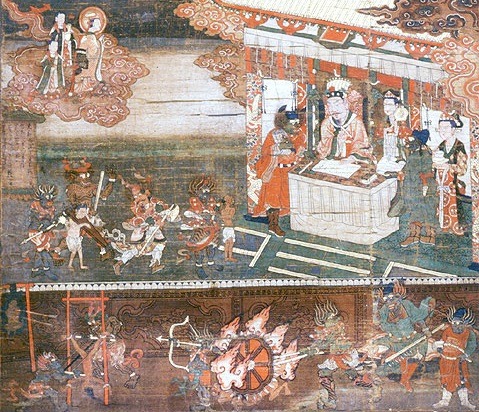
Several Zhong Kui-like clerks from a depiction of hell in Sermon on Mani's Teaching of Salvation (wikimedia commons)
According to Shih-shan Huang a single example of such a figure has even been identified in a Manichaean context, specifically in the scroll Sermon on Mani’s Teaching on Salvation.
Manichaean curiosities aside, supposedly the first person to be aided by Zhong Kui was emperor Xuanzong of Tang. At some point he fell gravely ill. In a dream, he saw a demon who attempted to steal a flute which was one of his most prized possessions. However, the attempt was foiled by a fearsome giant, who dealt with the thief rather brutally, poking out one of his eyes and then devouring him. After completing this act of demon quelling, he explained that he is Zhong Kui, and how he came to fulfill his current role.
After waking up, Xuanzong felt healthy again. He was so impressed he commissioned Wu Daozi, arguably the most famous artist in China at the time, to prepare a painting of Zhong Kui which could be used as a talisman against any further supernatural issues. Supposedly it left quite the impression on the general populace, and soon numerous images of Zhong Kui started to be distributed as talismans. There is definitely a kernel of truth to this part of the legend, as eyewitness accounts of Wu Daozi’s painting exist, but the work itself is lost.
As a side note, it’s worth pointing out the flute thief demon, despite meeting a gruesome end here, enjoyed a literary afterlife of his own. A certain Li Mingfeng (李鳴鳳), the author of a colophon on one of the earliest surviving Zhong Kui paintings, suggests that the (in)famous rebel An Lushan might have been a reincarnation of this specific entity. While I am not aware of any other attempts at providing him with a backstory, in Ming period retellings of the legend, he received a name, Xu Hao (虛耗).
Zhong Kui’s later career
Zhong Kui’s popularity grew after the Tang period, and he arguably eclipsed figures such as the fangxiang (方相) or the baize (白沢) as the demon queller par excellence. Legends about his origin and his first notable act of demon quelling which I summarized above spread far and wide during the reign of the Song dynasty.
After becoming a well defined figure, Zhong Kui came to be most commonly classified as a ghost (鬼; gui). In texts from the Song and Yuan periods he is often labeled more specifically as a “big ghost” (大鬼, dagui) or “ghost hero” (鬼雄, guixiong). However, his popularity effectively made him a god in popular imagination, and as a matter of fact he is referred to as such. His divinity is not exactly conventional, though. This topic is addressed in Fu Lu Shou Xianguan Qinghui 福祿壽仙官慶會 (The Immortal Officials of Happiness, Wealth and Longevity Gather in Celebration) by the Ming playwright Zhu Youdun (朱有燉; 1379-1435). Zhong Kui says himself that unlike his peers, he has no festival to call his own, and receives no regular offerings - and yet, he still vanquishes malicious entities on behalf of humans as long as talismans showing him continue to be distributed.
Interestingly, despite his long career in texts, no images of Zhong Kui older than the thirteenth century are known. This is mostly a matter of selective preservation, though - we know that depictions of him existed as early as in the ninth century, and that they were mass produced, presumably as woodblock prints, in the tenth. However, he didn’t necessarily look similar to his modern depictions. He actually only came to be depicted as a Tang scholar in the Song period. It seems earlier his costume might have varied.
One thing which seemingly remained consistent when it comes to Zhong Kui’s appearance is his facial hair. This feature is even emphasized in many of his epithets, such as “Old Beard” (老髯, Lao Ran), “Bearded Elder” (髯翁, Ran Wong) or “Bearded Lord” (髯君, Ran Jun). It’s possible that this was initially a way to highlight his vitality and his opposition to disease-causing demons.
Tang and Song sources indicate the state of facial hair could be viewed as an indicator of health. There’s even a handful of peculiar anecdotes about certain emperors, like Taizong of Tang or Renzong of Song, believing their facial hair has supernatural healing powers and offering ailing courtiers concoctions in which it was one of the ingredients. There’s no evidence Zhong Kui’s hair was ever believed to serve a similar purpose, though.
Not all of Zhong Kui’s titles revolve around his beard, though. An interesting example is “Nine-Headed Hermit” (九首山人). The intent isn’t to imply he has nine heads, it’s a multilayered pun instead. The character 馗 in Zhong Kui’s name is a combination of 九, “nine”, and 首, “head”. Referring to him as a “hermit”, literally “man of the mountain”, is likely supposed to show that he traverses areas traditionally believed to be inhabited by demons.

The nine-headed snake Xiangliu (wikimedia commons)
Chun-Yi Tsai suggests that this title also highlights Zhong Kui’s physical prowess by implicitly evoking “a nine-headed serpent known for its tremendous strength in Guideways through Mountains and Seas” (presumably Xiangliu).
Zhong Kui’s strength lets him punish his enemies in various unexpectedly creative ways. The earliest sources already mention he could grind vanquished demons in a mill, for instance. References to eating them are particularly common. Depending on the source, Zhong Kui might simply devour them whole, hunt and prepare them like game animals, chop them up to pickle them, mince them to prepare meat snacks, squeeze them to make juice and wine, and so on.
Such comedically gruesome descriptions are generally limited to textual sources, since violence was rarely depicted in other mediums, even in relation to military topics. Wu Daozi’s lost painting was apparently one of the exceptions, as according to a tenth century description it showed Zhong Kui gouging out the eyes of the captured demon.
Zhong Kui’s sister and other assistants
While Zhong Kui is often depicted in the company of nondescript demons, there are relatively few recurring figures associated with him. The main exception is his sister. The Song period painter Gong Kai (龔開) and his contemporary Li Mingfeng (李鳴鳳) simply refer to her as Amei (阿妹), literally “younger sister”, though here it’s apparently a personal name, following Chun-yi Tsai’s interpretation. Her origin is unknown, and she is not present in any of the early variants of the legend.

Zhong Kui Marrying Off His Sister (wikimedia commons)
Today Zhong Kui’s sister is known chiefly from works of art in various mediums which can be broadly subsumed under the label “Zhong Kui marrying off his sister” (鍾馗嫁妹, Zhong Kui jiamei) which proliferated through the Ming and Qing periods. This label is sometimes applied to earlier paintings too, for example Zhong Kui Marrying Off His Sister (鍾馗嫁妹圖, Zhong Kui jiamei tu) is the conventional modern title of a scroll attributed to the poorly known painter Yan Geng (顏庚). A colophon from the Ming period describing this work calls the figure presumed to be Zhong Kui’s sister Ayi (阿姨; an informal way to refer a maternal aunt) as opposed to Amei.
Chun-yi Tsai states it is not impossible that the woman is supposed to be Zhong Kui’s wife, rather than his sister, though. The painting can be dated to the Yuan period, and there is no evidence for the story of Zhong Kui marrying off his sister before the Ming plays - granted, it is not impossible that it was already in circulation earlier. Still, other paintings showing Zhong Kui marrying off his sister only date to the Qing period. Additionally, the procession might be a parody of paintings showing rural marriages or couples moving to a new house.
While as far as I am aware this eventually went out of fashion, in early sources Zhong Kui’s sister could be portrayed as an exorcist herself. An example can be found in one of the sermons of the Chan monk Yuanwu (圓悟; 1063–1135), in which he states that celebrations on the “Double Fifth” (端午節, duanwu jie) - the fifth day of the fifth month - involved a dance of “Zhong Kui and his little sister”. A reference to performers dressed up as the pair (as well as kings of hell, gods of soil and stove, various warrior deities and more) has alsobeen identified in an account of celebrations in Kaifeng from the end of the reign of the Northern Song dynasty.
Similar evidence can be found in art too. For example, Zheng Yuanyou (鄭元祐; 1292-1364) in a poem inspired by a painting titled Zhong Kui’s Sister (馗妹圖; as far as I am aware, this work has not been identified) states that she travels alongside her brother, that she’s armed with a sword, and that demons fear her. A related portrayal of her is known from a critical review of the works of Si Yizhen (姒頤真), a Song dynasty painter. According to Gong Kai, in one of his paintings she is shown in tattered (or unbuttoned - the term used, 披襟, can mean both) clothes, and chases away a boar attacking her brother. He was evidently not fond of this innovation, and criticizes it as “vulgar” and inappropriate.
It needs to be stressed that Gong Kai’s displeasure wasn’t necessarily tied to presenting Zhong Kui’s sister as a demon queller, though. In fact, he is actually the author of the most famous work portraying her in this role.

Gong Kai's take on Zhong Kui's sister and her attendants (wikimedia commons; cropped for the ease of viewing)
Gong Kai depicted Amei in unusual black makeup, which is also worn by female demons accompanying her (note the one carrying a kitty!). This might be a parody of the sanbai (三白; “three whites”) face painting popular in the Song period. She and her attendants wear robes decorated with depictions of the “five poisons” (五毒), a term referring to animals perceived as particularly dangerous and inauspicious. The exact list varies, though centipedes, scorpions and snakes in particular are mainstays. The five poisons are directly associated with Zhong Kui, as he can be invoked to ward them off. Direct evidence first appears in the Qing period in accounts of the well known Dragon Boat Festival, but it’s not impossible this was an earlier development.
It is presumed that Gong Kai’s painting might depict Zhong Kui and Amei looking for a demonic version of Yang Guifei, as indicated by various hints in colophons. Her portrayals in art are quite diverse, but attributing demonic traits to her would be hardly unparalleled - she could even be described as a “palace demon” (宮妖, gong yao). The decline of the Tang dynasty was blamed on her, and metaphorically she might have been invoked to criticize other people believed to improperly use the power granted to them by the imperial court.
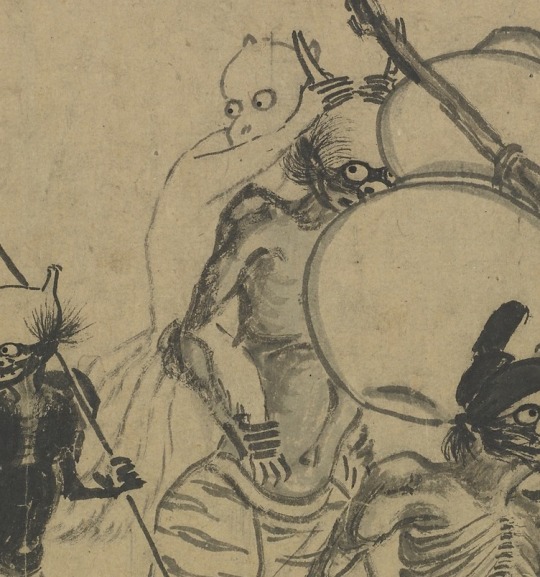
Gong Kai’s painting also depicts a less recurring member of Zhong Kui’s entourage. One of the demons carries a fox, specifically a nine-tailed specimen. The association between this animal and Zhong Kui goes all the way back to the early Tang period. In one of the Dunhuang manuscripts, the demon queller’s entourage includes a nine-tailed fox and a baize, who acted as bringers of good luck alongside him. It’s also worth pointing out that in another text from the same site, his mount during the hunt for a wangliang (魍魎; I will likely cover this entity a future article, stay tuned) is a “wild fox”.
Chun-Yi Tsai attributes the inclusion of a nine-tailed fox among Zhong Kui’s servants as a “family pet” of sorts to the portrayals of this supernatural creature both as an apotropaic antidote to poison (including the five poisons) and as a demon in its own right. It would be a suitable member of Zhong Kui’s entourage both as a conquered malevolent being and as an amplifier for his exorcistic, protective power.
A further possibility is that the association is the result of wordplay. A new year celebration involving a procession of people dressed up as members of Zhong Kui’s entourage, including his sister and various supernatural attendants, was known as dayehu (打夜胡). The homphony between 胡 and 狐, “fox”, might have resulted in the inclusion of the animal among the helpers.
Post scriptum: Zhong Kui in Japan
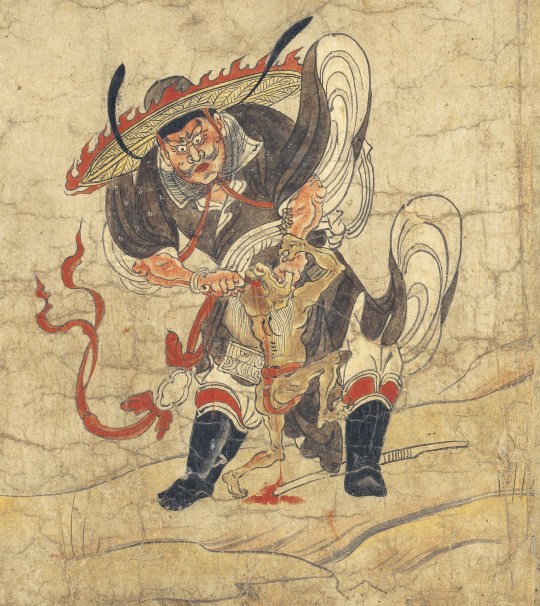
Zhong Kui, as depicted in Extermination of Evil (wikimedia commons)
Zhong Kui - or rather Shōki, following the Japanese reading of his name - probably reached Japan in the Insei period. Many other figures originating in China reached a considerable degree of popularity in Japan at roughly the same time - Taishan Fujun, Siming, Wudao Dashen, Pangu, Shennong, the examples keep piling up.
The oldest known Japanese depiction of Zhong Kui, which you can see above, is a painting from the twelfth century set known as Extermination of Evil. It might look a bit outlandish compared to most of the other depictions shown through this article, but I was able to locate a very close Chinese parallel:

A Yuan period depiction of Zhong Kui from the collection of the Beijing Library, via Richard von Glahn’s Sinister Way. Reproduced here for educational purposes only.
This is a Yuan period illustration said to be based on Wu Daozi’s painting. Zhong Kui doesn’t look like a Tang scholar yet, and the jacket and wide-brimmed hat are remarkably similar. It seems safe to assume that the Japanese painter was following a similar model - presumably one of the many now lost early depictions of Zhong Kui.
Slightly antiquated iconography surviving far away from the core area associated with a specific figure would hardly be unparalleled - it has been recently suggested that the baize/hakutaku is a similar case, with Japanese depictions and descriptions matching Tang sources fairly closely, but missing the elements which developed in the Song period or later.
For the most part, Zhong Kui fulfilled a similar role in Japan as in China: he was regarded as a fearsome demon queller, and images representing him were distributed for apotropaic purposes. However, it’s also important to note that there were certain innovations. He arrived in Japan at the brink of the middle ages - theologically speaking an era of unparalleled innovation, during which both native and imported figures were interpreted in unexpected ways, leading to the rise of a new “medieval mythology”. Zhong Kui was hardly an exception from this trend.
A “medieval myth” involving Zhong Kui is known from Hoki Naiden (ほき内伝; “Inner Tradition of the Square and the Round Offering Vessels”), an onmyōdō treatise traditionally attributed to Abe no Seimei, but most likely written by one of his descendants in the fourteenth century. Curiously, Zhong Kui’s name is written in it as 商貴 instead of the expected 鍾馗.

Tenkeisei (wikimedia commons)
In the Hoki Naiden, Zhong Kui is still a queller of malevolent supernatural beings. However, instead of being a scorned scholar, he is a yaksha who became the ruler of Rājagṛha, a city in India. He is said to correspond to both the medieval Japanese deity Gozu Tennō (牛頭天王), and to his celestial “double” Tenkeisei (天刑星; from Chinese Tianxingxing), the “star of heavenly punishment” (I covered him here). They are said to be his manifestations respectively on earth and in heaven.
This equation might seem random at first glance, but both of them actually had a lot in common with Zhong Kui: all three were believed to keep demons, especially those causing diseases, in check. Curiously, the reinterpretation of Zhong Kui as a yaksha turned king can also be found in the Genkō Shakusho (元亨釈書), a Kamakura period Buddhist history book. However, I am not aware of any studies examining it in more detail. I assume identifying him as a yaksha was a result of association with Gozu Tennō (I briefly discussed his yaksha credentials here), rather than the other way around, though.
While Hoki Naiden ultimately pertains more to medieval than modern religion, it’s worth noting that an unconventional take on Zhong Kui is still part of an extant tradition. Through history, Zhong Kui could be identified as a dōsojin (道祖神). This term denotes a class of deities meant to protect roads, crossroads and borders of villages. In parts of the Niigata prefecture this form of him is sometimes referred to as Shōki Daimyōjin (鍾馗大明神) today.
Bibliography
Joshua Capitanio, Epidemics and Plague in Premodern Chinese Buddhism
Bernard Faure, Rage and Ravage (Gods of Medieval Japan vol. 3)
Richard von Glahn, The Sinister Way: The Divine and the Demonic in Chinese Religious Culture
Shih-shan Susan Huang, Picturing the True Form. Daoist Visual Culture in Traditional China
Wilt Idema & Stephen H. West, Zhong Kui at Work: A Complete Translation of The Immortal Officials Of Happiness, Wealth, and Longevity Gather in Celebration , by Zhu Youdun (1379–1439)
Chun-Yi Joyce Tsai, Imagining the Supernatural Grotesque: Paintings of Zhong Kui and Demons in the Late Southern Song (1127-1279) and Yuan (1271-1368) Dynasties
54 notes
·
View notes
Text
A replacement for the various "recommended reading" posts from a few years ago. I'll probably keep updating it semi-regularly.
The section titles indicate what I am interested in actually discussing, to avoid further potential issues with people asking me to essentially provide them with bibliographies pertaining to topics I have no interest in discussing in depth or knowledge of or both.
I don't expect everyone who wants to send an ask to read everything here or even everything in a given section but I do recommend at least trying to find out if a question can be answered by an article or book listed here first.
40 notes
·
View notes
Text
A huge problem with Touhou-adjacent discussion of Matarajin is that people assume Matarajin is a historical outlier among Japanese deities - uniquely complex and obscure - as opposed to a median example of what theology was like in the middle ages. There are dozens of similar examples (Megumu is literally named after another lol), on top of figures from classical mythology, all the way up to Amaterasu, being reinterpreted through a similar lens.
32 notes
·
View notes
Note
Broke: Sariel is an angel so christianity is canon in Touhou
Woke: pc-98 isn't canon, Sariel doesn't exist
Bespoke: Sariel is a tengu in makai
There’s no way to make Sariel work as a tengu without making the character seem like even more of a messy product of the occult boom - and having a character named Sariel reside in makai is already basically just mashing random “esoteric” terms together at random, with all due respect for young ZUN.
However, there IS a way to make Sariel true to the actual figure without necessarily having to go through the usual arguments over implications of Christianity in Touhou. I will admit that's generally a topic I'm not a fan of; I get the impression people are more eager to discuss that than anything even vaguely Buddhism-related, which bugs me. Even the Buddhist background of multiple characters gets ignored. People do it even with Okina somehow.
Anyway, Sariel’s career arguably peaked not in any Abrahamic, let alone specifically Christian, tradition, but rather in Chinese Manichaean sources. Here the standard grouping of four archangels invariably includes Sariel (娑囉逸囉, Suoluoyiluo) alongside the strictly biblical Michael, Gabriel and Raphael. However, their role is defined in terms borrowed from Buddhism - functionally they are the Four Heavenly Kings. This label is actually applied to them outright every now and then (if you’re curious, Sariel corresponds to west and thus Virūpākṣa/Kōmokuten). A good treatment of the whole phenomenon can be found in Gábor Kósa’s article Near Eastern Angels in Chinese Manichaean Texts.
Manichaeans had a penchant for combining basically every source they stumbled upon - you won’t find any other pre-modern religion with a canon which includes Jesus, Buddha, Ahriman and Humbaba (a distant echo of Humbaba, at least) at once. It’s essentially extinct today, and for the most part has been for a millennium or so, but in some parts of China like Xiapu in Fujian it survived well into the fourteenth century (as a matter of fact, one of the Manichaean sources discussing Sariel is that late; see here; more broadly on its late survival see here). The closest thing to a surviving Manichaean temple, Cao’an, is Buddhist today. In at least one case a Manichaean painting found its way to Japan and for centuries was presumed to be a Buddhist icon; you can read the whole story here, it’s genuinely thrilling.
Sariel also has a fair share of interesting material elsewhere: Targum Neofiti assigns this name to the angel who wrestled Jacob, for example. However, I will admit the Manichaean take in my favorite.
46 notes
·
View notes
Text
I originally only checked it out for some information on Da Ji and Bixia Yuanjun but what I got was really something special, can't recommend it enough it'll completely change your perspective on foxes in east asian folklore.
The Cult of the Fox: Power, Gender, and Popular Religion in Late Imperial and Modern China by Xiaofei Kang (2006)
This book was originally recommended to me by my friend 9 while I was working on the Tsukasa post last year, and initially I only planned to take a cursory glance to perhaps find some fun trivia. However, it ended up unexpectedly engaging - much more than I expected from a dense monograph on a topic I actually didn’t have much interest in prior. I can safely say it deserves all the praise it got.
The title honestly undersells what this study is - Kang covers earlier material too. A lot of space is devoted to the Tang period in particular due to its formative role. Despite its value as a scholarly source, it’s also not inaccessible - you probably could pretty much read it as if it was a collection of anecdotes with particularly dense introductions.
Foxes were evidently seen as incredibly versatile literary characters. Divine splendor of foxes acting as attendants of deities or pursuing immortality intersects with anecdotes about beleaguered officials meeting with them in abandoned buildings to drink and discuss “historical beauties” (a subject foxes are experts in, as it turns out).
Literary fiction isn't all, though. While distinct from gods, ancestors, ghosts and so on, foxes remained a fixture of religious life, especially on the folk level. Kang actually conducted a field study to showcase modern examples in addition to historical ones. However, she makes sure to highlight official attitudes were often ambivalent - the republican and communist governments’ perception of local fox customs as superstition was not without earlier historical precedent.
What I found particularly interesting is that it would appear that the study of the perception of foxes tells us as much, if not more, about humans as it does about these animals themselves. Through history, foxes could be used to metaphorically represent virtually every possible group at the margins of society: immigrants (especially Sogdians), courtesans, officials with humble backgrounds trying to trick their way into marriage with daughters of noble families (some of them wrote stories where their fox self inserts fail at it), and more. They were the quintessential image of every type of The Other at once.
10 out of 10 stars or whatever.
41 notes
·
View notes
Text
Shikigami and onmyōdō through history: truth, fiction and everything in between
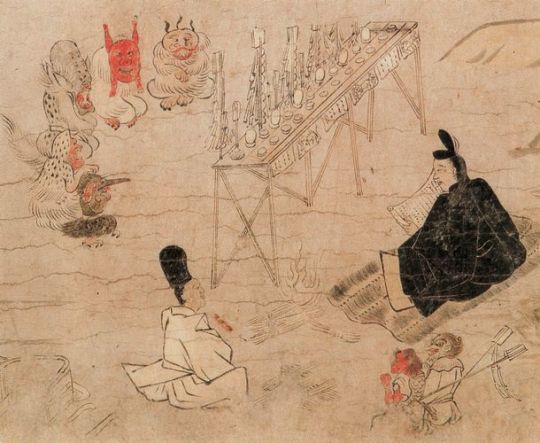
Abe no Seimei exorcising disease spirits (疫病神, yakubyōgami), as depicted in the Fudō Riyaku Engi Emaki. Two creatures who might be shikigami are visible in the bottom right corner (wikimedia commons; identification following Bernard Faure’s Rage and Ravage, pp. 57-58)
In popular culture, shikigami are basically synonymous with onmyōdō. Was this always the case, though? And what is a shikigami, anyway? These questions are surprisingly difficult to answer. I’ve been meaning to attempt to do so for a longer while, but other projects kept getting in the way. Under the cut, you will finally be able to learn all about this matter.
This isn’t just a shikigami article, though. Since historical context is a must, I also provide a brief history of onmyōdō and some of its luminaries. You will also learn if there were female onmyōji, when stars and time periods turn into deities, what onmyōdō has to do with a tale in which Zhong Kui became a king of a certain city in India - and more!
The early days of onmyōdō
In order to at least attempt to explain what the term shikigami might have originally entailed, I first need to briefly summarize the history of onmyōdō (陰陽道). This term can be translated as “way of yin and yang”, and at the core it was a Japanese adaptation of the concepts of, well, yin and yang, as well as the five elements. They reached Japan through Daoist and Buddhist sources. Daoism itself never really became a distinct religion in Japan, but onmyōdō is arguably among the most widespread adaptations of its principles in Japanese context.

Kibi no Makibi, as depicted by Yoshitoshi Tsukioka (wikimedia commons)
It’s not possible to speak of a singular founder of onmyōdō comparable to the patriarchs of Buddhist schools. Bernard Faure notes that in legends the role is sometimes assigned to Kibi no Makibi, an eighth century official who spent around 20 years in China. While he did bring many astronomical treatises with him when he returned, this is ultimately just a legend which developed long after he passed away.
In reality onmyōdō developed gradually starting with the sixth century, when Chinese methods of divination and treatises dealing with these topics first reached Japan. Early on Buddhist monks from the Korean kingdom of Baekje were the main sources of this knowledge. We know for example that the Soga clan employed such a specialist, a certain Gwalleuk (観勒; alternatively known under the Japanese reading of his name, Kanroku).
Obviously, divination was viewed as a very serious affair, so the imperial court aimed to regulate the continental techniques in some way. This was accomplished by emperor Tenmu with the formation of the onmyōryō (陰陽寮), “bureau of yin and yang” as a part of the ritsuryō system of governance. Much like in China, the need to control divination was driven by the fears that otherwise it would be used to legitimize courtly intrigues against the emperor, rebellions and other disturbances.
Officials taught and employed by onmyōryō were referred to as onmyōji (陰陽師). This term can be literally translated as “yin-yang master”. In the Nara period, they were understood essentially as a class of public servants. Their position didn’t substantially differ from that of other specialists from the onmyōryō: calendar makers, officials responsible for proper measurement of time and astrologers. The topics they dealt with evidently weren’t well known among commoners, and they were simply typical members of the literate administrative elite of their times.
Onmyōdō in the Heian period: magic, charisma and nobility
The role of onmyōji changed in the Heian period. They retained the position of official bureaucratic diviners in employ of the court, but they also acquired new duties. The distinction between them and other onmyōryō officials became blurred. Additionally their activity extended to what was collectively referred to as jujutsu (呪術), something like “magic” though this does not fully reflect the nuances of this term. They presided over rainmaking rituals, purification ceremonies, so-called “earth quelling”, and establishing complex networks of temporal and directional taboos.

A Muromachi period depiction of Abe no Seimei (wikimedia commons)
The most famous historical onmyōji like Kamo no Yasunori and his student Abe no Seimei were active at a time when this version of onmyōdō was a fully formed - though obviously still evolving - set of practices and beliefs. In a way they represented a new approach, though - one in which personal charisma seemed to matter just as much, if not more, than official position. This change was recognized as a breakthrough by at least some of their contemporaries. For example, according to the diary of Minamoto no Tsuneyori, the Sakeiki (左經記), “in Japan, the foundations of onmyōdō were laid by Yasunori”.
The changes in part reflected the fact that onmyōji started to be privately contracted for various reasons by aristocrats, in addition to serving the state. Shin’ichi Shigeta notes that it essentially turned them from civil servants into tradespeople. However, he stresses they cannot be considered clergymen: their position was more comparable to that of physicians, and there is no indication they viewed their activities as a distinct religion. Indeed, we know of multiple Heian onmyōji, like Koremune no Fumitaka or Kamo no Ieyoshi, who by their own admission were devout Buddhists who just happened to work as professional diviners.
Shin’ichi Shigeta notes is evidence that in addition to the official, state-sanctioned onmyōji, “unlicensed” onmyōji who acted and dressed like Buddhist clergy, hōshi onmyōji (法師陰陽師) existed. The best known example is Ashiya Dōman, a mainstay of Seimei legends, but others are mentioned in diaries, including the famous Pillow Book. It seems nobles particularly commonly employed them to curse rivals. This was a sphere official onmyōji abstained from due to legal regulations. Curses were effectively considered crimes, and government officials only performed apotropaic rituals meant to protect from them.
The Heian period version of onmyōdō captivated the imagination of writers and artists, and its slightly exaggerated version present in classic literature like Konjaku Monogatari is essentially what modern portrayals in fiction tend to go back to.
Medieval onmyōdō: from abstract concepts to deities

Gozu Tennō (wikimedia commons)
Further important developments occurred between the twelfth and fourteenth centuries. This period was the beginning of the Japanese “middle ages” which lasted all the way up to the establishment of the Tokugawa shogunate. The focus in onmyōdō in part shifted towards new, or at least reinvented, deities, such as calendarical spirits like Daishōgun (大将軍) and Ten’ichijin (天一神), personifications of astral bodies and concepts already crucial in earlier ceremonies. There was also an increased interest in Chinese cosmological figures like Pangu, reimagined in Japan as “king Banko”. However, the most famous example is arguably Gozu Tennō, who you might remember from my Susanoo article.
The changes in medieval onmyōdō can be described as a process of convergence with esoteric Buddhism. The points of connection were rituals focused on astral and underworld deities, such as Taizan Fukun or Shimei (Chinese Siming). Parallels can be drawn between this phenomenon and the intersection between esoteric Buddhism and some Daoist schools in Tang China. Early signs of the development of a direct connection between onmyōdō and Buddhism can already be found in sources from the Heian period, for example Kamo no Yasunori remarked that he and other onmyōji depend on the same sources to gain proper understanding of ceremonies focused on the Big Dipper as Shingon monks do.
Much of the information pertaining to the medieval form of onmyōdō is preserved in Hoki Naiden (ほき内伝; “Inner Tradition of the Square and the Round Offering Vessels”), a text which is part divination manual and part a collection of myths. According to tradition it was compiled by Abe no Seimei, though researchers generally date it to the fourteenth century. For what it’s worth, it does seem likely its author was a descendant of Seimei, though.
Outside of specialized scholarship Hoki Naiden is fairly obscure today, but it’s worth noting that it was a major part of the popular perception of onmyōdō in the Edo period. A novel whose influence is still visible in the modern image of Seimei, Abe no Seimei Monogatari (安部晴明物語), essentially revolves around it, for instance.
Onmyōdō in the Edo period: occupational licensing
Novels aside, the first post-medieval major turning point for the history of onmyōdō was the recognition of the Tsuchimikado family as its official overseers in 1683. They were by no means new to the scene - onmyōji from this family already served the Ashikaga shoguns over 250 years earlier. On top of that, they were descendants of the earlier Abe family, the onmyōji par excellence. The change was not quite the Tsuchimikado’s rise, but rather the fact the government entrusted them with essentially regulating occupational licensing for all onmyōji, even those who in earlier periods existed outside of official administration.
As a result of the new policies, various freelance practitioners could, at least in theory, obtain a permit to perform the duties of an onmyōji. However, as the influence of the Tsuchimikado expanded, they also sought to oblige various specialists who would not be considered onmyōji otherwise to purchase licenses from them. Their aim was to essentially bring all forms of divination under their control. This extended to clergy like Buddhist monks, shugenja and shrine priests on one hand, and to various performers like members of kagura troupes on the other.
Makoto Hayashi points out that while throughout history onmyōji has conventionally been considered a male occupation, it was possible for women to obtain licenses from the Tsuchimikado. Furthermore, there was no distinct term for female onmyōji, in contrast with how female counterparts of Buddhist monks, shrine priests and shugenja were referred to with different terms and had distinct roles defined by their gender.
As far as I know there’s no earlier evidence for female onmyōji, though, so it’s safe to say their emergence had a lot to do with the specifics of the new system. It seems the poems of the daughter of Kamo no Yasunori (her own name is unknown) indicate she was familiar with yin-yang theory or at least more broadly with Chinese philosophy, but that’s a topic for a separate article (stay tuned), and it's not quite the same, obviously.
The Tsuchimikado didn’t aim to create a specific ideology or systems of beliefs. Therefore, individual onmyōji - or, to be more accurate, individual people with onmyōji licenses - in theory could pursue new ideas. This in some cases lead to controversies: for instance, some of the people involved in the (in)famous 1827 Osaka trial of alleged Christians (whether this label really is applicable is a matter of heated debate) were officially licensed onmyōji. Some of them did indeed possess translated books written by Portuguese missionaries, which obviously reflected Catholic outlook. However, Bernard Faure suggests that some of the Edo period onmyōji might have pursued Portuguese sources not strictly because of an interest in Catholicism but simply to obtain another source of astronomical knowledge.
The legacy of onmyōdō
In the Meiji period, onmyōdō was banned alongside shugendō. While the latter tradition experienced a revival in the second half of the twentieth century, the former for the most part didn’t. However, that doesn’t mean the history of onmyōdō ends once and for all in the second half of the nineteenth century.
Even today in some parts of Japan there are local religious traditions which, while not identical with historical onmyōdō, retain a considerable degree of influence from it. An example often cited in scholarship is Izanagi-ryū (いざなぎ流) from the rural Monobe area in the Kōchi Prefecture. Mitsuki Ueno stresses that the occasional references to Izanagi-ryū as “modern onmyōdō” in literature from the 1990s and early 2000s are inaccurate, though. He points out they downplay the unique character of this tradition, and that it shows a variety of influences. Similar arguments have also been made regarding local traditions from the Chūgoku region.
Until relatively recently, in scholarship onmyōdō was basically ignored as superstition unworthy of serious inquiries. This changed in the final decades of the twentieth century, with growing focus on the Japanese middle ages among researchers. The first monographs on onmyōdō were published in the 1980s. While it’s not equally popular as a subject of research as esoteric Buddhism and shugendō, formerly neglected for similar reasons, it has nonetheless managed to become a mainstay of inquiries pertaining to the history of religion in Japan.
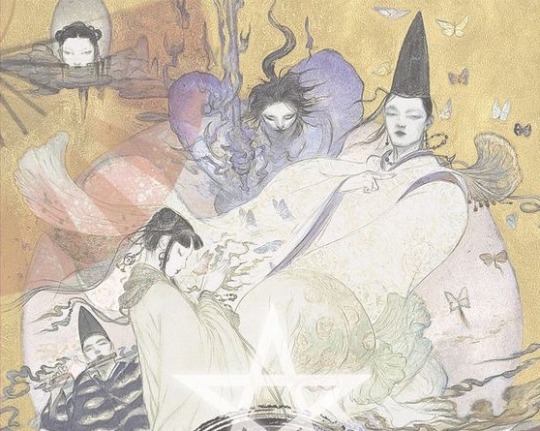
Yoshitaka Amano's illustration of Baku Yumemakura's fictionalized portrayal of Abe no Seimei (right) and other characters from his novels (reproduced here for educational purposes only)
Of course, it’s also impossible to talk about onmyōdō without mentioning the modern “onmyōdō boom”. Starting with the 1980s, onmyōdō once again became a relatively popular topic among writers. Novel series such as Baku Yumemakura’s Onmyōji, Hiroshi Aramata’s Teito Monogatari or Natsuhiko Kyōgoku’s Kyōgōkudō and their adaptations in other media once again popularized it among general audiences. Of course, since these are fantasy or mystery novels, their historical accuracy tends to vary (Yumemakura in particular is reasonably faithful to historical literature, though). Still, they have a lasting impact which would be impossible to accomplish with scholarship alone.
Shikigami: historical truth, historical fiction, or both?
You might have noticed that despite promising a history of shikigami, I haven’t used this term even once through the entire crash course in history of onmyōdō. This was a conscious choice. Shikigami do not appear in any onmyōdō texts, even though they are a mainstay of texts about onmyōdō, and especially of modern literature involving onmyōji.
It would be unfair to say shikigami and their prominence are merely a modern misconception, though. Virtually all of the famous legends about onmyōji feature shikigami, starting with the earliest examples from the eleventh century. Based on Konjaku Monogatari, there evidently was a fascination with shikigami at the time of its compilation. Fujiwara no Akihira in the Shinsarugakuki treats the control of shikigami as an essential skill of an onmyōji, alongside the abilities to “freely summon the twelve guardian deities, call thirty-six types of wild birds (...), create spells and talismans, open and close the eyes of kijin (鬼神; “demon gods”), and manipulate human souls”.
It is generally agreed that such accounts, even though they belong to the realm of literary fiction, can shed light on the nature and importance of shikigami. They ultimately reflect their historical context to some degree. Furthermore, it is not impossible that popular understanding of shikigami based on literary texts influenced genuine onmyōdō tradition. It’s worth pointing out that today legends about Abe no Seimei involving them are disseminated by two contemporary shrines dedicated to him, the Seimei Shrine (晴明神社) in Kyoto and the Abe no Seimei Shrine (安倍晴明神社) in Osaka. Interconnected networks of exchange between literature and religious practice are hardly a unique or modern phenomenon.
However, even with possible evidence from historical literature taken into account, it is not easy to define shikigami. The word itself can be written in three different ways: 式神 (or just 式), 識神 and 職神, with the first being the default option. The descriptions are even more varied, which understandably lead to the rise of numerous interpretations in modern scholarship. Carolyn Pang in her recent treatments of shikigami, which you can find in the bibliography, has recently divided them into five categories. I will follow her classification below.
Shikigami take 1: rikujin-shikisen
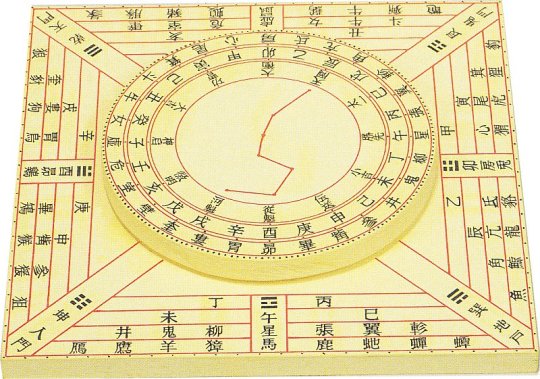
An example of shikiban, the divination board used in rikujin-shikisen (Museum of Kyoto, via onmarkproductions.com; reproduced here for educational purposes only)
A common view is that shikigami originate as a symbolic representation of the power of shikisen (式占) or more specifically rikujin-shikisen (六壬式占), the most common form of divination in onmyōdō. It developed from Chinese divination methods in the Nara period, and remained in the vogue all the way up to the sixteenth century, when it was replaced by ekisen (易占), a method derived from the Chinese Book of Changes.
Shikisen required a special divination board known as shikiban (式盤), which consists of a square base, the “earth panel” (地盤, jiban), and a rotating circle placed on top of it, the “heaven panel” (天盤, tenban). The former was marked with twelve points representing the signs of the zodiac and the latter with representations of the “twelve guardians of the months” (十二月将, jūni-gatsushō; their identity is not well defined). The heaven panel had to be rotated, and the diviner had to interpret what the resulting combination of symbols represents. Most commonly, it was treated as an indication whether an unusual phenomenon (怪/恠, ke) had positive or negative implications.
It’s worth pointing out that in the middle ages the shikiban also came to be used in some esoteric Buddhist rituals, chiefly these focused on Dakiniten, Shōten and Nyoirin Kannon. However, they were only performed between the late Heian and Muromachi periods, and relatively little is known about them. In most cases the divination board was most likely modified to reference the appropriate esoteric deities.
Shikigami take 2: cognitive abilities
While the view that shikigami represented shikisen is strengthened by the fact both terms share the kanji 式, a variant writing, 識神, lead to the development of another proposal. Since the basic meaning of 識 is “consciousness”, it is sometimes argued that shikigami were originally an “anthropomorphic realization of the active psychological or mental state”, as Caroline Pang put it - essentially, a representation of the will of an onmyōji. Most of the potential evidence in this case comes from Buddhist texts, such as Bosatsushotaikyō (菩薩処胎経).
However, Bernard Faure assumes that the writing 識神 was a secondary reinterpretation, basically a wordplay based on homonymy. He points out the Buddhist sources treat this writing of shikigami as a synonym of kushōjin (倶生神). This term can be literally translated as “deities born at the same time”. Most commonly it designates a pair of minor deities who, as their name indicates, come into existence when a person is born, and then records their deeds through their entire life. Once the time for Enma’s judgment after death comes, they present him with their compiled records. It has been argued that they essentially function like a personification of conscience.
Shikigami take 3: energy
A further speculative interpretation of shikigami in scholarship is that this term was understood as a type of energy present in objects or living beings which onmyōji were believed to be capable of drawing out and harnessing to their ends. This could be an adaptation of the Daoist notion of qi (氣). If this definition is correct, pieces of paper or wooden instruments used in purification ceremonies might be examples of objects utilized to channel shikigami.
The interpretation of shikigami as a form of energy is possibly reflected in Konjaku Monogatari in the tale The Tutelage of Abe no Seimei under Tadayuki. It revolves around Abe no Seimei’s visit to the house of the Buddhist monk Kuwanten from Hirosawa. Another of his guests asks Seimei if he is capable of killing a person with his powers, and if he possesses shikigami. He affirms that this is possible, but makes it clear that it is not an easy task. Since the guests keep urging him to demonstrate nonetheless, he promptly demonstrates it using a blade of grass. Once it falls on a frog, the animal is instantly crushed to death. From the same tale we learn that Seimei’s control over shikigami also let him remotely close the doors and shutters in his house while nobody was inside.
Shikigami take 4: curse
As I already mentioned, arts which can be broadly described as magic - like the already mentioned jujutsu or juhō (呪法, “magic rituals”) - were regarded as a core part of onmyōji’s repertoire from the Heian period onward. On top of that, the unlicensed onmyōji were almost exclusively associated with curses. Therefore, it probably won’t surprise you to learn that yet another theory suggests shikigami is simply a term for spells, curses or both. A possible example can be found in Konjaku Monogatari, in the tale Seimei sealing the young Archivist Minor Captains curse - the eponymous curse, which Seimei overcomes with protective rituals, is described as a shikigami.

Kunisuda Utagawa's illustration of an actor portraying Dōman in a kabuki play (wikimedia commons)
Similarities between certain descriptions of shikigami and practices such as fuko (巫蠱) and goraihō (五雷法) have been pointed out. Both of these originate in China. Fuko is the use of poisonous, venomous or otherwise negatively perceived animals to create curses, typically by putting them in jars, while goraihō is the Japanese version of Daoist spells meant to control supernatural beings, typically ghosts or foxes. It’s worth noting that a legend according to which Dōman cursed Fujiwara no Michinaga on behalf of lord Horikawa (Fujiwara no Kanemichi) involves him placing the curse - which is itself not described in detail - inside a jar.
Mitsuki Ueno notes that in the Kōchi Prefecture the phrase shiki wo utsu, “to strike with a shiki”, is still used to refer to cursing someone. However, shiki does not necessarily refer to shikigami in this context, but rather to a related but distinct concept - more on that later.
Shikigami take 5: supernatural being
While all four definitions I went through have their proponents, yet another option is by far the most common - the notion of shikigami being supernatural beings controlled by an onmyōji. This is essentially the standard understanding of the term today among general audiences. Sometimes attempts are made to identify it with a specific category of supernatural beings, like spirits (精霊, seirei), kijin or lesser deities (下級神, kakyū shin). However, none of these gained universal support. Generally speaking, there is no strong indication that shikigami were necessarily imagined as individualized beings with distinct traits.
The notion of shikigami being supernatural beings is not just a modern interpretation, though, for the sake of clarity. An early example where the term is unambiguously used this way is a tale from Ōkagami in which Seimei sends a nondescript shikigami to gather information. The entity, who is not described in detail, possesses supernatural skills, but simultaneously still needs to open doors and physically travel.
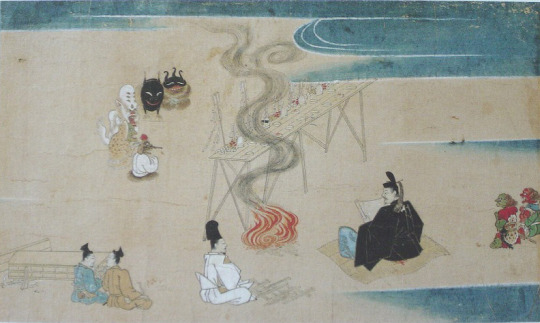
An illustration from Nakifudō Engi Emaki (wikimedia commons)
In Genpei Jōsuiki there is a reference to Seimei’s shikigami having a terrifying appearance which unnerved his wife so much he had to order the entities to hide under a bride instead of residing in his house. Carolyn Pang suggests that this reflects the demon-like depictions from works such as Abe no Seimei-kō Gazō (安倍晴明公画像; you can see it in the Heian section), Fudōriyaku Engi Emaki and Nakifudō Engi Emaki.
Shikigami and related concepts
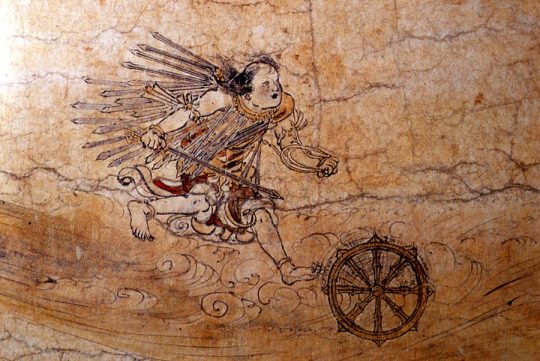
A gohō dōji, as depicted in the Shigisan Engi Emaki (wikimedia commons)
The understanding of shikigami as a “spirit servant” of sorts can be compared with the Buddhist concept of minor protective deities, gohō dōji (護法童子; literally “dharma-protecting lads”). These in turn were just one example of the broad category of gohō (護法), which could be applied to virtually any deity with protective qualities, like the historical Buddha’s defender Vajrapāṇi or the Four Heavenly Kings.
A notable difference between shikigami and gohō is the fact that the former generally required active summoning - through chanting spells and using mudras - while the latter manifested on their own in order to protect the pious. Granted, there are exceptions. There is a well attested legend according to which Abe no Seimei’s shikigami continued to protect his residence on own accord even after he passed away. Shikigami acting on their own are also mentioned in Zoku Kojidan (続古事談). It attributes the political downfall of Minamoto no Takaakira (源高明; 914–98) to his encounter with two shikigami who were left behind after the onmyōji who originally summoned them forgot about them.
A degree of overlap between various classes of supernatural helpers is evident in texts which refer to specific Buddhist figures as shikigami. I already brought up the case of the kushōjin earlier. Another good example is the Tendai monk Kōshū’s (光宗; 1276–1350) description of Oto Gohō (乙護法). He is “a shikigami that follows us like the shadow follows the body. Day or night, he never withdraws; he is the shikigami that protects us” (translation by Bernard Faure). This description is essentially a reversal of the relatively common title “demon who constantly follow beings” (常随魔, jōzuima). It was applied to figures such as Kōjin, Shōten or Matarajin, who were constantly waiting for a chance to obstruct rebirth in a pure land if not placated properly.

The Twelve Heavenly Generals (Tokyo National Museum, via wikimedia commons)
A well attested group of gohō, the Twelve Heavenly Generals (十二神将, jūni shinshō), and especially their leader Konpira (who you might remember from my previous article), could be labeled as shikigami. However, Fujiwara no Akihira’s description of onmyōji skills evidently presents them as two distinct classes of beings.

A kuda-gitsune, as depicted in Shōzan Chomon Kishū by Miyoshi Shōzan (Waseda University History Museum; reproduced here for educational purposes only)
Granted, Akihira also makes it clear that controlling shikigami and animals are two separate skills. Meanwhile, there is evidence that in some cases animal familiars, especially kuda-gitsune used by iizuna (a term referring to shugenja associated with the cult of, nomen omen, Iizuna Gongen, though more broadly also something along the lines of “sorcerer”), were perceived as shikigami.
Beliefs pertaining to gohō dōji and shikigami seemingly merged in Izanagi-ryū, which lead to the rise of the notion of shikiōji (式王子; ōji, literally “prince”, can be another term for gohō dōji). This term refers to supernatural beings summoned by a ritual specialist (祈祷師, kitōshi) using a special formula from doctrinal texts (法文, hōmon). They can fulfill various functions, though most commonly they are invoked to protect a person, to remove supernatural sources of diseases, to counter the influence of another shikiōji or in relation to curses.
Tenkeisei, the god of shikigami
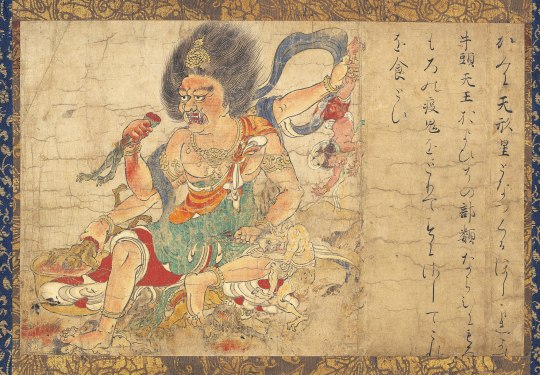
Tenkeisei (wikimedia commons)
The final matter which warrants some discussion is the unusual tradition regarding the origin of shikigami which revolves around a deity associated with this concept.
In the middle ages, a belief that there were exactly eighty four thousand shikigami developed. Their source was the god Tenkeisei (天刑星; also known as Tengyōshō). His name is the Japanese reading of Chinese Tianxingxing. It can be translated as “star of heavenly punishment”. This name fairly accurately explains his character. He was regarded as one of the so-called “baleful stars” (凶星, xiong xing) capable of controlling destiny. The “punishment” his name refers to is his treatment of disease demons (疫鬼, ekiki). However, he could punish humans too if not worshiped properly.
Today Tenkeisei is best known as one of the deities depicted in a series of paintings known as Extermination of Evil, dated to the end of the twelfth century. He has the appearance of a fairly standard multi-armed Buddhist deity. The anonymous painter added a darkly humorous touch by depicting him right as he dips one of the defeated demons in vinegar before eating him. Curiously, his adversaries are said to be Gozu Tennō and his retinue in the accompanying text. This, as you will quickly learn, is a rather unusual portrayal of the relationship between these two deities.
I’m actually not aware of any other depictions of Tenkeisei than the painting you can see above. Katja Triplett notes that onmyōdō rituals associated with him were likely surrounded by an aura of secrecy, and as a result most depictions of him were likely lost or destroyed. At the same time, it seems Tenkeisei enjoyed considerable popularity through the Kamakura period. This is not actually paradoxical when you take the historical context into account: as I outlined in my recent Amaterasu article, certain categories of knowledge were labeled as secret not to make their dissemination forbidden, but to imbue them with more meaning and value.
Numerous talismans inscribed with Tenkeisei’s name are known. Furthermore, manuals of rituals focused on him have been discovered. The best known of them, Tenkeisei-hō (天刑星法; “Tenkeisei rituals”), focuses on an abisha (阿尾捨, from Sanskrit āveśa), a ritual involving possession by the invoked deity. According to a legend was transmitted by Kibi no Makibi and Kamo no Yasunori. The historicity of this claim is doubtful, though: the legend has Kamo no Yasunori visit China, which he never did. Most likely mentioning him and Makibi was just a way to provide the text with additional legitimacy.
Other examples of similar Tenkeisei manuals include Tenkeisei Gyōhō (天刑星行法; “Methods of Tenkeisei Practice”) and Tenkeisei Gyōhō Shidai (天刑星行法次第; “Methods of Procedure for the Tenkeisei Practice”). Copies of these texts have been preserved in the Shingon temple Kōzan-ji.
The Hoki Naiden also mentions Tenkeisei. It equates him with Gozu Tennō, and explains both of these names refer to the same deity, Shōki (商貴), respectively in heaven and on earth. While Shōki is an adaptation of the famous Zhong Kui, it needs to be pointed out that here he is described not as a Tang period physician but as an ancient king of Rajgir in India. Furthermore, he is a yaksha, not a human. This fairly unique reinterpretation is also known from the historical treatise Genkō Shakusho.
Post scriptum
The goal of this article was never to define shikigami. In the light of modern scholarship, it’s basically impossible to provide a single definition in the first place. My aim was different: to illustrate that context is vital when it comes to understanding obscure historical terms. Through history, shikigami evidently meant slightly different things to different people, as reflected in literature. However, this meaning was nonetheless consistently rooted in the evolving perception of onmyōdō - and its internal changes. In other words, it reflected a world which was fundamentally alive.
The popular image of Japanese culture and religion is often that of an artificial, unchanging landscape straight from the “age of the gods”, largely invented in the nineteenth century or later to further less than noble goals. The case of shikigami proves it doesn’t need to be, though. The malleable, ever-changing image of shikigami, which remained a subject of popular speculation for centuries before reemerging in a similar role in modern times, proves that the more complex reality isn’t necessarily any less interesting to new audiences.
Bibliography
Bernard Faure, A Religion in Search of a Founder?
Idem, Rage and Ravage (Gods of Medieval Japan vol. 3)
Makoto Hayashi, The Female Christian Yin-Yang Master
Jun’ichi Koike, Onmyōdō and Folkloric Culture: Three Perspectives for the Development of Research
Irene H. Lin, Child Guardian Spirits (Gohō Dōji) in the Medieval Japanese Imaginaire
Yoshifumi Nishioka, Aspects of Shikiban-Based Mikkyō Rituals
Herman Ooms, Yin-Yang's Changing Clientele, 600-800 (note there is n apparent mistake in one of the footnotes, I'm pretty sure the author wanted to write Mesopotamian astronomy originated 4000 years ago, not 4 millenia BCE as he did; the latter date makes little sense)
Carolyn Pang, Spirit Servant: Narratives of Shikigami and Onmyōdō Developments
Idem, Uncovering Shikigami. The Search for the Spirit Servant of Onmyōdō
Shin’ichi Shigeta, Onmyōdō and the Aristocratic Culture of Everyday Life in Heian Japan
Idem, A Portrait of Abe no Seimei
Katja Triplett, Putting a Face on the Pathogen and Its Nemesis. Images of Tenkeisei and Gozutennō, Epidemic-Related Demons and Gods in Medieval Japan
Mitsuki Umeno, The Origins of the Izanagi-ryū Ritual Techniques: On the Basis of the Izanagi saimon
Katsuaki Yamashita, The Characteristics of On'yōdō and Related Texts
117 notes
·
View notes
Text
"Tenma, boss of the tengu". Exploring the "heavenly demon(s)"

The identity of Tenma, the leader of tengu in Touhou, remains a mystery. I think only ZUN can solve it - if he ever chooses to, obviously. Therefore, this is not quite an article meant to prove I figured out who Tenma is. Instead, it presents the origin of this name, and introduces a handful of figures in various contexts portrayed as leaders of the tengu who I think would be interesting candidates for the position of Tenma.
My additional goal is to show that even though popculture tends to portray all tengu as basically interchangeable, there is actually a fair share of unique tales about specific named members of this category. Corrupt monks! Vengeful spirits! Visitors from far off lands! There’s even a sea monster converted to Buddhism! Obviously, this isn’t supposed to be a list of every single named tengu and every single story. It’s not even a list of all of my favorite tengu. It’s simply an attempt at convincing you that digging deeper into tengu background is worth it - and in particular that there is still a lot to speculate about when it comes to their leader in Touhou. It’s some of the best oc free real estate in the series, really.
Due to technical difficulties, the bibliography is included as a Google Docs link rather than a part of the article. I'm sorry.
From Mara to tengu: the development of the concept of tenma
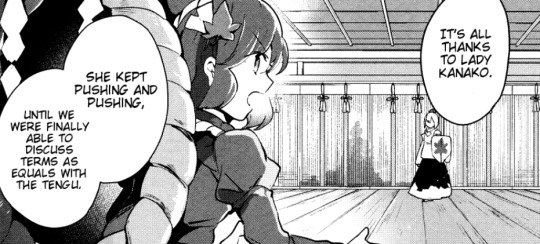
Silhouette of a tengu negotiating with Kanako in WaHH 38, sometimes labeled as Tenma on fan sites through debatable exegesis.
As we originally learned in Perfect Memento in Strict Sense, Gensokyo’s tengu are ruled by an individual named Tenma (天魔). Akyuu simply describes them as the “tengu’s boss” and provides no further information. While some additional tidbits have since surfaced here and there, they largely remain a mystery. Next to Chang’e, the unseen fourth deva of the mountain and the fourth Beast Realm figurehead they’re easily the highest profile unseen character in the entire series.
While in absence of information on the contrary we cannot necessarily assume that Tenma isn’t a given name in Touhou, ZUN did not actually come up with this term. It has been a significant part of tengu background at least since the Kamakura period. It can be translated as “heavenly demon”, and it’s a shortened form of Dairokuten Maō (第六天魔王), “Demon King of Sixth Heaven”, the Japanese name of Mara. Tenma is explained as a synonym of Mara’s “personal name” Hajun (波旬; Sanskrit Pāpīyas) for instance in the treatise Makashikan (摩訶止観; translation of Chinese Móhē Zhǐguān, “Great Cessation and Insight”).
Is that all there is to the mystery of Tenma? For what it’s worth, a possible reference to the full form of Mara’s name can be found in a description of Okina’s ability card in Unconnected Marketeers, which mentions “Tenma living in paradise”. I don’t think this is very strong evidence, though.
Touhou aside, it is hard to deny tengu are fundamentally tied to Mara. They are directly described as his subjects in Buddhist works such as Soseki Musō’s (1275–1351) Muchū mondō (夢中問答集; “Questions and Answers in Dreams”) and Unshō’s (運敞; 1614–1693) Jakushōdō Kokkyōshū (寂照堂谷響集). However, it needs to be stressed that a being referred to as Tenma necessarily has to be Mara himself.
A plurality of Maras theoretically became possible as soon as the belief this name didn’t designate an individual, but rather a position which could be held by various individuals or a category of beings developed in Buddhism. The former idea already appears in the Māratajjanīya, a part of the Theravada Buddhist Majjhima Nikāya, dated to the late first millennium BCE or early first millennium CE. Maudgalyāyana, one of the disciples of the historical Buddha, reveals in it that he was (a) Mara in a past life, and thus can easily notice the presence of the present Mara. The shift from a singular Mara (魔, mo) to an assortment of “demon kings” (魔王, mowang) is also well documented in early Buddhist sources from China.
As a curiosity it’s worth noting that even though the terms mo and mowang originally referred to strictly Buddhist demons, they were also incorporated into Daoist traditions, especially Lingbao and Shangqing. For example the former school's central text Duren Jing (度人經; “Scripture for Universal Salvation”) maintains that multiple mowang exist.
While some of these “demon kings” are tempters not too dissimilar from their Buddhist forerunner (though what they obstruct is attaining the distinctly Daoist form of transcendence - in other words, immortality), others are portrayed as judges responsible for determining the fates of people in the afterlife. In later sources the term mo is sometimes refers to supernatural pathogens (generally 邪, xie or 邪氣, xiequi).

Sun Wukong and his fellow pilgrims battling the Bull Demon King on a mural from the Summer Palace in Beijing (wikimedia commons)
You don’t really need to look for any particularly obscure sources to see this transformation of Mara into a generic moniker, though - even the Bull Demon King from Journey to the West has the compound 魔王 in his name. Same goes for numerous other antagonists from this work.
When it comes to Japanese sources, it also doesn’t require looking for anything particularly obscure to find evidence in the belief in multiplicity of ma or tenma.
In the historical epic Heike Monogatari, emperor Go-Shirakawa implores Sumiyoshi Daimyōjin to explain the nature of tenma to him. He reveals that this term refers to monks and scholars who, despite nominally following Buddhism, lacked the mindset needed to attain enlightenment. He compares them to birds of prey, but also states they belong to the “dog species”. All of these are nods to well established beliefs about tengu, which I discussed in my previous article, with a reference to the writing of their name on top of that.
It comes as no surprise that right after that Sumiyoshi Daimyōjin specifies that “the wise men of the eight sects who become tenma are called tengu”. He also makes it clear the tenma are quite numerous: “nine out of ten will definitely become tenma and try to destroy the Law of Buddha,” he warns.
A plurality of tenma can also be found in assorted biographies of pious Buddhist reborn in a pure land, so-called ōjōden (往生伝). The Tendai treatise Asabashō (阿娑縛抄) attributes the ability to “subdue all tenma” - evidently a class of beings, not an individual - to Fudō Myōō.
Through the rest of the article, I will introduce some of these tenma - the most famous tengu. My goal is not to convince you that any of them is a uniquely plausible candidate for the role of the unseen Touhou Tenma - I merely would like to point out there are multiple interesting options.
The oneness of vice and virtue: Ryōgen, the ruler of Makai
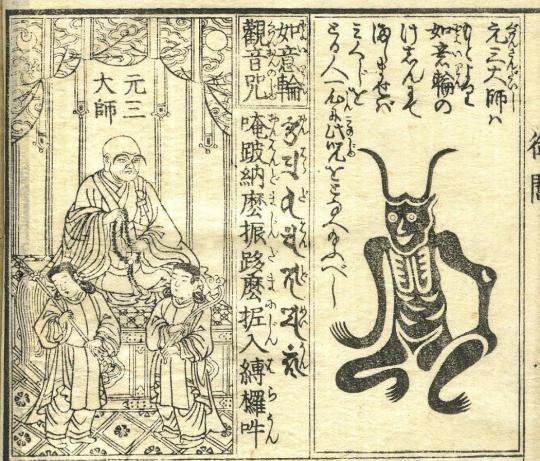
The historical Ryōgen (left) and his deomic alter ego Tsuno Daishi (wikimedia commons)
Before Ryōgen (912–985) came to be seen as a tengu, he was one of the most influential members of the Tendai school of Buddhism to ever live. He reformed the Enryaku-ji complex on Mt. Hiei, took part in numerous theological debates, and gained the favor of the imperial court by supposedly enabling the birth of an heir of emperor Murakami with his prayers. He was also renowned as a master of esoteric protective rituals.
The proponents of the Tendai establishment understood him as a fearsome protector of this tradition. As early as 50 years after his death, in the 1030s, he came to be identified as the reincarnation of Tendai’s founder Saichō. He was also considered a manifestation of one of the eight dragon kings, Uhatsura (優鉢羅; from Sanskrit Utpalaka). Ōe no Masafusa states that in this form he continued to protect Mt. Hiei, instead of being reborn in a pure land. This idea continued to spread, and by the end of the Kamakura period he came to be commonly revered as a protective figure by all strata of society. Haruko Wakabayashi notes that only Kūkai developed a similar cult in Japan as far as patriarchs of the esoteric Buddhist schools go.
It was not Ryōgen’s ability to navigate complex doctrinal debates about the interpretation of sutras that resulted in his popularity, but rather his esoteric skills. He was supposedly uniquely accomplished when it came to subduing anything which could be described as ma. In a Konjaku Monogatari tale I’ll discuss in more detail later, he is portrayed effortlessly overcoming a tengu, for instance.
However, in addition to spiritual obstacles and demons, the ma he was supposed to conquer also included political opponents, rebels or brigands, as the Buddhist law and the interests of the state were understood as identical. Ryōgen’s efficiency was so great he came to be viewed as a manifestation of Fudo Myōō, one of the wisdom kings and the conqueror of ma par excellence.
Not everyone viewed Ryōgen positively, though. The earliest criticism came from his contemporaries. It was argued that he favored monks from aristocratic families, and that he lived in luxury unbefitting for a monk. Furthermore, numerous conflicts between monks erupted during his tenure as Enryakuji’s abbot, including the split between the Sanmon and Jimon lineages. Since in some cases this led to armed confrontations, later on he was blamed for essentially enabling the rise of militarized monks who commonly caused disturbances on Mt. Hiei.
The real breakthroughs were not these tangible “political” criticisms. Rather, it was the identification of Ryōgen as ma, which arose due to conflict between various schools of Buddhism in the early middle ages. Most commonly this meant portraying him as a tengu - as I explained in my previous article, the form arrogant or corrupt monks were believed to take. A variant tradition described him as an oni, though according to Bernard Faure this likely simply reflects a degree of interchangeability between them and tengu.
Ryōgen is arguably the most famous historical monk to be furnished with such a literary afterlife. An early example can be found in the Hōbutsushū from the twelfth century, which states that this was a result of his attachment to Enryaku-ji. In Jimon Kōsōki (寺門高僧記) it is instead his investment in doctrinal debates that made him unable to attain rebirth in a pure land.

A gathering of tengu leaders from Tengu Zōshi (wikimedia commons)
Since Ryōgen was no ordinary monk, his tengu self also had to be special. In the Tengu Zōshi (天狗草紙), he is described as the ruler of all tengu and the realm they inhabit, Makai (“world of ma”; also referred to as Tengudō). It's worth pointing out the notion of Makai being a place where monks turn into specific classes of supernatural beings is basically a core part of UFO’s plot, and in SoPM Miko even wonders if Byakuren shouldn’t be considered a tengu.
As a ruler of Makai, Ryōgen came to be referred to as a “demon king”, maō (魔王). An example can be found in the historical epic Taiheiki, where he is described as one of the “great demon kings” (大魔王, daimaō) who debate how to cause chaos in Japan. He is assisted by vengeful spirits of the emperors Sutoku (more on him later), Go-Toba and Go-Daigo; two members of the Minamoto clan who sided with Sutoku, Tameyoshi and Tametomo; and the monks Genbō, Shinzei (真済, 800-860; obscure today, but apparently well known as a monk turned tengu in the middle ages) and Raigō (who supposedly turned into the infamous “iron rat”).
In Hirasan Kojin Reitaku (比良山古人霊託; “The Spiritual Oracle of the Old Man of Mount Hira”) this is only a temporary fate, though: supposed by the time this work was compiled, he already managed to leave Tengudō. As I discussed last month, this reflects a fairly standard belief too: to become a tengu, one had to actually be a Buddhist, and while it made striving for enlightenment more difficult, it did not mean eternal damnation or anything of that sort. A tengu could still choose to pursue rebirth in a pure land - it was just more difficult than for a human.
The evolution of Ryōgen’s image didn’t end with the establishment of his new role as a king of tengu, or even with the arguments that he might have nonetheless subsequently attained enlightenment. By the end of the Kamakura period, he came to be worshiped explicitly in the form of a “demon king”. While initially polemical, this image of him came to be subverted by Tendai monks to their own ends. They asserted that Ryōgen did not enter the realm of ma because of his arrogance, but rather consciously chose to do so in order to protect Buddhist principles. By becoming the ruler of its inhabitants, he also became their ultimate conqueror.
The notion of a being who is simultaneously essentially Mara-like and a protector of Buddhism seems contradictory. That’s actually the intent here. Through the middle ages, the esoteric schools of Buddhism developed the notion of hongaku, or “original enlightenment”. In its light, opposites were in fact identical. Buddha was the same as Mara (魔仏一如, mabutsu ichinyo). As it was argued, to attain Buddha nature one had to understand and experience delusion as well. Thus virtuous individuals could become demon kings in order to freely control evil beings.
In addition to its deep philosophical implications, the hongaku theory was also used to reject criticisms of the Buddhist establishment. Enjoying luxuries was but a way to better understand delusion, and thus to advance along the path to enlightenment. Its proponents embraced some criticisms of Ryōgen: he did favor nobles, accumulate wealth and live arrogantly. He did become a powerful tengu. But all of this was in fact part of a noble goal. And on top of that, as a demon king he was an even more fearsome protector of Tendai than he would be otherwise.

"Tsuno Daishi and a snail" by Teisai Hokuba (Sumida Hokusai Museum; reproduced here for educational purposes only)
The new role of Ryōgen warranted new iconography. While formerly portrayed simply as a monk holding the expected priestly attributes, in the Kamakura period he came to be depicted as Tsuno Daishi (角大師), the “Horned Master”. This image spread far and wide due to the development of a belief that hanging depictions of Ryōgen would guarantee the same protection Tendai institutions received from him. He came to be seen as particularly efficient in warding off disease.
Many temples still distribute talismans depicting Tsuno Daishi today. This custom received a lot of press coverage in the early months of the COVID pandemic, and you might have seen some examples on social media.
From vengeful spirit to tengu: the case of emperor Sutoku

Sutoku, as depicted by Yoshitoshi Mori (Tokyo's National Museum of Modern Art; reproduced here for educational purposes only)
Sutoku has much in common with Ryōgen - he was also a historical figure who purportedly became a tengu. However, he was not a monk, but rather an emperor. He reigned from 1123 to 1142, when he was forced to abdicate in favor of his half brother Konoe.
Konoe passed away in 1155, but Sutoku was not allowed to return to the throne. It was instead claimed by another half brother, Go-Shirakawa. Sutoku decided that’s enough half brothers seizing a position he believed was still rightfully his, and plotted an uprising. This culminated in the Hōgen Disturbance of 1156. Alas, planning seemingly wasn’t his strong suit, since the conflict was essentially resolved before it even started. Go-Shirakawa’s forces defeated Sutoku’s before they even left their encampment.

Sutoku as a vengeful spirit, as depicted by Kuniyoshi Utagawa (wikimedia commons)
In the aftermath of his failed rebellion, Sutoku was exiled to Sanuki, where he eventually passed away in 1164. However, his memory lingered on. He most likely came to be widely perceived as a vengeful spirit after the great fire of Angen broke out in Kyoto in 1177. Other subsequent disasters, including the Genpei war (1180-1185) and the 1181 famine, strengthened the belief that he was punishing his enemies from behind the grave. However, he didn’t become just any vengeful ghost, but one of the three greatest members of this category ever, next to Sugawara no Michizane and Taira no Masakado.
Sutoku was, in a way, the sum of many of the greatest fears of medieval Japan. The belief in his rebirth as a vengeful ghost coexisted with a tradition presenting him as a tengu - arguably one of the greatest tengu ever. This status is firmly ingrained into his image in later sources.Today he is frequently included in modern groupings of “three great youkai” alongside Shuten Dōji and Tamamo no Mae. It seems sometimes he’s replaced by Kidōmaru, but honestly I think he is more worthy of this spot, and also even though this is ultimately a synthetic modern group, it’s much more representative of medieval culture to have a tengu alongside an oni and a fox.

A strikingly tengu-like vengeful Sutoku, as depicted by Yoshitsuya Utagawa (wikimedia commons)
While peculiar, Sutoku’s dual role as a tengu and a vengeful spirit is not entirely unique. Initially these two categories were pretty firmly separate. Tengu obstructed attaining enlightenment and rebirth in a pure land; vengeful ghosts, as their name indicates, were focused on personal vengeance. However, in popular imagination they evidently overlapped, as evident for example in members of both groups scheming together in the Taiheiki. This most likely reflects the overlap between the perception of enemies of Buddhism and enemies of the state. Vengeful ghosts were typically members of factions who lost one political struggle or another, and their vengeance was aimed at the establishment.
Regardless of Sutoku’s supernatural taxonomic position, his post-mortem fate is tied to the fact he was a devout Buddhist. All accounts of his exile stress that he spent much of his time copying sutras. According to a rumor first attested in 1183, he also wrote a curse on their backs using his own blood, vowing to become a “demon king” - (a) Mara - due to perceived injustice he faced. There is no evidence it’s based on a historical event, even though it’s not impossible Go-Shirakawa did believe in it. At the very least, he definitely saw the deceased Sutoku as a supernatural threat, as he had various ceremonies performed in hopes of pacifying him.
Hōgen Monogatari, composed in the early fourteenth century, asserts that he became a tengu while he was still alive. When his request to deposit the completed manuscripts in a temple in Kyoto was denied by Go-Shirakawa, he vowed to remain his enemy in future lives, and stopped cutting his nails and hair. This symbolically marked his transformation. However, a former emperor couldn’t just become any tengu. Therefore, for instance in the Taiheiki he is described as a leader of the tengu, and his bird form is that of a golden kite.
Up to 2022, the Touhou wiki used to claim that “among Touhou fans, it is almost a general idea that the Tenma is inspired by Grand Emperor Sutoku” (not sure what is the “grand” doing here, there’s no such a title as daitennō as far as I am aware, but I digress), as you can see here. I will admit I’ve never encountered this headcanon - you will generally be hard pressed to find Touhou headcanons relying on actual mythology that aren’t just some variety of power level wank or otherwise all around awkward - so I think removing it was the right move (I don’t think the replacement is any better considering Mara is not a “Hindi god” - Hindi is a language, not a religion - but that’s another problem).
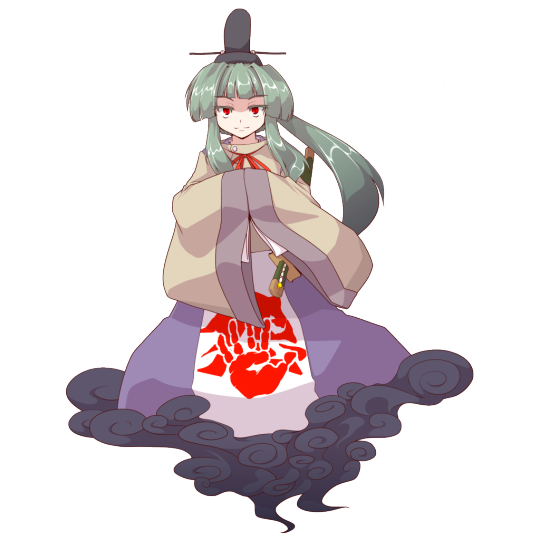
I’m also not aware of any Sutoku fan characters save for Tenmu Sutokuin from the fangame Mystical Power Plant who isn’t even supposed to be a take on the canon Tenma. Design-wise she very clearly leans more into the vengeful spirit side of things in my opinion to the point the design would work better as Michizane than Sutoku, really, though I don’t dislike it. The filename on the wiki misspells her name as Tenma, but I have no clue whether this has anything to do with the strange headcanon assertion from the Tenma article. The closest thing to a Tenma reference she gets is a spell card referencing the sixth heaven, but the game refers to her merely as a “great tengu”.
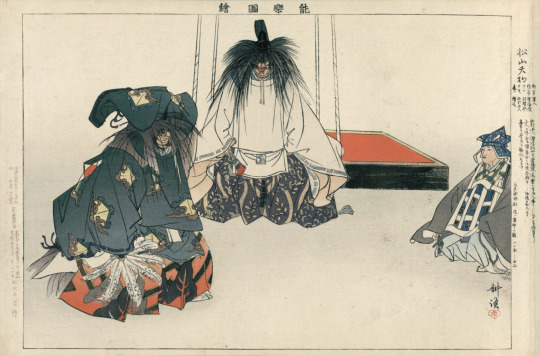
Kōgyo Tsukioka's illustration of a performance of Matsuyama Tengu, with actors playing Saigyō, Sutoku and another tengu (wikimedia commons)
MPP aside, there's a lot of room for Sutoku in Touhou. The poet-monk Saigyō, whose life and works served as a loose inspiration for the plot of Perfect Cherry Blossom and Yuyuko’s character, went on a journey through locations associated with the late ex-emperor four years after his death, in 1168. He felt a personal connection to him because before being ordained he served as a guard of the imperial palace during his reign. This unconventional pilgrimage to at the time peripheral, sparsely inhabited areas was both a form of paying respect to his former superior, and possibly a way to pacify his vengeful spirit.
Saigyō obviously did not meet the deceased Sutoku, and ultimately only two of his poems deal with his downfall. However, later legends kept expanding upon their connection. This eventually culminated in the development of a tale according to which the monk in fact encountered Sutoku in the form of either a vengeful spirit or a tengu. The noh play Matsuyama Tengu is based on it. Its title is derived from the name Sutoku’s first residence after his exile. As a curiosity it’s worth pointing out the play singles out Sagamibō (相模坊), the tengu of Mt. Shiramine, as an ally of Sutoku - an ideal candidate for a stage 5 sidekick, if you ask me.
Some further interesting developments regarding Sutoku’s tengu identity took place in the Edo period, but I’ll discuss them in a separate section later.
The other tengu emperor: Go-Shirakawa
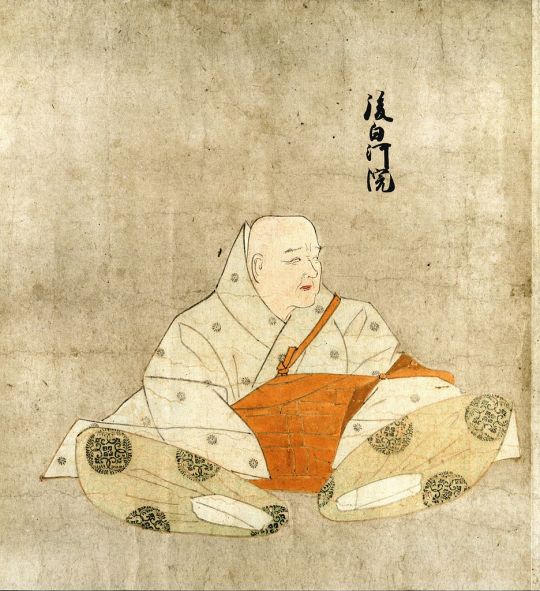
A portrait of Go-Shirakawa (wikimedia commons)
While Sutoku’s opposition to Go-Shirakawa essentially was the first step to the development of the belief he was a tengu, the latter also came to be viewed as a member of this category. While still alive, no less. One of the first sources to identify him as a tengu is a letter of his contemporary Minamoto no Yoritomo. He refers to the emperor as the “greatest tengu of all Japan” because of his notoriously fickle political positions. He at one point approved Minamoto no Yoshitsune’s plan to suppress Yoritomo, just to reverse this decision and declare Yoshitsune is acting on behalf of a tenma.
The notion of Go-Shirakawa being a tengu is present in the Heike Monogatari as well. In the scene I already mentioned, Sumiyoshi informs Go-Shirakawa that extensively studying Buddhist texts made him arrogant, and that he’s already attracting the attention of tengu. It is just a matter of time until he will be reborn as one of them himself. Stressing his religiosity is meant to show how it is possible for him to become a tengu in the same manner as monks.
Go-Shirakawa’s tengu career arguably peaked with his portrayal in Hirasan Kojin Reitaku. It states that both him and Sutoku became tengu, but it is the former whose “power is beyond comparison”. However, he plays no bigger role in the narrative, and he’s not described as a leader of the tengu, or even as the most powerful of them. In the absence of Ryōgen, it is apparently his contemporary Yokei (余慶; 919-991) who became the most powerful tengu. Go-Shirakawa doesn’t even get to be the second most powerful - that’s apparently Zōyo (増誉; 1032–1116). As far as I am aware, no distinct legends about these monks becoming tengu exist, so much like the elevated position of Go-Shirakawa this seems like a peculiarity of Hirasan Kojin Reitaku.

Early twentienth centiury depiction of a typical shirabyōshi costume (wikimedia commons)
While Go-Shirakawa doesn’t appear in any particularly significant pieces of tengu literature otherwise, his personal quirks are responsible for a somewhat obscure aspect of tengu background. A further detail revealed in the Hirasan Kojin Reitaku is that tengu are connoisseurs of all sorts of performances, but enjoy the dances of shirabyōshi in particular. know, I brought this up already in the previous article, but I think it’s a fun detail. Think of the sheer potential of a tengu shirabyōshi character (whether in Touhou context or elsewhere), also.
From celebrated saint to reviled tengu and back again: Ippen

A statue of Ippen from Hōgon-ji, apparently destroyed in a fire in 2013 (wikimedia commons)
Ippen is here more as a curiosity than anything, since he isn’t really a mainstay of tengu literature. Like Ryōgen and the two emperors-turned-tengu, he was a historical figure. He lived from 1238 to 1289 and founded the Jishū school of Pure Land Buddhism. He spent much of his life as a wandering preacher, advocating a unique form of nenbutsu (chanting the name of Amida), the self-explanatory nenbutsu dance (念仏踊り, nenbutsu-odori).
Legends assert that various miracles occurred thanks to Ippen’s devotion. For instance, at one point the nenbutsu dance he initiated made flowers fall from the sky. On another occasion, purple clouds appeared above him. Stories of his various miraculous deeds were retold in the form of picture scrolls, such as Ippen Hijiri-e (一遍 聖 絵; “The Illustrated Biography of Ippen”).
Ippen’s activity, in particular the dance he promoted, was evidently controversial among his contemporaries. Tengu Zōshi refers to him as the “chief tengu”, and portrays the practices he spread negatively. An entire explanatory paragraph is devoted to stressing the disruptive character of nenbutsu he promoted. Alongside other unorthodox behaviors it is blamed for various social ills including the fall of the Song dynasty in China (sic).
The opposition of other Buddhist schools to certain early currents within the Pure Land movement was often rooted in the rejection of the worship of deities and even Buddhas other than Amida. Of course, today it’s not hard to find people incorrectly convinced Buddhism is a “religion without gods” (this is a phenomenon so widespread it was actually considered a major obstacle by researchers of the history of Buddhism). However, through the middle ages devas, kami, Onmyōdō calendar deities and various figures like Dakiniten or Matarajin who defy classification altogether were anything but marginal in most schools of Buddhism in Japan. Oaths were sworn by Taishakuten and his entourage, Enmaten and Taizan Fukun were invoked in popular rites meant to guarantee good fortune, and so on.
Interestingly, Tengu Zōshi does not deny that miracles attributed to Ippen really happened. In fact, they are even depicted in the illustrations. However, the reader is expected to realize they are implicitly not a genuine display of Buddhist holiness, but merely a tengu trick meant to lead people astray. This is essentially a twist on stories already common in the Heian period, something like the tengu pretending to be a Buddha in a famous story from the Konjaku Monogatari adapted to reflect the anxieties of the Kamakura period tied to new religious movements.
The condemnation of Ippen goes further than merely implying his miracles were trickery, though. While in the final section of the scroll it is revealed that with enough effort even a tengu can attain buddhahood, Ippen is singled out as incapable of that. He is destined to fall even further from grace and to be reborn in the realm of beasts. Despite the circulation of such negative opinions about Ippen among his contemporaries, Jishū school ultimately survived past the Kamakura period, and it still exists today.
Tengu caught between history and fiction: Tarōbō
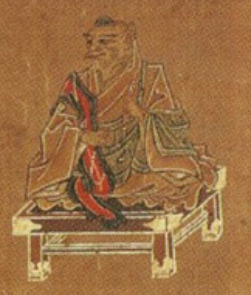
Tarōbō in a mandala from Mt. Atago (via Patricia Yamada's Bodhisattva as Warrior God; reproduced here for educational purposes only)
Tarōbō (太郎坊) is the tengu of Mount Atago. This location’s association with the tengu is well attested, and for instance in Hirasan Kojin Reitaku multiple of them are said to reside there, including Yokei, Zōyo and Jien.
However, Tarōbō is not identical with any of these historical monks. He’s an interesting case because it would appear he stands exactly on the border between historical figures and literary characters. One of the first attestations of him, if not the first one outright, has been identified in the Tengu Zōshi. On an illustration showing a gathering of tengu leaders, who are mostly identified by the names of schools of Buddhism they represent, one is instead given a specific name, Atago Tarōbō (愛石護太郎房). His notoriety continued to grow in later sources: Taiheiki presents him as a well known tengu, while Heike Monogatari outright labels him the “greatest tengu in all of Japan”.
While Tengu Zōshi and other early sources don’t provide any information about Tarōbō’s origin, in later tradition he came to be identified with the legendary Korean monk Nichira (日羅). His name would be read as Illa following the Hanja sign values, and at least some authors prefer using this reading or list both. I’m sticking to Nichira here, to maintain consistency with a name sometimes used to refer to his tengu form, Nichirabō (日羅坊; “the monk Nichira”).

A statue of Nichira (amagasaki-daikakuji.com; reproduced here for educational purposes only)
Nichira is mentioned for the first time in the Nihon Shoki, in the section describing the reign of emperor Bidatsu (late sixth century). He is described as an inhabitant of Baekje, one of the three Korean kingdoms which existed at the time. However, his father came there from Japan. The emperor seeks his help with navigating foreign policy. After some tribulations - apparently the king of Baekje didn’t want to let him go - he finally arrived in Japan in 583, armed and on horseback. He starts acting as an advisor to the emperor.
After a few months, Nichira is assassinated by other Baekje envoys present in the court since he wants the emperor to pursue rather aggressive foreign policy (most notably, he suggests ruthlessly slaughtering any potential settlers from Baekje who would try to establish settlements in Japan). The assassination has to be delayed, because he emits supernatural light at night.That’s not where his apparent supernatural powers end - after being killed he resurrects for a moment in order to make it clear his assassination was not a plot of Silla (another Korean kingdom). He is later buried, and no further mention is made of him.
While some elements of the Nihon Shoki account were retained in later legends about Nichira, especially his arrival from Korea and his ability to emit a supernatural glow, he was otherwise essentially entirely reinvented. Instead of an advisor of emperor Bidatsu, he came to be portrayed as a Buddhist monk and as an ally of prince Shotoku.
An early example of such a legend is preserved in Nihon Ōjō Gokuraku-ki (日本往生極楽記; “Japanese records of rebirth in a Pure Land”) from the late tenth century. It states that Nichira met with Shotoku when the latter was still a child, and declared he was a manifestation of Kannon. The prince in response recognized him as the reincarnation of one of his disciples from an unspecified past life. We also learn that he is capable of emitting light because of his devotion to Surya, the personification of the sun. There’s no real chronological issue here: while Nihon Shoki doesn’t mention Shotoku (or Buddhism, for that matter; it first comes up a year after Nichira’s death there) in any passages dealing with Nichira, the prince would indeed be a kid at the time of his arrival.
Things get more complicated later on. True to his portrayal as a ruthless enthusiast of military operations, Nichira came to be described as aiding Shotoku in quelling Mononobe no Moriya and hid allies. Following the conventional chronology this would have happened long after Nichira’s death, though. A possible attempt at reconciling obviously contradictory traditions can be found in Ōe no Masafusa’s Honchō Shinsenden (本朝神仙伝), as you might remember from the Ten Desires post from last year.
In contrast with virtually every other source dealing with Shotoku’s genealogy, Masafusa claims the prince was a son of Bidatsu, which would make him considerably older at the time of Nichira’s arrival. The meeting between them is fairly similar to the Nihon Ōjō Gokuraku-ki version: Nichira recognizes Shotoku as a manifestation of Kannon, and both of them then emit supernatural light. No mention is made of any military help, though.
The portrayal of Nichira as a military ally of Shotoku is present in legends which link him with tengu. After the defeat of Moriya, he supposedly left to take over Mt. Atago. According to a guide to famous places (名所記, meishoki) from 1686, Kyōwarabe (京童; “Children in Kyoto”) by Kiun Nakagawa (中川喜雲; 1636-1705) he did so in the form of a tengu.
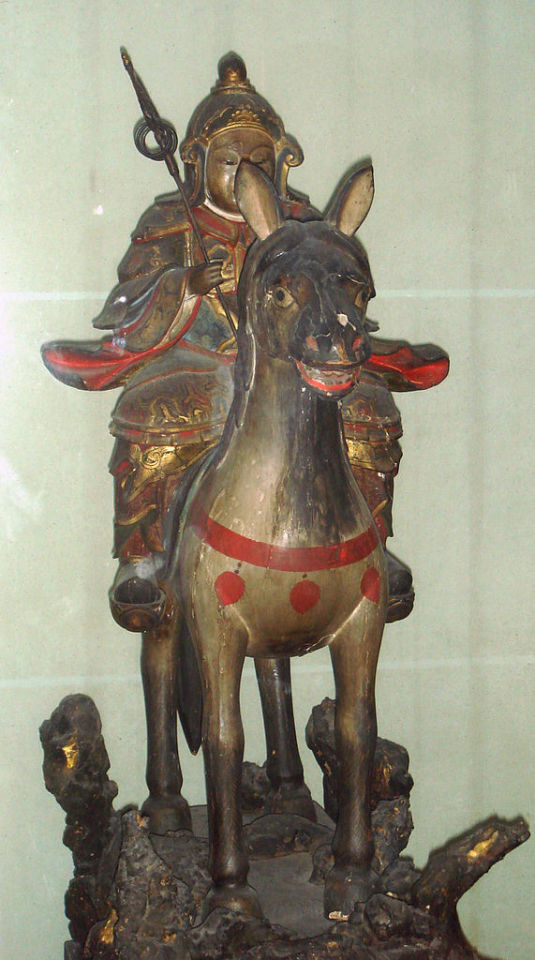
Atago Gongen (wikimedia commons)
Bernard Faure notes there is a similar legend in which Nichira is a separate figure from Tarōbō. The former, portrayed as a military official in the service of prince Shotoku, sets on a journey to pacify the tengu of Mt. Atago. He accomplishes this by revealing he is a manifestation of Shōgun Jizō (勝軍地蔵), a Kamakura period reinterpretation of this normally peaceful bodhisattva as a fearsome warrior, historically worshiped on Mt. Atago as Atago Gongen. Nichira then becomes the leader of the tengu, while Tarōbō provides him with information about the mountain.
Something that surprised me is that there is a single Korean source which mentions the tradition presenting Nichira as a monk who became a tengu. During the Imjin war, a failed Japanese invasion of Korea, the Korean Neo-Confucian philosopher Kang Hang was captured and subsequently spent three years (from 1597 to 1600) in Japan as a prisoner of war before escaping (possibly with the help of Seika Fujiwara, a fellow Neo-Confucian scholar he befriended). He wrote a memoir dealing with this experience, Kanyangnok (“The record of a shepherd”) in which he mentions Nichira in passing. He states that he was known as Tarōbō, and that he was enshrined and worshiped as Atago Gongen.
Something that’s worth pointing out is that despite living centuries apart, Ōe no Masafusa and Kang Hang both make the same mistake, stating that Illa arrived in Japan from Silla, as opposed to Baekje. I thought this might represent an alternative tradition, but in both cases translators pretty firmly conclude we’re dealing with a mistake. My best bet would be that this has something to do with the Japanese name of Silla, 新羅, sharing a kanji with Nichira’s own name; the name of Baekje, 百済, does not. It doesn’t seem any later legend brings up his post-mortem effort to clear the name of Silla envoys from the Nihon Shoki, so I don’t think that was necessarily a factor.
I’m actually shocked I haven’t seen a Touhou take on Nichira, considering his association with Shotoku. In particular, it’s worth pointing out that his transformation into a tengu is essentially how people tend to mistakenly assume the connection between Matarajin and Hata no Kawakatsu work (in reality, it’s very limited in scope and indirect, but that’s a topic for another time). Plus there’s a lot of storytelling potential in having a tengu - or even Tenma - be yet another character from Miko’s past. ZUN isn’t very interested in building upon prince Shotoku legends involving Kawakatsu or Kurokoma, but it’s hard to deny they’re a popular topic in fanart.
Yet another tradition about the identity of Tarobō, as far as I can tell entirely independent from his connection to Nichira, is preserved in the Engyōbon, the oldest version of Heike Monogatari. A gloss states that he is the tengu form of the monk Shinzei (真済; 800-860), who in a tale from Konjaku Monogatari and a variety of other sources menaced empress Somedono (染殿后; Fujiwara no Akirakeiko), the wife of emperor Seiwa.
Tarōbō also plays a role in a tale unrelated to speculation about his origin, Kuruma-zō Sōshi (車僧草紙; “Tale of the handcart priest”). It was originally composed in the sixteenth or seventeenth century. The eponymous protagonist is a Zen practitioner who, as his name indicates, travels with his handcart in tow. Tarōbō attempts to convince him to abandon this lifestyle. They engage in a Zen dialogue (mondō), in which the monk triumphs over the tengu. He also manages to overcome Tarōbō’s subordinates who attempt to make him stray away from his practice by showing him gruesome images of battles in the realm of the asuras.
Finally, under the name Nichirabō Tarōbō appears in the tale of Zegaibō. Initially I planned to only dedicate a single paragraph to it, but I figured Zegaibō is such a fun figure that a separate section is warranted.
Not a tiangou: Zegaibō, the Chinese tengu
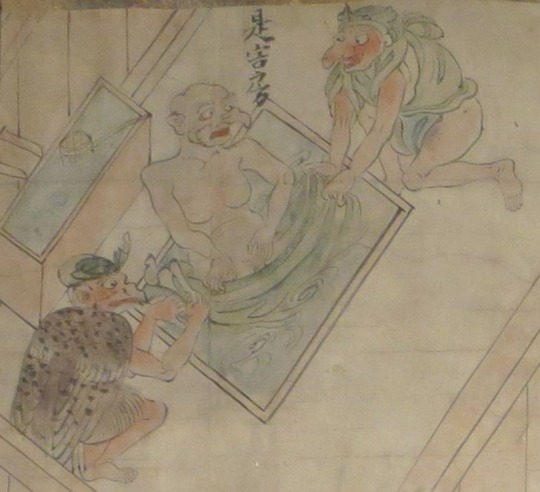
Zegaibō taking a bath (wikimedia commons)
The history of Zegaibō (是害坊) starts before he even got this name. In the anthology Konjaku Monogatari, there are a handful of stories about tengu arriving in Japan from overseas - specifically from India or China. These are obviously literary fiction, as there is nothing quite analogous to tengu in Indian literature, and while their name is borrowed from Chinese tiangou, this term also doesn’t have all that much to do with tengu, ultimately.
One of the aforementioned stories focuses on a Chinese tengu named Chira Yōju (智羅永寿; I was unable to establish whether there’s any connection with 智羅天狐, the alternate name of Iizuna Gongen, Chira Tenko) He arrives in Japan to challenge local Buddhist monks. He reveals that he has previously bested these in his homeland successfully, and that he would like to check how their Japanese peers compare. Local tengu took him to Mt. Hiei, where he unsuccessfully tries to bait major Tendai monks, including Ryōgen, into battling him. He is eventually beaten up by Ryōgen’s attendants, and after his defeat the Japanese tengu take him to a hot spring so that he can recover. In the end he decides to return home.
It was possible to establish that Chira Yōju was the basis for the tale of Zegaibō because the colophon of an illustrated scroll known simply as Zegaibō Emaki (是害坊絵巻) states that the story draws inspiration from a similar tale from the lost collection Uji Dainagon Monogatari. Based on other sources it is assumed it was most likely identical with the Konjaku Monogatari account of the misadventures of Chira Yōju. Save for the change of the main character’s name, the stories do not differ much. More time is dedicated to the meeting between Zegaibō and the Japanese tengu, though. They are led by Nichirabō from Mt. Atago.
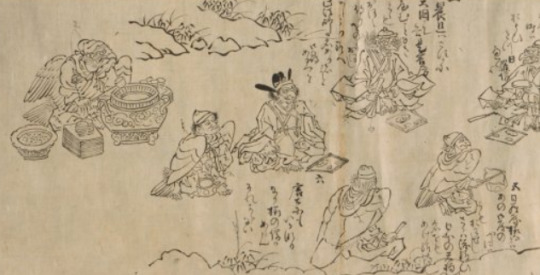
Zegaibō meeting with his Japanese peers (New York Public Library Digital Collections)
Zegaibō evidently became a popular, recognizable character later on. This might reflect a sense of patriotism (or nationalism) the story possibly could have inspired in the readers: the Japanese monks are portrayed as more resistant to the schemes of demons than their continental peers, after all. However, it’s also possible that Zegaibō’s defeat was interpreted as a take on tensions between Buddhist monks and shugenja, considering the latter were commonly compared with tengu.
Regardless of which interpretation is correct, Zegaibō’s undeniable popularity allowed him to reappear in a variety of other tales. There is a noh play which simply adapts the tale about him, Zegai. The events are largely the same, though the name Tarōbō is used instead of Nichirabō to refer to the tengu of Mt. Atago. Bernard Faure mentions that in one version of the legend about Nichira’s arrival on Mt. Atago, he defeats Zegaibō, here portrayed as the leader of the local tengu. The tengu subsequently reveals the “sacred geography” of Japan to him. Finally, Zegaibō plays a major role in the Edo period puppet play Shuten Dōji Wakazakari (酒呑童子若壮; “Shuten Dōji in the Prime of Youth”).
In this work, Zegaibō is indirectly responsible for the transformation of the eponymous character into an oni. After a rampage which left 160 monks dead and various other heinous acts, the young Shuten Dōji, known simply as Akudōmaru (悪童丸; “evil child”), proclaims that there has never been anyone more mighty than him in Japan, China or India. This display of arrogance alerts Zegaibō, who appears in the guise of a young monk and offers to wrestle with him so that he can prove his strength. However, as soon as the fight starts, he reveals his true form and takes Shuten Dōji into the air.

Zegaibō presents Akudōmaru to Maheśvara (via Keller Kimbrough's Battling Tengu, Battling Conceit; reproduced here for educational purposes only)
Zegaibō then brings his opponent to Maheśvara (摩醯首羅王, Makeishuraō; a phonetic transcription is used in place of the most common Japanese form 大自在天, Daijizaiten). The latter is unexpectedly described as a maō. Zegaibō seemingly presumes that his boss will punish the unruly human by turning him into a tengu, but Maheśvara is so impressed by his bravery that he chooses to turn him into an oni to let him cause even more chaos.This is rather obviously distinct from the more widespread versions I discussed in the not so distant past.
From makara to tengu: Konpira

A typical depiction of Konpira as one of the heavenly generals (via Bernard Faure’s Rage and Ravage; reproduced here for educational purposes only)
While Zegaibō according to tales focused on him arrived from China, there is technically a tengu whose origins were believed to lie even further away - Konpira (金比羅). However, it needs to be stressed that he is a special case because despite being arguably one of the most famous tengu, he actually wasn’t viewed as a member of this category for most of his history.
Konpira is a Japanese transliteration of Sanskrit Kumbhīra. This name can be literally translated as “crocodile”. His origin is poorly understood, though it is possible he was originally essentially a divine representation of reptilian inhabitants of the Ganges. As you can read here, the gharial, the mugger crocodile and the saltwater crocodile all can be found in this river in some capacity.
Fittingly, Kumbhīra is sometimes described as a makara who converted to Buddhism. This term refers to a type of partially crocodilian mythical hybrid, most notably depicted as the steed of Hindu deities such as Ganga and Varuna. Bernard Faure suggests that in Japan he might have been analogously understood as a wani at first. However, Kumbhīra could also be portrayed as a yaksha, for example in the Golden Light Sutra. What remained consistent is the idea that he was a fierce being converted to Buddhism.
Kumbhīra is well known as the foremost of the Twelve Heavenly Generals (十二神将, jūni shinshō). It is possible that the crocodilian Kumbhīra and the homonymous heavenly general were initially separate deities, though in Japanese context they are effectively the same. Konpira and his peers are regarded as the protectors of the Buddha Yakushi but historically simultaneously perceived as a type of shikigami. I will only discuss this role more in my next article, though, as it is not very relevant here. All you need to know is that it made him a commonly invoked protective deity in apotropaic rituals.
An interesting legend pertaining to this aspect of Konpira’s character is preserved in the Taiheiki. When Fujiwara no Yasutada (藤原保忠; 890-936) fell ill, a Buddhist priest arrived to perform a ritual focused on Yakushi and his heavenly generals to heal him. However, as soon as he started to invoke Konpira, Yasutada got so horrified that he died. The ritual has apparently been hijacked through supernatural means, and what he heard was not the name “Konpira” but rather the phrase kubi kiran - “I’ll cut off your head”. This was an act of vengeance of the spirit of Sugawara no Michizane - Yasutada was one of the courtiers who conspired to exile him earlier. Evidently after he became a vengeful spirit he was able to essentially turn Konpira to his cause and reverse the effects of invoking him.
While the heavenly generals are associated with the Chinese zodiac, the correspondences between the individual deities and zodiacal animals aren’t really consistent. Konpira can variously be linked with the tiger, the rat or the boar, and accordingly with the northeast, north or northwest. The northeastern link is particularly significant, as in some cases it led to conflation between him and Matarajin, who as a subduer of demons was strongly associated with this direction.
A variant of the legend in which Saichō, the founder of Tendai, meets Matarajin during his journey to China identifies the latter with Konpira. Supposedly Konpira slash Matarajin was originally the protector of the Vulture Peak in India, then moved to Mount Tiantai in China, and finally reached Mount Hiei in Japan with Saichō.
The two were also equated with each other by the Tendai priest Jōin (乗因; 1682–1739) in the Edo period. However, his attempt was actually met with criticism from his contemporaries. A certain Sōji Mitsuan (密庵僧慈) wrote in 1806 that Jōin was evidently confused because Matarajin and Konpira are clearly separate deities. He concludes he evidently didn’t even read the Mahāvairocana Sutra. I’m honestly surprised ZUN didn’t reference this conflict over syncretism in any of Okina’s spell cards, it would fit right in.

Konpira Daigongen (wikimedia commons)
Despite Matarajin’s tengu credentials, which I discussed last month, the association between him and Konpira actually isn’t why the latter came to be seen as a tengu. This phenomenon instead began as an aspect of his role as the protective deity of Matsuo-ji on Mt. Zōzu (象頭山) in Shikoku. Here he came to be worshiped under the name Konpira Daigongen (金毘羅大権現). His enshrinement apparently only occurred in 1573, though according to a legend from the seventeenth century he arrived there much earlier, and already resided on Mt. Zōzu in the times of En no Gyōja. However, there is no reference to him in the few earlier sources dealing with this location. Since its name can be translated as “Mt. Elephant Head”, it has been suggested that it might have been associated with Shōten, the Japanese form of Ganesha, in earlier periods, though this remains speculative.
Despite Konpira’s new role as a mountain god, his early aquatic connections were not entirely lost. In the eighteenth century he came to be seen as a protector of maritime routes through the Seto Inland Sea and tutelary god of navigation. This reflected the growth of importance of inland maritime trade which was a result of the shogunate's ban on most foreign trade.
Interestingly, while most donations were made to Konpira by local sailors and merchants, his new role made him so famous that Chinese traders residing in Nagasaki prayed to him too, and a small shrine was even erected in that city at one point. Donations made by travelers from the Ryukyu Kingdom are recorded too. Both of these phenomena were highlighted in Edo travel books in order to stress the prestige of Konpira.
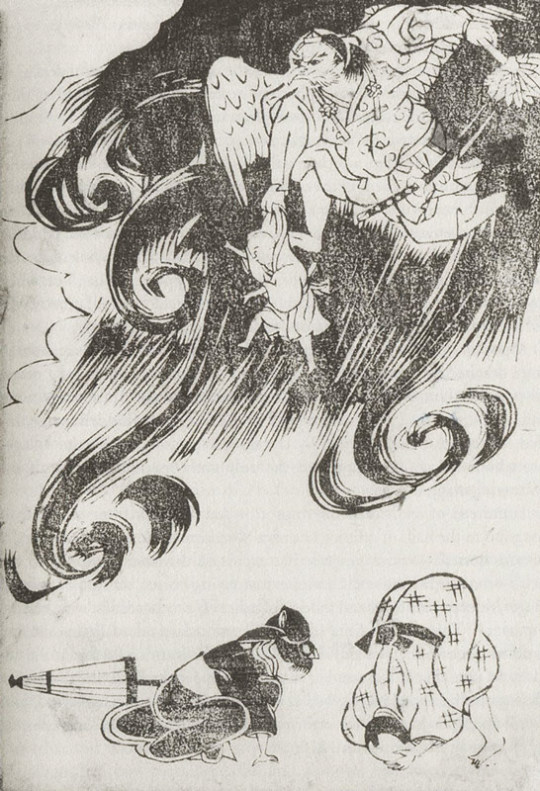
Kongōbō (Universität Wien's Religion in Japan: Ein digitales Handbuch)
Konpira didn’t become a tengu right away. The oldest recorded tradition associating Mt. Zōzu with a specific tengu refers to him as Kongōbō (金剛坊; “diamond priest”). He was not (yet) a form of Konpira, but rather a deified seventeenth century Shingon monk, Yūsei (宥盛), who between 1600 and 1613 served as the abbot of Matsuo-ji.
It seems Yūsei actually created the image of himself as a tengu on his own - in 1606 he commissioned a statue depicting him as a tengu manifestation of Fudo Myōō. The inscription explicitly states that he “entered the way of tengu” in order to bring fame to the mountain. This was a part of a bigger project of portraying himself as a master of various esoteric arts in order to gain the patronage of local nobles. After he passed away, his disciples and relatives continued spreading the image of his tengu form, now renamed Kongōbō. He eventually came to be seen as a manifestation of Konpira.
In popular imagination the new tengu-like image of Konpira eventually came to be detached from its actual origin. He was instead identified as emperor Sutoku simply because both were associated with roughly the same area - the historical Sanuki province. This idea was popularized by the 1756 play Konpira Gohonji Sutokuin Sanuki Denki (“The Sanuki Legend of the Retired Emperor Sutoku, the Original Source of Konpira”) by Izumo Takeda II. Various other authors followed in his footsteps, including Akinari Ueda and Bakin Takazawa, strengthening this equation.
While I focused on the early portrayal of Konpira and on his eventual transformations into a tengu, the traditions of Mt. Zōzu continued to evolve in subsequent centuries. After the separation of Buddhism and Shinto, Konpira came to be viewed as a kami. Due to the influence of Atsutane Hirata and his disciples he received a new name, Kotohira (金刀比羅) after the Meiji reforms. However, many lay people continued to refer to the protector of the mountain as Konpira. Today both forms of the name are in use.
Bibliography
Tumblr doesn't let me post the bibliography as a part of the article for some reason. You can find it here in the form of a google doc.
84 notes
·
View notes
Text
Start your 2024 with some cutting edge research and maybe even gain insights into future articles... or yet more arcane spheres like Touhou fan characters...
5 notes
·
View notes
Text
"A god of tengu-warding": uncovering the connection between Okina and tengu

There’s something uniquely magical and captivating about Okina’s dialogue in HSiFS that neither subsequent final bosses nor even her own subsequent appearances manage to capture. Probably no other character managed to directly reference quite as many myths and religious concepts in her debut game appearance. And yet, without context many of these probably seem borderline nonsensical. Interviews and supplementary material sometimes help, but even that isn’t guaranteed.
This article will focus on only one such instance, the notoriously mystifying exchange between her and Aya which simultaneously casts her as a “god of tengu-warding” and implies a degree of kinship between them. What does this mean? Why does Okina have something to do with tengu in the first place? Where do tengu come from, anyway? Why crow tengu aren’t necessarily crows? Why is it possible to make a case for Byakuren being a tengu? This - and more - will be explored under the cut.
Matarajin and tengu, from tengu odoshi to Hidden Star in Four Seasons
In Aya’s route in Hidden Star in Four Seasons, Okina calls herself “a god of tengu-warding”. This is actually not something ZUN invented. Matarajin was the focus of a medieval Tendai Buddhist ritual known as tengu odoshi (天狗怖し) - “placating the tengu”. He was most likely himself understood as a tengu in this context. As such, he had to be placated by the monks performing the ritual, whose chaotic actions - chiefly noisy recitation of random sutras coupled - were meant to imitate his own behavior.
This approach is somewhat unusual: in many other similar ceremonies an appropriate deity or deities would simply be invoked to get rid of demonic interlopers. Here the risk of obstruction is so great that only by pretending to play along with it victory can be attained. Or, alternatively, perhaps to get rid of Matarajin and other tengu, the monks had to beat them at their own game by creating an even more disorderly display. Yet another option is that Matarajin had to be attracted with the ritual in order to ward off other, lesser tengu. No matter which interpretation is correct, it is evident there was a direct connection between them.

Matarajin and his attendants (Rhode Island School of Design Museum; reproduced here for educational purposes only)
As a curiosity it’s worth pointing out that it has been suggested that tengu odoshi and other similar rituals and festivals might have resulted in the development of Matarajin’s well known role as a deity of the performing arts, especially noh, exemplified by his equation with a stock character from sarugaku, Okina, an auspicious old man represented by a characteristic bearded mask. Comparisons have also been made between the tengu odoshi and rituals involving Matarajin’s attendants Chōreita Dōji (丁令多童子) and Nishita Dōji (爾子多童子). Fittingly, one of the spell cards of their Touhou counterparts Mai and Satono is named Mad Dance "Tengu-Odoshi".

Shizuka Gozen performing in typical shirabyōshi attire, as depicted by Hokusai (wikimedia commons)
While this is only tangentially related to Matarajin, it’s worth pointing out that according to Yasurō Abe, it was also believed that tengu were enthusiasts of the performing arts in general. However, while Matarajin was associated with noh, tengu favored an earlier form of entertainment, shirabyōshi (白拍子). This term refers to a type of female dancer who performed in male formal wear. The reference to tengu enjoying their dances and songs might be an allusion to emperor Go-Shirakawa, who was known for similar artistic tastes and was commonly represented as a tengu in legends.
The association between Matarajin and tengu was also present in shugendō. In Kumano, local shugenja apparently perceived him as a tengu-like deity comparable to Iizuna Gongen (飯縄権現). It’s worth noting this is in theory who Megumu is based on, but tragically ZUN didn’t want to do much with the irl background in her case, so I doubt we'll ever see a reference to this in canon media.

An Edo period depiction of the ox festival of Matarajin (wikimedia commons)
It seems the only other possible reference to Matarajin as a tengu is a depiction of the famous (relatively speaking) Kōryū-ji ox festival from the Edo period Miyako Meisho Zue (都名所圖會) in which the person playing his role wears a tengu-like mask.
Considering ZUN has to be aware of at least some of the scholarship pertaining to Matarajin and tengu - tengu odoshi is not exactly a famous ritual, and most of the search results today are just Touhou - it seems safe to say that he had this very connection in mind. Aya mentions a category of beings she refers to as “people of impairments”, which according to her encompasses both the tengu and their metaphorical relatives who “hid behind Buddhas”, like Okina. This neatly corresponds to their shared role of their counterparts in medieval and early modern Buddhism.
In addition to the connections between Matarajin and tengu discussed above, there are multiple other instances of identifying him as a member of a category of beings usually perceived ambivalently, if not outright negatively, specifically because of their ability to impair the pursuit of enlightenment. If you read my previous post focused on Okina-adjacent topics, you already know that Matarajin was closely associated with dakinis, for instance. It’s worth noting that as an extension of this connection, he could also be associated with foxes. The Edo period treatise Inari Jinja Kō (稲荷神社考, “Reflections on Inari Shrine”) outright says that matarajin, treated as a generic term, not a given name, is one of the the terms which can be used to refer to supernatural foxes.
The oldest presently known reference to Matarajin describes him as a “yasha deity” (夜叉神, yashajin). This term is a loan from Sanskrit yakṣa, and refers to a class of nature spirits or low-ranking deities incorporated into Buddhism from preexisting tradition of India. They are portrayed as generally benevolent and protective. To be a yaksha in origin is no shame for a deity, despite their low status and occasional ambivalence. Bishamonten, who needs no introduction, as well as Konpira, the foremost of the Twelve Heavenly Generals, are both portrayed as yakshas who embraced Buddhism. Even the bodhisattva Kannon seemingly was portrayed as a reincarnation of a female yaksha named Cundī early on. In both China and Japan, the most widespread image of a yaksha is ultimately that of an armed, protective figure.
However, sometimes negative traits can be ascribed to yakshas too. For instance, the Tang period Buddhist scholar Guifeng Zongmi maintained that yakshas are child-eating demons - though he also recorded a custom of dedicating children to them in order to prevent them from harm. The tenth century Tendai monk Genshin stated they were among demonic beings who could potentially obstruct rebirth in a pure land. However, it was possible to solve this problem with the right rites.
The examples listed above are just a few glimpses of one of the most recurring topics in historical Japanese Buddhist literature: there were demons, and even deities (障礙神, shōgejin) keen on impairing the pursuit of enlightenment unless properly placated. This would either ward them off, or even turn them into fierce protectors of Buddhism instead (what ZUN presumably meant by Aya’s comment about “hiding behind Buddhas”). However, most of such beings originated in India and spread alongside new religious movements. How did tengu join their ranks? To answer this question, I will need to go beyond Matarajin and further back in time, to the Heian and Kamakura periods.
Makai, the realm of tengu
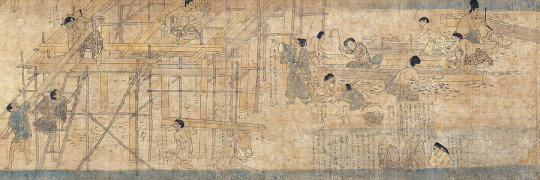
A group of Tengu constructing a temple in the tengu realm (wikimedia commons)
The emergence of tengu as a well defined class of beings is fundamentally tied to portraying them as a source of hindrances for practitioners of Buddhism. In the twelfth century, they came to be identified with the concept of ma (魔), a loanword from Sanskrit māra. In this context, it is to be understood as obstruction of enlightenment, or opposition to the Buddha, his teachings and the Buddhist law. There are both internal sources of ma, like doubt and worldly attachment, and external ones. Tengu, generally speaking, fall into the second category.
Tengu were believed to be reincarnations of those who lack bodhicitta (菩提心, bodaishin), the mindset necessary to pursue enlightenment. Those who become tengu at least nominally follow Buddhist teachings, but fail because of arrogance, greed and other earthly attachments. Those who mislead others by promoting incorrect practices also turned into tengu after death.
Many tengu narratives from the Heian period and the middle ages portray them as possessing extraordinary powers, which they use to trick and mislead monks and laypeople alike. They could be referred to as gejutsu (外術), literally “outside techniques”. A related term is gedō (外道), “outside way”. These labels are not necessarily pejorative, and can refer to any practices which are not strictly Buddhist, for example to Confucian or Daoist ones, and in fact some were integrated with Buddhist practices. However, depending on context other options might be preferable. For example, Haruko Wakabayashi went with “wicked sorcery” in her translation of a Konjaku Monogatari tale in which a tengu poses as a buddha in order to mislead laypeople. However, even if tengu could imitate miracles Buddhas and bodhisattvas were believed to perform, their results were only temporary because they lacked true power. In many tales the effects of tengu tricks only last seven days.
According to the Kamakura period anthology Shasekishū (沙石集), not all tengu are malicious, despite their origin. Those who are close to being redeemed, while held back by “superficial wisdom”, curtail the influence of their more malevolent peers and thus act as protectors of Buddhism. They eventually leave the realm of tengu. Other sources indicate that the malign tengu are destined to eventually be reborn as animals.
As already pointed out above, the notion of tengu being opponents of Buddhism already appears in Konjaku Monogatari, composed between 1120 and 1140. The tales involving them appear in the final chapter of the section focused on Buddhism in Japan, which sets them apart from most other supernatural beings. They are instead grouped with accounts of visits in hells and other realms of rebirth, and with narratives explaining the consequences of accumulation of bad karma.
In the Kamakura period, tengu received their own place in the Buddhist cosmos: an entire realm of rebirth. It didn’t replace any of the three other realms where one reincarnates as punishment due to accumulating bad karma - these of hungry ghosts, animals, and hell. It could be sometimes described as a specific hell (one of many) or as a part of the animal realm, but generally it was held to be something distinct. While still perceived negatively, it can effectively be considered a preferable alternative to rebirth as an animal or in hell, since to be reborn as a tengu does not necessarily prevent one from seeking enlightenment.
The realm of tengu was variously referred to as tengudō (天狗道; “realm of tengu”), madō (魔道; “realm of ma”) or makai (魔界; “world of ma”). The last of these terms has been present in Touhou for a while, though never in association with tengu, at least for now. I am aware many people are attached to the PC-98 portrayal of Makai and to Shinki, but I would argue there are endless possibilities in trying to make the medieval understanding of this term work in this context as well. Most notably, the notion of monks who failed in their pursuit of enlightenment would have interesting implications for Byakuren. Following medieval Buddhist logic, one could argue she is essentially already a tengu, even though ZUN refers to “sealing” in Makai, as opposed to being reborn there. She may deny it herself in Symposium of Post-Mysticism, but it's hard to argue with the evidence.
The oldest work establishing the existence of tengudō as a distinct realm of rebirth is Hirasan Kojin Reitaku (比良山古人霊託; “The Spiritual Oracle of the Old Man of Mount Hira”), in which the Tendai monk Keisei (1189–1268) learns about it from a tengu residing on Mount Hira. While left anonymous, the being states that he was alive in the times of Shōtoku and before the rise of Fujiwara no Kamatari to prominence, and explains that due to worldly attachments he was reborn in the realm of tengudō. He then provides information about many of Keisei’s family members and contemporaries, as well as assorted historical figures. Some of them have shared a similar fate, including emperors Sutoku and Goshirakawa and prominent members of Buddhist clergy like Ryōgen, Jien, and many others. Keisei and the anonymous tengu then engage in what I can only describe as a vintage example of power scaling, and start to compare the strength of the individual tengu (as we learn, Go-Shirakawa is more powerful than Sutoku).
Curiously, the anonymous tengu is entirely self-aware, and explains that his mind is filled with illusory thoughts, but proper Buddhist observance can nonetheless save him and other tengu from their current state. He notes that Ryōgen was able to leave the realm of tengu already, for instance. Another peculiar aspect of this account is the explicit reference to female tengu. The protagonist explains to Keisei that his wife is a fellow tengu, though she is only 400 years old. He also specifies many other tengu have families and even children.

A debate in the tengu realm (wikimedia commons)
The Buddhist views on tengu became firmly cemented thanks to the Tengu Zōshi (天狗草紙), a set of seven illustrated scrolls. This work most likely originally arose in the thirteenth century, in an era of conflicts between the well established esoteric schools of Buddhism, Tendai and Shingon, and the newcomers to the scene, like Zen and Pure Land. All parties involved accused each other of spreading false teachings and embracing ma. The new schools did not form a unified front, for clarity: for instance, Nichiren denounced the Shingon establishment about equally enthusiastically as Zen or Pure Land. There were also voices presenting the very act of criticism of other schools as worthy of critique in itself.
The goal of Tengu Zōshi was to criticize and satirize the various vices of contemporary Buddhist monks by presenting them as tengu. It states that there are seven kinds of tengu, corresponding to seven different sorts of pride (citing Haruko Wakabayashi: “feeling slightly inferior to those who are greatly superior, feeling superior to those who are inferior and equal to those who are equal, feeling superior to those who are equal and equal to those who are superior, feeling superior to those who are superior, being attached to oneself, committing evil and thinking one is virtuous, and feeling enlightened when one is not).
Five of the tengu types are supposed to represent monks of major temples of this era (Kōfuku-ji, Tōdai-ji, Enryakuji, Onjō-ji, and Tō-ji), the remaining two are yamabushi (mountain ascetics) and “recluses” (tonse). However, the scrolls culminate with a reveal that all of the depicted tengu attained salvation and eventually became Buddhas (save for Ippen, who was instead destined to be reborn in the animal realm). This once again puts an emphasis on tengudō not being quite as bad as the other paths of rebirth which should generally be avoided: one has to actually practice Buddhism in some form to get there in the first place, and it is possible to attain enlightenment as a tengu.
The notion of tengudō and tengu being fallen monks did not vanish after the middle ages, and appears for example in some tales about Yoshitsune’s youth and his training with these beings, for instance in the Miraiki (未来記; literally “chronicle of the future”). Therefore, it is safe to say that this is the closest thing to a universal explanation where do tengu come from. However, their history actually goes even further back.
Cats, comets, dogs and kites: the origin of tengu

A tiangou from the Classic of Mountains and Seas (wikimedia commons)
The history of tengu starts in China. At least the history of the name, that is. The word 天狗, which in Chinese is read as tiangou, already occurs in the Classic of Mountains and Seas, probably composed at some point in the second half of the first millennium BCE, either near end of the Warring States Period or in the beginning of the reign of the Han dynasty. While tiangou can be literally translated “celestial dog”, the creature is actually compared to a wildcat with a white head, and makes catlike sounds on top of that. It is also said to repel evil forces. This quality is also reaffirmed by the poet Guo Pu, who additionally states the tiangou is so small that a ruler could either eat it or wear it as a belt ornament to make use of its protection.
Next to this whimsical image of a benevolent supernatural creature, the term tiangou was also used to refer to comets and similar celestial phenomena. This meaning of the term entered Buddhist texts, for example in the Sutra on the Bases of Mindfulness of the True Dharma (正法念處經, Chinese Zhengfa Nianchu Jing, Japanese Shōbō Nenshokyō), tiangou serves as a translation of the Sanskrit term ulka, which refers to meteors. The astral tiangou eventually developed its own supernatural associations in China, becoming a sort of dog-shaped astral demon. I cannot cover this topic extensively here, but you will find plenty of information, including a first hand account of a modern celebration tied to these traditions, in Xiaosu Sun’s article in the bibliography.
The earliest Japanese reference to 天狗 occurs in the Nihon Shoki (completed in 720), specifically in the section recording the events from the reign of emperor Jomei (593-641). The reason why I’m using the kanji here is that the reading is not necessarily intended to be tengu in this case; the gloss indicates it is actually to be read as amatsukitsune, “heavenly fox” (I’ll go back to this term later). However, Haruko Wakabayashi states it’s safe to assume that it was used here in the astronomical Chinese meaning. The passage refers to observation of a comet, which reportedly made the sound of thunder as it passed from east to west.
Some other early references to tengu occur in literature of the Heian period (794-1185). In this context, this term seems to refer to nondescript mountain spirits. They were believed to possess people to make them fall ill or to cause disorder. All around it seems they weren’t really meaningfully distinct from any other beings or phenomena which could be subsumed under the label of mononoke (物の怪), and it's not clear how their name came to be applied to them. In the early twentieth century, the folklorist Kunio Yanagita tried to prove these early tengu might have represented people pushed into the mountains by the spread of a centralized Japanese state. However, this theory never took off. Even some of Yanagita’s contemporaries, especially Kumagusu Minakata, were critical of it, and it’s just a weird curiosity today. Similar assumptions were proven correct in the case of tsuchigumo, and might be correct in the case of some oni tales, but these are matters for another time.
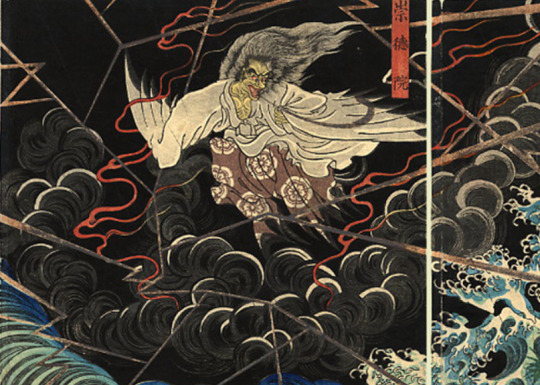
The supernatural form of Sutoku, as depicted by Yoshitsuya Utagawa (wikimedia commons)
Notably, in the Heian period it was already believed that one can reincarnate as a tengu, though this belief didn’t become quite as well defined as it was in later sources. Probably the oldest story like that states that the monk Shinzei (真済; 800-860) a disciple of Kūkai (774-835), became a tengu and subsequently tormented empress Somedono (染殿后; Fujiwara no Akirakeiko), the wife of emperor Seiwa. In later tradition, emperor Sutoku came to be viewed as the archetypal example of a human who reincarnated as a tengu; it should be noted he was simultaneously viewed as a vengeful spirit (怨霊, onryō), though.

A kite-like tengu, as depicted by Sekien Toriyama (wikimedia commons)
The well known association between tengu and birds is already present in Heian sources too. Today, the bird-like depictions of tengu are known as “karasu tengu”, literally “crow tengu”, and in many modern works, including Touhou, this moniker is taken literally. However, through history the birdlike elements of the tengu were typically those of a bird of prey, not a corvid. As I mentioned, kites were the most common, but for example some depictions of Iizuna Gongen are eagle-like. This convention might have been influenced by garudas, a class of bird-like Buddhist protective figures.
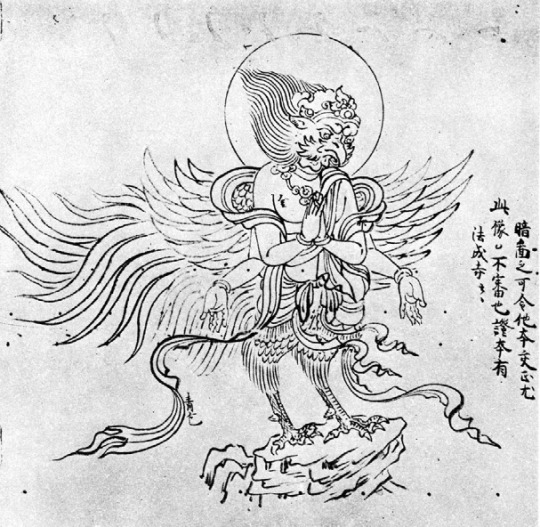
A depiction of a garuda from Besson Zakki (別尊雑記), a Heian period Buddhist iconographic compendium (via Bernard Faure’s Rage and Ravage; reproduced here for educational purposes only)
Descriptions of tengu explicitly mentioning their resemblance to kites are quite common. In Zoku Honchō Ōjōden (続本朝往生伝; “Continuation of the Biographies of Japanese Reborn in a Pure Land Continued”) Ōe no Masafusa (who you might remember from my Ten Desires article) mentions a tengu turning into a kite to spy on a virtuous monk. In the historical epic Taiheiki Sutoku, presented as the ruler of all tengu, is said to have the form of a golden kite. However, in at least some cases tengu are not necessarily birds themselves, but merely use them as mounts. Granted, both traditions could coexist: Hirasan Kojin Reitaku explains that tengu ride kites, but it also describes them as possessing the legs, tail and wings of a bird themselves.
The oldest source to feature a large number of images of bird-like tengu is the already discussed Tengu Zōshi. These include high-ranking monks with beaks, yamabushi or monks with wings and beaks, slightly more bird-like figures portrayed largely without clothing, and finally non-anthropomorphic kites. There are also illustrations of seemingly regular humans labeled as tengu. Haruko Wakabayashi concludes that the use of multiple distinct iconographic types in the same scrolls might reflect belief in a hierarchy of tengu, with the beaked monks representing the upper echelons of the tengu society and the other varieties their servants. The regular kites presumably hold the lowest position. The tengu world thus seems to reflect a contemporary idealized image of Buddhist hierarchy, with lower ranking practitioners, wandering ascetics and laypeople guided by senior monks.
ZUN kept the notion of tengu hierarchy, though the classes listed in the relevant entry in Perfect Memento in Strict Sense are largely his invention, or at least represent pretty extensive reinterpretation (for instance, tengu dressed up as yamabushi aren’t associated with printing in any particular way). While many of these changes work very well with his idea to adapt the traditional role of tengu as peddlers of dubious interpretations of Buddhist doctrine and false miracles with a fresh twist by making them purveyors of misinformation, I will admit I’m not sure where did the idea of wolf tengu come from, as it fits neither this theme nor any genuine tengu background. The wiki insists that’s a reference to the Chinese tiangou, but I’m not buying this.

Iizuna Gongen riding on the back of a celestial fox (wikimedia commons)
I would argue foxes would probably work better than wolves. In some cases due to phonetic similarity a degree of conflation, or at least confusion, could occur between tengu and tenko (天狐), “heavenly foxes”. The fourteenth century treatise Byakuhō Kushō (白寶口抄) states the tenko has the form of a kite, for instance. It’s also why Iizuna Gongen was sometimes referred to as Chira Tenko (智羅天狐). The link with foxes was hardly universal, though. For example, it is absent from the tradition centered on Mount Atago, in which in addition to birds, tengu are associated with wild boars. Note that a myth dealing with Iizuna Gongen’s arrival in Japan does indirectly link this location with foxes, but this is basically extending his own connections to other tengu.
While the discussed animal connections are quite important for tengu iconography, I was unable to find any evidence that there was ever a particularly strong belief in mundane animals turning into tengu, as Aya’s bio from Phantasmagoria of Flower View would imply. The only source I am aware of which would state that directly is Atsutane Hirata, one of the most fanatical kokugaku authors, and even he still states that at least some tengu were reincarnated Buddhists. Note that his works are generally not a record of genuine mythology or folklore, but part of an effort to “purify” Japanese culture which directly led to the birth of the “contemporary” form of expansive nationalism. In any case, Hidden Star in Four Seasons and the historical context of information it provides opens the possibilities for much more interesting and unique tengu backstories than just stage 2-worthy beast youkai fare.
To sum up, while individual stories might portray tengu as arriving in Japan from Korea (Tarōbō), China (Zegaibō and his prototype Chira Yōju) or even India (an anonymous tengu in Konjaku Monogatari), these reflect the routes across which Buddhism was transmitted to Japan. The tengu as a distinct supernatural creature had elements which originated abroad, obviously, but ultimately represented a strictly Japanese contribution to Buddhist demonology. At least some Japanese authors were already aware of this in the middle ages, as evidenced by the Shasekishū.
The three meanings of 天狗 - the tiangou, the astral object and the tengu - are explicitly described as distinct from each other in the encyclopedia Jakushōdō Kokkyōshū (寂照堂谷響集) compiled by the monk Unshō (運敞; 1614–1693). The original tiangou is described here as a type of tanuki which eats snakes, but this doesn’t exactly contradict the Chinese description I’ve mentioned before, as 狸, the character referring to wildcat in Chinese, was adopted to represent the name of tanuki in Japanese. The astral tiangou is described as a “tengu star” (天狗星, tengu-sei) which has the form comparable to a dog. Unshō stresses that both of these are distinct from the Japanese tengu, despite their names being written identically. He places the tengu in the entourage of Mara, alongside dakinis and vinayakas (in this context demons representing something like an evil counterpart of Ganesha as a remover of obstacles).
Beyond animals: the long nose tengu and Sarutahiko
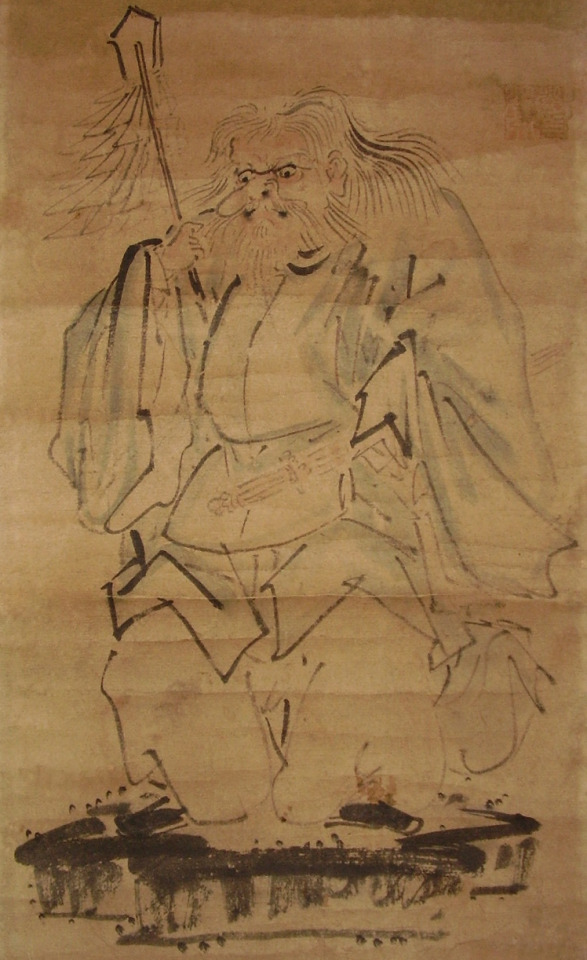
A Meiji period depiction of Sarutahiko (wikimedia commons)
A final matter which needs to be addressed here is a theory that tengu imagery is derived from Sarutahiko, which for some reason has been placed in the lead of the tengu article on wikipedia despite being hardly relevant academically. This proposed connection relies on the fact that from the very beginning Sarutahiko was described as long-nosed. In the section of the Nihon Shoki dealing with the “age of the gods”, the oldest text he appears in, it is said that “his nose is 7 feet long”. His other physical characteristics are also exaggerated, to be fair - he is said to be unusually tall, and his eyes are enormous too. All around, this description is presumably meant to make him seem intimidating. Still, the nose is what visual arts tend to highlight, sometimes for comedic purposes.

A long-nosed tengu, as depicted by Hokusai (wikimedia commons)
This characteristic also led to a development of a folkloric connection between Sarutahiko and the one type of tengu depictions I haven’t discussed yet - the long-nosed tengu, commonly called daitengu or “great tengu”. The origin of this iconographic variant remains poorly understood. While by far the most recognizable today, they are a relatively recent artistic convention - the oldest examples only date to the late fifteenth or early sixteenth century, and they only became widespread in the Edo period. By then, tengu were present in Japan for some 700 years, and Sarutahiko doesn’t come up in sources describing them (and vice versa).
It also needs to be stressed that while the daitengu still have some birdlike traits, Sarutahiko lacks a connection to birds altogether. Instead, he is associated with monkeys (tengu never are, contrary to an unsourced claim on wikipedia). Historically he could even be identified with Daigyōji (大行事), a deity from Mount Hiei depicted with the head of a macaque.
It’s not impossible that the specific long-nosed type of tengu depictions was based on depictions of Sarutahiko, but it’s equally likely the influence actually went into the opposite direction (most depictions of Sarutahiko are from the Edo period or later, and most shrines dedicated to him are fairly recently established too, even though he was worshiped in one form or another through earlier periods already).
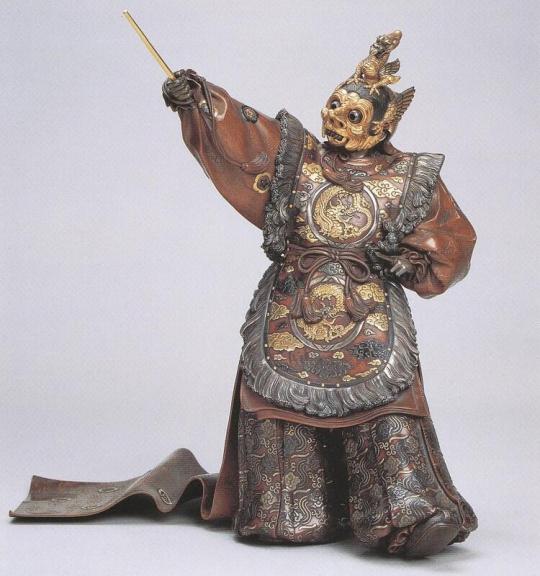
A statuette of a dancer wearing a Raryō-ō costume by Shōmin Unno (Imperial Household Agency; reproduced here for educational purposes only)
Bernard Faure notes it’s also not impossible that both Sarutahiko’s iconography and the long-nosed tengu are simply both reflections of something else altogether, and suggests the long-nosed Raryō-ō (羅陵王; sometimes shortened to Ryō-ō, 陵王) masks used in bugaku performances as one possible candidate. Ultimately none of these possibilities can be proven conclusively, though, and it’s best to maintain caution.
ZUN seems to believe there is some truth to the proposal that tengu were derived from Sarutahiko, judging from the fact he referenced this connection multiple times in various ways. The oldest example are Aya’s spell cards in Mountain of Faith. It also comes up in Symposium of Post-Mysticism, where Miko and Byakuren seem to basically treat it as a fact. Aya in one of the short articles from the same book declares that “when it comes to white beard in Gensokyo, we tend to picture Sarutahiko. (...) he is also the god of us tengu”. Putting aside the latter claim, which is bit of a reach when it comes to real beliefs, it’s worth noting that the mention of the white beard is a pretty deep cut. It was actually not a part of Sarutahiko’s original iconography, but rather an addition which developed at the Shirahige Shrine on the shores of Lake Biwa. Originally the local deity, Shirahige Myōjin (白鬚明神), was considered a distinct figure. However, at some point he came to be identified with Sarutahiko, and the names seem to be used interchangeably in medieval and later sources. As a result, the latter received the former’s signature white hair and beard.
While despite the existence of a genuine connection it is a stretch to call Sarutahiko a “god of tengu”, let alone their leader, this does not mean that figures which can be described this way are absent from tradition. In fact, I mentioned a number of them in passing in the previous sections. However, describing them in more detail a topic for another article. Look forward to "Tenma, boss of the tengu". Exploring the "heavenly demon(s)", coming next year!
Bibliography
Yasurō Abe, The Book of “Tengu”: Goblins, Devils and Buddhas in Medieval Japan
Bernard Faure, Protectors and Predators (Gods of Medieval Japan vol. 2)
Idem, Rage and Ravage (Gods of Medieval Japan vol. 3)
Michael Daniel Foster, The Book of Yokai. Mysterious Creatures of Japanese Folklore
Sarah Fremerman Aptilon, Goddess Genealogy: Nyoirin Kannon In The Ono Shingon Tradition in: Charles Orzech, Richard Payne & Henrik Sørensen (eds.), Esoteric Buddhism and the Tantras in East Asia
Wilburn N. Hansen, When Tengu Talk. Hirata Atsutane's Ethnography of the Other World
Richard E. Strassberg, A Chinese Bestiary: Strange Creatures from the Guideways Through Mountains and Seas
Xiaosu Sun, Liu Qingti's Canine Rebirth and Her Ritual Career as the Heavenly Dog: Recasting Mulian's Mother in Baojuan (Precious Scrolls) Recitation
Haruko Wakayabashi, The Seven Tengu Scrolls. Evil and the Rhetoric of Legitimacy in Medieval Japanese Buddhism
Idem, Monks, Sovereigns, and Malign Spirits: Profiles of Tengu in Medieval Japan
Duncan Ryūken Williams, The Other Side of Zen: A Social History of Sōtō Zen Buddhism in Tokugawa Japan
153 notes
·
View notes
Text
While I initially considered making a post covering Kojin myself I quickly realized just how immense a challenge it would be, for anyone curious about this enigmatic Japanese deity I would recommend checking out Bernard Faure's book series Gods of Medieval Japan, or at least giving the linked video a watch.
I may try my hand at covering Kojin myself once the fourth book in the series is out, but no promises.
Also goes without saying that I highly recommended checking out Antonia's work too, this coverage of Amaterasu has been a long time coming and should be full of surprises for just about everyone.
youtube
Tenshō Daijin: the many guises of medieval Amaterasu (part 2)

It wasn’t initially my intent to split this article in two, but I didn’t realize I have exceeded every possible limitation of the tumblr post editor. While part 1 introduced the various figures Amaterasu could be identified with, part 2 focuses on various adversaries she acquired in medieval myths, from new interpretations of Susanoo to Mara. It also includes the shared bibliography.
Special thanks to my friend @just9art who helped me with the mini-section introducing the uniquely complex figure of Kōjin. Additional thanks to everyone else who was asked for their opinion about countless drafts of individual sections of this article.
Amaterasu and Susanoo revised

Amaterasu confronting Susanoo (Kamigraphie; reproduced here for educational purposes only)
Since I already brought up classical myths about the conflict between Amaterasu and Susanoo in the final section of part 1, it is impossible not to discuss briefly what implications the transformations of the former had for the latter. In the new classification of kami employed at Ise, Susanoo came to be one of the “kami of delusion”. He was even identified with Devadatta, the archetypal ideological opponent of the Buddha. However, due to complex developments in medieval Buddhism, he was essentially rehabilitated anyway. Evil thoughts, it was argued, if properly channeled, can still lead towards enlightenment.

Ushimatsuri, the most famous festival dedicated to Matarajin, here portrayed riding on an ox (wikimedia commons)
The conflict itself was also retold multiple times. For instance, there is a version where Susanoo is assisted by Matarajin and an army of demons commanded by the latter, and Amaterasu hides from them in a fortress located in Utano in the historical Yamato Province. Utano is also the site of their confrontation in an account of it given by Urabe no Kanekazu (卜部兼員) in the fourteenth century, though in this case Matarajin is not involved and it is Susanoo who hides in a fortress. Amaterasu after her cavernous retreat besieges it, and all of Susanoo’s minions turn into snakes and disappear, so that ultimately he is left alone and has to wander until he reaches Izumo.
However, Bernard Faure stresses that ultimately Amaterasu and Susanoo were not too different from each other in medieval theology. Obviously, they had distinct roles and cult centers, but they were not necessarily portrayed as contrasting figures. Amaterasu too could be described as a wrathful or ambivalent figure, and in some peripheral areas she even came to be perceived negatively (more on that later). In a way, you could say they really feel like siblings. The monk Jihen (慈遍) argued that there is no point in making a distinction between Amaterasu and Susanoo in present times (for him that meant the 1300s, for clarity) and that both are worthy of reverence.
The image of Susanoo as an “evil kami” (悪神) was formed not by medieval theologians, but rather by nineteenth nativist authors, who saw him as an antithesis of Amaterasu and little more beyond that (given what interpretation of Susanoo followed in the Meiji period and beyond, this was not actually quite the worst page in his history, sadly). If Amaterasu, and thus the imperial house, were the epitome of all that is good, Susanoo, her rival in the “canon” they established, had to be the opposite, as they argued. There was little room for the more nuanced, elaborate representations of both figures common through the middle ages.
The myth of the Demon King of Sixth Heaven

A serpentine depiction of Mara from Hokusai's Shaka-goichidai-zue (wikimedia commons)
While the connection between Amaterasu and Susanoo kept being redefined, perhaps an even more important development was the acquisition of a new antagonist: Buddha’s most famous adversary Mara, known in Japan as Dairokuten Maō (大六天魔王; “Demon King of the Sixth Heaven”) or Tenma (天魔; “heavenly demon”) for short. It is well known that Buddhist doctrine presents Mara as the king of the world. In Japanese context, this led to redefining him as a “landholder deity”(地主, jinushi). While most other “landholders” were linked to specific locations, in Mara’s case these prerogatives were basically universal. This, in turn, created new opportunities for him to be relevant. Among them, there was arguably the defining example of a “medieval myth” - the account of the creation of Japan, in which he confronts Amaterasu.
The oldest version of the narrative about this conflict likely formed before 1191. While no manuscripts of it are actually that old, allusions have been identified in the Nakatomi Harae Kunge, where Dainichi manifests as Amaterasu in order to obtain a symbolic seal representing rule over Japan from Mara. Since the summary is quite vague, it can be assumed that the myth was already in circulation, and that the compilers of this ritual text expected their audience to be familiar with it.
While there are multiple variants, the core of the story is ultimately the same. It starts with an affirmation that Mara is the king of the world. However, he learns that Amaterasu is about to create a new land, and realizes Buddhism will flourish there. Since that means risking a loss of subjects, as with proper Buddhist guidance people would move towards enlightenment, he instantly intervenes, hoping to hinder Amaterasu’s efforts. Amaterasu, however, manages to deceive him: she reassures him she will not tolerate Buddhism, as reflected by the taboos from Ise I’ve discussed before. At the same time, she secretly remains a protector of Buddhism.
Mara is effectively defeated through deception. Granted, he doesn’t always leave with nothing. In some variants, Amaterasu promises that in return for fulfilling his side of the agreement he will be rewarded by being worshiped as Kōjin (荒神) and Kenrō Jishin (堅牢地神). Both of these figures warrant some explanation.
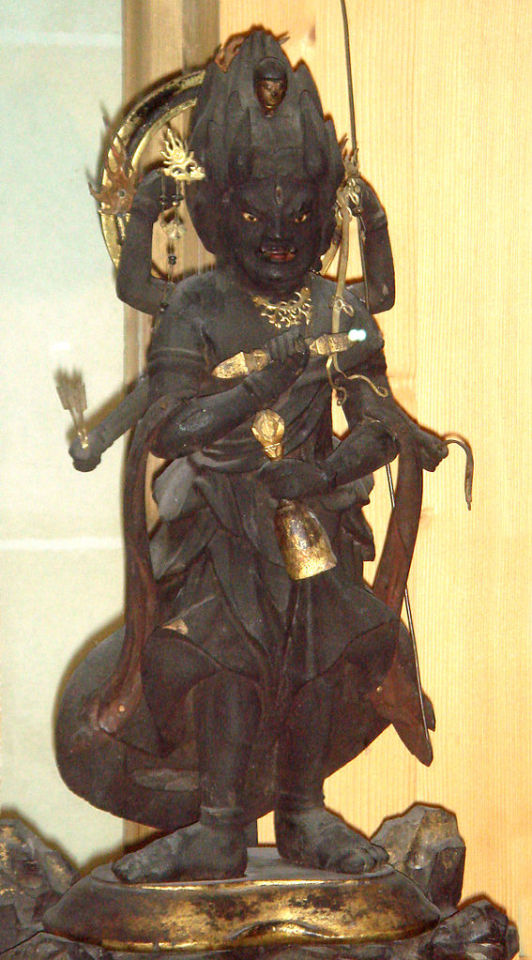
Kōjin (wikimedia commons)
The former is probably one of the most complex deities to emerge over the course of history of Japanese religions. The name designates both an individual deity and an entire category of them. Kōjin’s main role in Buddhism can best be understood as a god or demon of obstacles that impedes one's efforts towards enlightenment unless property placated, sort of like a Japanese take on Mara so to speak, though paradoxically the seventeenth century Chōseiden (窕誓伝) by Ikū Shōnin (以空上人) he is described as the honji of Amaterasu, as opposed to a form of Mara.
However, it would be a disservice to limit Kōjin just to that. He (they?) spanned the entire spectrum of Japanese religions, taking roles as diverse as those of a “raging deity” (araburugami - written with the kanji as his name), and even that of a domestic "stove god". Due to the sheer volume and complexity of the material there is simply no way of doing Kōjin justice here. You will have to depend on other sources if you want to find out more. Avoid the wikipedia article though, it’s dreadfully bad. A more reliable treatment can be found in Bernard Faure’s recent monograph Rage and Ravage.
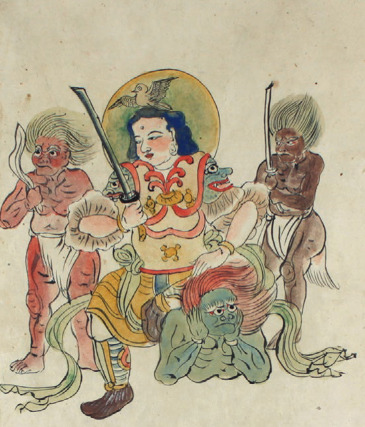
Kenrō Jishin (via Bernard Faure’s Rage and Ravage; reproduced here for educational purposes only)
Kenrō Jishin is at least in origin the Buddhist form of Hindu Pṛthvī, a divine representation of the earth, though the name sometimes designates a male deity whose character was more influenced by Chinese Tu Gong. His perception in medieval Japan was ambivalent, and he had to be placated with special rituals to prevent harm, for example during building activities
Speaking of earth, it has also been pointed out that describing Mara as an earthly deity creates a dichotomy between him and Amaterasu in some ways analogous to that between her and the earthly deities lead by Okuninushi in classical mythology. This argument has already been made in the middle ages, with Reikiki Shishō outright identifying Mara with Okuninushi.
References to conflict between Mara and Amaterasu are quite common in medieval literature. For example, the Taiheiki, one of the best known Japanese historical epics, states that Mara sealed a contract with Amaterasu with his own blood, guaranteeing that her descendants will rule Japan with his permission and will be protected by his 180000 servants. The antagonism is also referenced when the monk Jōkei on his pilgrimage to Ise has a vision of Mara and his minions plotting the Jōkyū Disturbance, and concludes it was sent to him by Amaterasu. The same monk encounters Mara in the noh play Dairokuten (第六天), also on his way to Ise. In this case the demon king physically appears in front of him, only to be repelled by Susanoo, here evidently not plying his classical role as his sister’s rival.
While obviously the intent of the myth was to portray Mara as the villain and Amaterasu as the protagonist, as one can expect in the light of their roles elsewhere, a different interpretation kept reemerging every now and then.
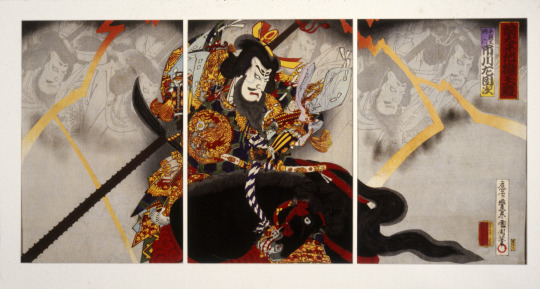
Taira no Masakado (wikimedia commons)
Among opponents of either the imperial court, the Buddhist authorities, or both, especially in the east of the country, Mara could sometimes be recognized not as a vanquished enemy, but rather than as a legitimate ruler deposed through lies and trickery. Both the most famous rebels, like Tairo no Masakado, and entirely obscure ones, like fourteenth century noble from the Tsugaru peninsula, Tsugaru Andō (津軽安藤), could be linked, if not outright identified, with him. Bernard Faure notes that this image of Mara as an “anti-establishment” figure seemingly persisted as late as WWII, as prayers to him were reportedly held to spare one from conscription.
Mara at Ise, or how Izanagi became Ishanaten
While as far as I am aware the Amaterasu version of the medieval Japanese myth of Mara was the most widespread and influential, and it is also the most often discussed in modern scholarship, it is worth noting at least one more kami could take the role of a protagonist making a pact with the Demon King of the Sixth Heaven: Izanagi.
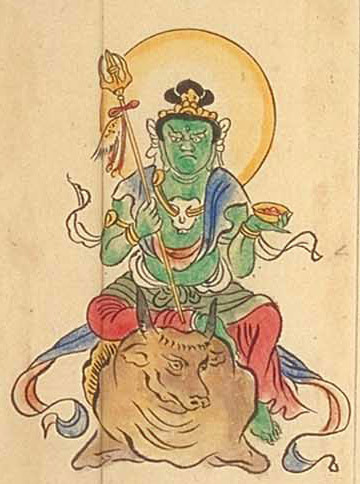
A Japanese depiction of Ishana from the twelfth century (wikimedia commons)
An early account of this tradition can be found in the record of the Ise pilgrimage of the monk Tsūkai (通海; 1234–1305), the Tsūkai Sankei Ki (通海参詣記). Reportedly a shrine attendant told him that Izanagi and Izanami were only able to create Japan after getting the permission of Mara, which required promising him Buddhism would be forbidden at Ise. Tsūkai was not enthusiastic about this idea, and by own account destroyed the attendant with facts and logic pointed out that doesn’t seem to line up with classical mythology. In response he heard that it all makes sense when you take into account Mara is Ishana (伊舎那天; Ishanaten), and Ishana in turn is Izanagi. This argumentation didn’t win him over, and he retorted by pointing out it is unexpected a creator deity would need a permit, and furthermore that Ishana is a protector of Buddhism and would not seek to have it banned in any place. We are not told whether the argument continued past that.
Elsewhere, variants which largely resemble the Amaterasu narrative are recorded. One example is the kagura play Tenshō Daijin no Yamatorikoe (天照大神の山取り越), where Izanagi finds Mara when he lowers his spear into the sea, and manages to trick him into relinquishing a map granting symbolic rule over Japan. Interestingly, while this is rather obviously an adaptation of the classical myth known from Kojiki and Nihon Shoki, in which Japan is created by Izanagi and Izanami after they lower the spear Amenonuhoko into the sea, Izanami is absent, and Izanagi stands on Mount Sumeru in the beginning, rather than on a bridge linking heaven and earth.
It’s worth noting that while unconventional in some regards, the shrine attendant’s explanation preserved by Tsūkai does reveal some historical truth. It is agreed today that the incorporation of Izanagi into speculative Buddhist theology depended on wordplay. The name indeed has an obvious phonetic similarity to that of Ishana, who is one of the Buddhist directional deities. On top of that, Ishana rules over the northeast, which happens to be Japan’s location relative to India. Since before the failed Mongol invasions, the dominant view was that Japan was a small, peripheral kingdom far away from the religious centers of the world, it is quite likely that medieval Buddhist thinkers might have believed Izanagi was an allusion to Ishana all along.
Amaterasu’s other adversaries
Not only the protagonist could change in the Mara myth. Keiran Shūyōshū, which I’ve already mentioned in the Dakiniten sub-section of part 1, seems to allude to a version where instead of Mara, Amaterasu makes a deal with an anonymous king of the asuras. That’s pretty remarkable, since save for the astronomical Rahu and Ketu asuras are rather sparsely represented in medieval Japanese sources.

Gozu Tennō (wikimedia commons)
Another figure who might have been viewed as Amaterasu’s rival, though much less commonly, was Gozu Tennō, who you might remember from my Susanoo article (though there is a lot left to cover some day still). It is possible that narratives from medieval Tsushima in which Gozu Tennō acts a jinushi and explains his role in creation of Japan to Amaterasu represent a tradition which competed with the more widespread Mara myth. While Tsushima was a stop on the Ise pilgrimage, it has been suggested that the main local shrine might have actually viewed Ise as a rival at the time.

Pangu (wikimedia commons)
Amaterasu and Gozu Tennō are also referenced together in a myth about the children of “king Banko” (an adaptation of Chinese primordial figure Pangu, in this context identified as a Buddha), in which the protagonist, Gorō (五郎), is identified with Gozu Tennō, and learns she(!) cannot claim any part of her inheritance because in a past life she was Susanoo, while one of her older brothers was Amaterasu. The latter explains that while Susanoo has atoned for his misdeeds, they were still bad enough to incur dire consequences after reincarnation.

A Japanese depiction of the dragon king Sāgara (wikimedia commons)
Finally, there is a unique myth in which Amaterasu is similarly portrayed as the creator of Japan, though the events unfold completely differently. It is only preserved in a single source, Shintō Saimon (神道祭文) from 1695. While not quite “medieval”, I figured it’s worth discussing here too. Instead of Mara, the opposing force are unexpectedly the dragon kings, with Sāgara (娑竭羅竜王) singled out in particular. In the beginning, Amaterasu suggests destroying Mount Sumeru and using the rubble to create islands. The dragon kings are not keen on this, because they assume it would make their domain, the ocean, too narrow for their liking. Sāgara enlists the help of a “serpent-like demon king”, who coils thrice around Mount Sumeru to put an end to Amaterasu’s plan. Alas, she figures a way around that. With the power of the kanju jewel, she dries up the ocean and destroys the dragon palace. She then moves Mount Sumeru to a freshly created island. Part of it then breaks off and falls apart, creating numerous smaller islets around.
Kokugaku and its consequences, or why the medieval sources deserve more spotlight
While the selection of figures associated with Amaterasu listed in both parts of the article is relatively extensive, it’s supposed to be only a sample, not the sum of her (or their) medieval networks. There are many more which I simply cannot cover in detail, either because they aren’t relevant to these I decided to focus on, or because I don’t know enough or couldn’t find enough sources to offer coverage of similar quality.
I also largely limited myself to figures identified directly with Amaterasu, or at least those who were (or still are) closely associated with Ise, like Toyouke or Sankoshin. To delve into every single connection would be a gargantuan task. To attempt to insert new additions into Amaterasu’s family tree was hardly uncommon, for instance. To give you just a few examples: in the Awashima Saimon, Awashima Myōjin is described as her sixth daughter. However, as evidenced by the Nihon Shoki, a tradition presenting them as sisters existed too, with the Awashima deity identified as Wakahirume (on yet another note, in a distinct tradition Awashima Myōjin is a male deity identified with Sukunahikona). In yet another tradition, though, Wakahirume was identified with Niu Myōjin (丹生明神像) of Mount Kōya, who similarly came to be seen as a sister of Amaterasu as a result.
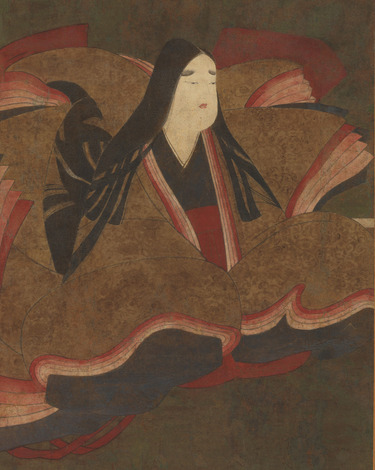
Niu Myōjin (Metropolitan Museum of Art)
Ultimately what the case of Amaterasu proves is that through much of Japan’s recorded history “Japanese mythology” was much more than just Kojiki and Nihon Shoki. Why are the medieval sources so obscure, then? This is just one aspect of a broader issue. It has been explored, among others, by Mark Teeuwen, who in a review concluded that “Kokugaku-type view of history has led Shinto scholars to focus heavily on the ancient period, to give scant regard to the medieval period, and to draw a straight line from ancient kami practice to modern Shinto.” Only over the course of the past few decades this started to change, and even though both in Japan and abroad there are now numerous researchers investigating the medieval sources, publications aimed at general audiences, let alone popculture, have yet to catch up.
Kokugaku, as you may know, was a style of “proto-nationalist” or more accurately “nativist” scholarship which developed in Japan in the Edo period. Its adherents believed in an imaginary untainted, pristine age of Japanese history which had to be recovered by purifying culture from foreign influence, defined by them as Chinese or Buddhist. Note that kokugaku itself originally arose, ironically, in neo-Confucian circles, obviously heavily influenced by Chinese culture.
The kokugaku movement, even by the standards of its times, had an incredibly authoritarian inclination, with its figureheads arguing that “graceful submission to higher power” is the “essential virtue of man,” as noted by Mark Teeuwen. This “higher power” was, obviously, the imperial family. That’s where the intellectual roots of later Japanese imperial project ultimately lie, as you can easily guess. Some kokugaku enthusiasts additionally lamented the loss of primal “manliness” which was purportedly an inherent attribute of the ancient Japanese spirit. All around, they were not too dissimilar from modern marble bust profile pic social media traditionalists, down to dubious, at best selective, knowledge of history.
Norinaga Motoori and other kokugaku luminaries argued that the Japanese “middle ages” were a “corrupt” era unworthy of study, during which the righteous primordial ways had been forgotten due to nefarious foreign influence. This imaginary past was centered on the Kojiki, and by extension on the imperial family. In Motoori’s imagination it has existed since times immemorial, long before Buddhism. Obviously, while we cannot actually tell for sure for how long a centralized Japanese state existed before the earliest records, it is safe to assume it was younger than Buddhism by a few centuries.
It should be noted that while Japan has a rich archeological record predating the advent of Buddhism on the archipelago, the early textual sources do not show full continuity with it. An obvious example are the haniwa figures, which appear frequently in burial mounds from the Kofun period. Hundreds if not thousands have been excavated, and they have been hugely influential when it comes to depicting kami in art from the 19th century onward. You’ve likely seen such depictions even if you’re not fully aware of their origin.
However, while haniwa were evidently an important part of life in the Kofun period, as early as in the Nihon Shoki they appear to be a rather vague memory, and their origin story presented in that volume does not match any tangible evidence. It is therefore hard to argue that Kojiki and Nihon Shoki are absolute historical truth: all they actually provide us with is information about what was the desired image of the past according to the imperial court in the early eighth century. As such they are obviously a valuable resource. However, can’t be treated as universal, and their importance doesn’t warrant suppression of anything that came later, contrary to what the kokugaku school wanted. Ultimately, each myth reflects a specific historical context, and to fully understand history sources from all periods need to be analyzed.
As I tried to illustrate in this article, the medieval myths reflected broader social phenomena: economic turmoil, theological advances, a fundamental curiosity about the world and more. And while obviously they have straightforward artistic merit as works of literature, with unexpectedly nuanced characterization of Amaterasu and Mara in the new creation myth standing out in particular to me, that is ultimately the main reason why I think they deserve more spotlight.
Bibliography
Anna Andreeva, Assembling Shinto. Buddhist Approaches to Kami Worship in Medieval Japan
Idem, “The Karmic Origins of the Morning-Bear Mountain”:Preliminary Research Notes on Asamayama Engi
Idem, Itō Satoshi, Chūsei Tenshō Daijin shinkō no kenkyū (Medieval worship of Tenshō Daijin [Amaterasu Ōmikami]), 2011 (book review)
Talia J. Andrei, Mapping Sacred Spaces: Representations of Pleasure and Worship in Sankei Mandara (dissertation)
Idem, The Elderly Nun, the Rain-Treasure Child, and the Wish-Fulfilling Jewel: Visualizing Buddhist Networks at the Grand Shrine of Ise
Frederick Chen, The Great God of the Five Paths (Wudao Dashen 五道大神) in Early Medieval China
Michael Como, Weaving and Binding. Immigrant Gods and Female Immortals in Ancient Japan
Lucia Dolce, Duality and the Kami: The Ritual Iconography and Visual Constructions of Medieval Shintō
Allan G. Grapard, Of Emperors and Foxy Ladies (got some methodological qualms about this article)
Nobumi Iyanaga, Buddhist Mythology and Japanese Medieval Mythology: Some Theoretical Issues
Idem, Medieval Shintō as a Form of 'Japanese Hinduism': An Attempt at Understanding Early Medieval Shintō
Idem (with Berthe Jansen), Dākinī in: Brill's Encyclopedia of Buddhism
Michio Kamikawa, Accession rituals and Buddhism in medieval Japan
Sujung Kim, Transcending Locality, Creating Identity: Shinra Myojin, a Korean Deity in Japan (dissertation)
Fabio Rambelli, Before the First Buddha: Medieval Japanese Cosmogony and the Quest for the Primeval Kami
Idem, Re-positioning the Gods: "Medieval Shintō" and the Origins of Non-Buddhist Discourses on the Kami
Idem, The Ritual World of Buddhist "Shinto": The Reikiki and Initiations on Kami-Related Matters (Jingi kanjō) in Late Medieval and Early-Modern Japan
Idem ( with Mark Teeuwen; eds.), Buddhas and Kami in Japan: Honji Suijaku as a Combinatory Paradigm
Asuka Sango, Buddhist Debate and the Production and Transmission of Shōgyō in Medieval Japan
Mark Teeuwen, Amaterasu Ōmikami in Brill’s Encyclopedia of Buddhism
Idem, Attaining Union with the Gods. The Secret Books of Watarai Shinto
Idem, Comparative Perspectives on the Emergence of Jindō and Shinto
Idem, Kokugaku in: Encyclopedia of Asian Philosophy
Idem, Motoori Norinaga on the Two Shrines at Ise in: Donald S. Lopez (ed.), Religions of Asia in Practice. An Anthology
Idem, The Buddhist Roots of Japanese Nativism in: Challenging Paradigms. Buddhism and Nativism: Framing Identity Discourse in Buddhist Environments
Idem, The Kami in Esoteric Buddhist Thought and Practice in: Shinto in History. Ways of the Kami
Idem, The Laŏzĭ and the emergence of Shintō at Ise
Idem (with John Breen), Social History of the Ise Shrines. Divine Capital
Idem (with Hendrik van der Veere), Nakatomi Harae Kunge
67 notes
·
View notes
Text
Tenshō Daijin: the many guises of medieval Amaterasu (part 1)

I’ve been working on this article on and off since late 2021, and it’s the longest one I’ve published on my blog so far (some of my wikipedia contributions are bigger, but that’s a separate matter). In fact, it's so long I have to split it into two due to limitations of tumblr's post editor.
When most people speak of “Japanese mythology”, 99% of the time they effectively think just of the Kojiki and Nihon Shoki (with some night parade scrolls sprinkled in, maybe, even though that’s not really mythology, but Edo period popular entertainment). The goal of this article is to challenge this incorrect view, and to shed some light on the mythology of the Japanese “middle ages” - roughly between the 11th and the 16th centuries.
I decided to use Amaterasu as the main topic, as it’s hard to think of a better way to showcase how much mythology remains outside the general perception than using a figure who, at least at first glance, is well known as an example. From Brahma longing for a friend to Yang Guifei surviving own death, I’m sure everyone will find something new here.
Myths obviously aren’t all that will be covered here, though. I’ll also discuss the theological doctrines which flourished in the middle ages, with a particular emphasis on honji suijaku, their social context, and more. You will be able to find out what rituals focused on Amaterasu had to do with Enma and Taizan Fukun, how economic woes of the Outer Shrine of Ise impacted Brahma’s role in Japan, why some secrets existed only to be deliberately revealed, and more.
Kami and Buddhism
In order to discuss the development of Amaterasu’s character and her associations with other figures through the middle ages, as well as the myths which developed as a result, I’ll first need to summarize the nature of interactions between kami and Buddhism through the Nara, Heian and medieval periods. I’m specifically saying kami, as opposed to Shinto, for reasons which will become clear later.
It seems that at first the relation was rather standard as far as early interactions between Buddhism and preexisting religious traditions in areas where it was introduced go. Mark Teeuwen singles out Tibet and various kingdoms corresponding to parts of present day Myanmar as examples particularly similar, though obviously not identical, to early Japan. The parallel developments concerned the Bön faith in the former and the beliefs pertaining to the nat in the latter.
The early sources appear to indicate that kami were envisioned as beings who need to strive towards enlightenment themselves. Recitation of sutras was described as a way to bring them closer to that state. However, some rather quickly started to be viewed as active protectors of Buddhism. As early as 741 Hachiman was already regarded as such, for instance. Additionally, combinative “shrine-temples” already existed in the same period too, attesting to a fusion of Buddhism and preexisting tradition.
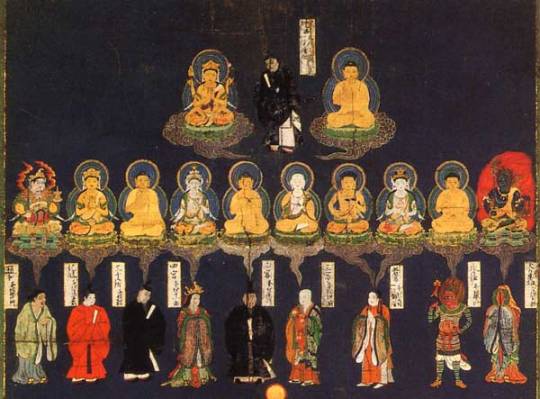
A schematic representation of some examples of the honji suijaku from the Kasuga mandala (wikimedia commons)
A breakthrough occurred in the ninth century, with the development of honji suijaku (本地垂迹) - the theory on kami being “traces” or “emanations” (suijaku) of Buddhist figures, referred to as “original sources” (honji). Similar theories regarding Daoist figures were at times advanced by Chinese Buddhist scholars as early as in the fifth century, so it was hardly an unparalleled development, though its scope was fairly unique. By the end of the Heian period, honji suijaku became the default mode of understanding kami.
A common misunderstanding today is that honji suijaku meant exact correspondence between a single Buddha and a single kami. In reality, what it created is a “fluid pantheon”, to borrow the title of one of Bernard Faure’s books dealing with this phenomenon. Connections between specific kami and Buddhas (or bodhisattvas) certainly were often established. However, that was not all.
Kami could be connected to other kami, and Buddhas to other Buddhas; and on top of that both groups belonged to an elaborate network which also included devas, wisdom kings, astral deities, legendary heroes and historical figures from various countries (for example Daoist immortals), and beings which defy classification altogether. In Keiran Shūyōshū (溪嵐拾葉集), the notion of honji suijaku is even extended to silkworms (their honji is Aśvaghoṣa). Multiple identifications could coexist, sometimes in the same sources. On top of that, individual figures could change classification depending on context.
The new theological ideas also lead to the formation of new myths, collectively referred to as chūsei shinwa (中世神話; “medieval mythology”). As summarized by Sujung Kim, this term encompasses both the myths which arose in the Japanese “middle ages”, the Kamakura and Muromachi periods (1185-1600), and modern study of them. A closely related, though more narrow, term is chūsei nihongi (中世日本紀), which refers specifically to reinterpretations of preexisting classical myths, for example Nihon Shoki, from the same times.
One of the primary goals of the new myths was to create a metaphorical bridge between Japan and the lands described in Buddhist literature transmitted from China, Korea and beyond. Sutras and other literature were often set in fabulous distant kingdoms or in supernatural realms. At the same time, the material reality of Buddhism tied it to local institutions and landscape. As a result, the local was imbued with a new, universal meaning.
As Mark Teeuwen put it in his article The Buddhist Roots of Japanese Nativism, medieval literature “allowed a local warlord to pose as a golden cakravartin, a local mountain to take on the guise of the cosmic Mt. Sumeru, a local deity to embody an aspect of the World Buddha, and a local rite to aspire to the universal aim of bringing salvation to all sentient beings.” At the same time, the universal gained a local dimension, making it easier to grasp and more approachable.
However, that was hardly the end, more like the beginning - yet another prominent change which occurred over the course of the 12th and 13th centuries resulted in the formation of a new belief: select kami were in fact not emanations of secondary importance of Buddhist figures, but direct representations of enlightenment. These developments eventually culminated in what is sometimes described as “reverse honji suijaku”: Buddhas and bodhisattvas were merely manifestations of primordial kami, not the other way around.
The motivations behind the development of these ideas are not clear. While especially in the past it was commonly assumed that they represented the beginning of a “pristinely Japanese” spirituality reasserting itself against “foreign” Buddhism, most of the theologians involved were Buddhists themselves, or at least enthusiastically drew inspiration from Buddhist sources. Mark Teeuwen and Fabio Rambelli suggest they might have been motivated by a desire to take Buddhist theology to logical extremes in order to investigate the nature of reality before the emergence of the first Buddha and the current kalpa.
Furthermore, in addition to lofty theological speculation material motivations might have been at play. Many of the advocates of reverse honji suijaku might have been so-called “shrine monks”, tasked with maintaining the shrine parts of religious complexes. Possibly their need for broader recognition and greater authority made them keen on such theological reversals. This is ultimately speculative, though.
Curiously, reverse honji suijaku arguably might have led to the creation of Shinto in the modern sense. While the phrase 神道 has a long history, and it is applied to intellectual and religious movements active in the middle ages in modern literature (for example, the treatises of a certain priestly family I’ll discuss are often called “Watarai Shinto”), there is no strong evidence that it was commonly read as shintō predating an explicit statement in a treatise from 1419 written by the Tendai monk Rysōhen dealing with these topics. In the earliest sources the default reading was jindō, referring not exactly to a distinct system of beliefs, but rather to a “realm”of kami ultimately existing in Buddhist context. While Shinto did eventually develop into a distinct tradition which came to define the kami, through the middle ages and the Edo period which followed, honji suijaku was the dominant paradigm, and permeated all spheres of society.
The early history of Amaterasu: sun, textiles and longing for companionship
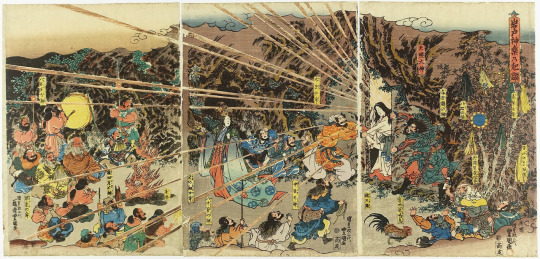
An Edo period painting of Amaterasu emerging from the cave, by Kunisada Utagawa (wikimedia commons)
While the explanation of the basic nomenclature and a crash course in interactions between Buddhism and kami is now out of the way, before I’ll be able to move on to the impact of the medieval ideas on Amaterasu I need to briefly summarize her earlier history.
Through the article I will simply use the name Amaterasu consistently. However, it should be noted that the standard form of the name, 天照大神, in the middle ages and in the Edo period was often read not as Amaterasu Ōkami, but rather as Tenshō Daijin, in accordance with on’yomi or “Sino-Japanese” sign values. Therefore, don’t be surprised that this is the version used in titles of historical works mentioned. As a curiosity it is worth mentioning that this is actually the reading used fairly consistently in the first western source with reasonably reliable information about Amaterasu (unless I missed something even earlier), Engelbert Kaempfer's History of Japan from 1727.
On a similar note, I generally stick to describing Amaterasu as female. However, it needs to be pointed out that through the middle ages and in the Edo period male Amaterasu is also attested, depending on the source either replacing the female version or coexisting with her. Some modern authors go as far as speculating if Amaterasu wasn’t originally seen as male prior to being redefined as female, but this is not really fully provable.
The existence of a tradition according to which Amaterasu manifested in male form is already mentioned by the Tendai monk Jien (1155-1225). There are also sources providing ambiguous information about Amaterasu’s gender. In at least some cases such phenomena were a result of identification with figures either regarded as male or portrayed as androgynous in art, as I outlined in a recent article discussing the case of Amaterasu and Uho Dōji (who won’t be brought up here in any meaningful capacity, since I'm not going to focus on the Edo period). It’s not really possible to make a blanket statement on this matter, though.
Additionally it’s important to bear in mind that identification between two figures could transcend the gender of the parties involved. As you’ll see later, there were even cases of Amaterasu’s identification with a male figure actually resulting in traditions particularly strongly emphasizing her typical gender.

The Inner Shrine at Ise in 2008 (wikimedia commons)
Throughout her entire history Amaterasu has been associated with Ise and its Grand Shrine. According to the Nihon Shoki, that’s where she originally descended from heaven to earth, and where she later returned in order to be enshrined. The term “Ise Grand Shrine” actually refers to a complex centered on two major shrines, though, and only one of them, the Inner Shrine (内宮, naikū), is dedicated to Amaterasu. The kami of the Outer Shrine (外宮, gekū) is instead Toyouke.
The earliest history of Amaterasu is effectively unknowable due to lack of available sources. While she does appear both in the Kojiki and Nihon Shoki in a central role, both of these works only date to the eighth century, and their historicity is often at best dubious. When exactly was her shrine originally established is a matter of debate: supporters of treating Nihon Shoki literally argue for 4 BCE (during the reign of the legendary emperor Suinin), but historians and archeologists favor more vague dating to either the fourth, fifth or seventh century. The earliest detailed records of specific religious ceremonies at Ise can only be found in an administrative protocol compiled in 804.
Historically it was quite popular among researchers to essentially assume being a personification of the sun is all there ever was to Amaterasu’s character, and that she derives her importance entirely from her solar role. Today this view is no longer accepted quite as firmly, and it is even sometimes questioned if this was necessarily her original function, though this is ultimately neither entirely provable nor fully relevant here.
Obviously, the classical Amaterasu also served as a royal deity presented as an ancestor of Japan’s imperial lineage. She was also treated as a symbolic source of its authority by extension of her role as a heavenly ruler commanding the kami. This is an example of the well documented phenomenon of clan kami (氏神, ujigami). However, based on archeological data Ise was not particularly important early on in Japanese history, and the area around it was sparsely populated as late as in the seventh century On top of that it would appear that, if the early texts are to be believed, emperors actually had an ambivalent relationship with her. It has been suggested that her classical position was only established during the reign of emperor Tenmu in the late seventh century, perhaps due to his personal connection to clans from the Ise area.
It’s important to stress here that on multiple occasions in history, in particular recent history, the connection between Amaterasu and emperors was channeled to nationalist and imperialist purposes. For instance, the Japanese colonial government in Korea funded the construction of a complex enshrining Amaterasu and emperor Meiji in the 1920s, and subsequently legally obliged students (among others) to attend ceremonies held there to foster loyalty.

The Outer Shrine in 2015 (wikimedia commons)
A key moment in the early history of Amaterasu was the introduction of the kami Toyouke (豊宇; literally “abundant food”) to Ise. A legend about her arrival is preserved in the aforementioned administrative protocol from 804. According to it, Amaterasu appeared to emperor Yūryaku (second half of the fifth century, if his historicity is to be accepted) in a dream to let him know that she is distressed and lonely, and on top of that can’t receive offerings of food according to proper protocol. She explained that the only way to solve all of these problems is to bring her a kami responsible for divine food (御饌津神, miketsu kami), Toyouke, who is to be found in Hiji no Manai in the Tanba Province. Thanks to this precise guidance, the emperor was able to instantly solve the problem, and Toyouke was moved to Ise, where she symbolically took the responsibility for food offered to Amaterasu.
Presumably, the legend contains at least a kernel of truth, and Toyouke was initially enshrined in a facility meant to fulfill a specific ritual role for the Inner Shrine, which in time grew to rival it in size and importance. Save for these details, much about the early history of Toyouke is even more unclear than in the case of Amaterasu, though. She is only mentioned in passing in the Kojiki under the name Toyoukehime no Kami (豊受姫神) in the account of the birth of Wakumusubi no Kami (和久産巣日神), one of the many kami who came into being as a result of Izanami’s death. However, this passage does not provide any information about her character, it merely states that she is Wakumusubi’s child. This tradition was of limited, if any, interest to the Outer Shrine clergy through the middle ages, as I’ll later demonstrate.
While Wakumusubi also appears in the Nihon Shoki, though with a slightly different genealogy, Toyouke is entirely absent from this work. You can find a claim on the contrary in Michael Como’s Weaving and Binding. Immigrant Gods and Female Immortals in Ancient Japan, but he essentially treats Ukemochi as identical with Toyouke and asserts the myth about Tsukuyomi killing the former is effectively about the latter. It doesn’t seem like any subsequent publications picked up this idea.
The final early source of information about Toyouke is the Tango no Kuni Fudoki (丹後国風土記; “Records of the Tango Province”). It presents her as one of eight “heavenly women” (天津乙女, amatsuotome) who at some point arrived at a spring near Mount Hiji to bathe. An old couple stole the clothes of one of them, rendering her unable to return to heaven. They subsequently ask her to become their daughter, since they have no children. She agrees, and for ten years lives with them, brewing sake which could magically heal “ten thousand ills”. The old man and woman prosper thanks to her. However, they eventually decide to tell her that she is not really their child, and should go back to heaven. She tells them that she has lived among humans for so long this is not an option for her anymore, and leaves in anger. She only calms down after reaching a different village, Nagu, where she is eventually enshrined under the variant name Toyoukanome no Mikoto (豊宇賀能売命).
Due to involving a heavenly being having to stay on earth due to her clothes being stolen, this myth has been compared to the better known Hagoromo. Michael Como also argues that it might reflect the perception of Toyouke as a Daoist immortal (hence her ability to bew something akin to the fabled Daoist alchemical elixirs meant to prolong life), similarly to how the legend of Urashima Taro does. While I found his Nihon Shoki argument somewhat dubious as I said, I think this is an interesting point which warrants further study. Similar possibility about Toyouke’s character has been suggested by Bernard Faure too.
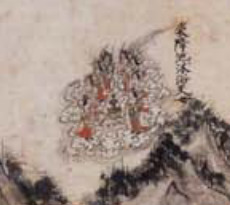
It’s also worth noting a possible reference to the Tango no Kuni Fudoki myth has been identified in a painting of the two shrines of Ise from the collection of Shōryakuji, a Buddhist temple located in Nara (seen above; screencapped from Talia J. Andrei's Mapping Sacred Spaces: Representations of Pleasure and Worship in Sankei Mandara, for educational purposes only). It depicts eight female figures standing on a cloud around a container used to make sake in the proximity of the Outer Shrine.
Amaterasu and Buddhism: the ambivalent beginnings
Early sources pertaining to Ise discussed in the previous section are invaluable when it comes to Amaterasu’s position and her connection with Toyouke, but they don’t really shed any light on the development of associations between her and Buddhist figures. Quite the opposite - they indicate that around the year 800, even basic Buddhist terms like “pagoda”, “monk” or “sutra” were considered taboo (忌み, imi) by priests of the Inner Shrine, much like these pertaining to conventional sources of religious impurity like violence, death or illness. However, Mark Teeuwen notes at the same time these very priests most likely took part in Buddhist ceremonies themselves, and there is even some evidence that in the eighth century a Buddhist temple existed in Ise.
The reasons behind the implementation of the taboo were likely largely political, rather than strictly religious. For context: in the second half of the eighth century, empress Shōtoku famously appointed Buddhist monks to various prestigious positions in the royal court. Dōkyō from the Hossō school was even temporarily elevated basically to the rank of her equal (though he eventually fell from grace). This was generally poorly received by other officials, who might have viewed it as an attempt at establishing Buddhist theocracy in place of hereditary monarchy. This in turn likely led to tensions and fueled various succession controversies in subsequent decades. Further problems, like untimely deaths or exile of various members of the imperial family, kept accumulating, and by 804 the prestige of the court was severely damaged. Furthermore, there is evidence that there were various economic conflicts of interest between the Ise clergy and local Buddhist monks.
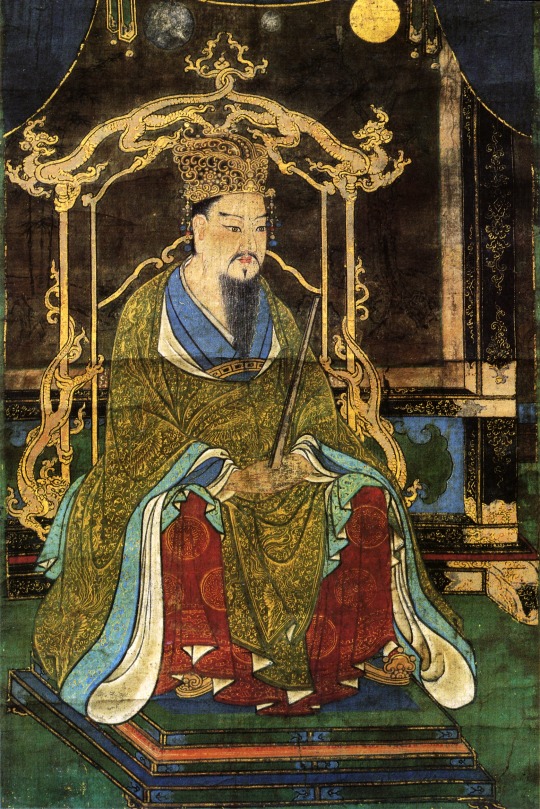
A sixteenth century painting of emperor Kanmu (wikimedia commons)
Since the oldest source to mention the taboo is an administrative, rather than religious, text, it is not impossible that it was intended by emperor Kanmu as a way to diffuse all these social and political tensions. Mark Teeuwen suggests his goal might have been a way to restore the prestige of his family and create a center of symbolic ancestral cult which would offer him additional legitimacy independent from the Buddhist establishment residing in Nara, which was crucial for many of the previous emperors. As a lifelong student of Confucian philosophy, he likely found many models to draw from in Chinese texts. His vision of Ise was presumably that of an ancestral mausoleum.
Regardless of Kanmu’s decisions, in the long run Buddhism retained its influence in royal affairs. In fact, it was arguably this emperor himself who indirectly caused its revitalization. In 804, he sent two young monks, Saichō and Kūkai, to China. They returned with something previously largely unknown in Japan: esoteric Buddhism. The new schools they established, Tendai and Shingon, captivated the imagination of virtually all strata of society in the nascent middle ages.
Amaterasu, too, came under esoteric Buddhist influence, and gained new roles, often completely detached from her earlier character - or at the very least from the part of it firmly tied just to the ruling family. Mark Teeuwen partially jokingly refers to this chapter in her history as an “escape” from Ise and notes that for a time she has “shaken off the imperial shackles”.
There was a material aspect to these processes in addition to the purely theological considerations. In the Kamakura period, the role of warrior classes grew and the imperial court weakened. As a result, the Ise clergy - the Arakida clan of the Inner Shrine and the Watarai clan of the Outer Shrine - gained greater autonomy. The emperors weren’t able to enforce a symbolic monopoly on Ise, which therefore no longer served just as a center of ancestral cult. The downside was the loss of most of the imperial funding, which necessitated innovation to secure other sources of patronage.
The Ise taboos established earlier were not exactly abandoned, but the clergy found ways around them in order to enable Amaterasu to thrive in this new environment. A summary of the theological solution they developed is provided in Nakatomi Harae Kunge (中臣祓訓解; “Reading and Explanation of the Nakatomi Purification Formula) from the late twelfth century: “although on the surface performing ceremonies which are different from the Buddhist teachings, [Amaterasu] in essence protects the Buddhist laws.” Additionally, a myth reinterpreting one of the most famous episodes from the entire Buddhist canon, but with Amaterasu as a new protagonist, was developed to justify the taboo’s existence. I’ll discuss it in a separate section later on.
The reinvention was evidently successful. There is little evidence for widespread worship of Amaterasu in earlier periods. She was effectively little more than a royal deity. Even courtiers had limited, if any, knowledge of her. Only in the middle ages did she come to be widely recognized as a major figure in the Japanese religious landscape among all strata of society. Paradoxically it was the partial detachment from the imperial family that let Amaterasu claim a uniquely elevated position in the pantheon.
One of the best sources of evidence of Amaterasu’s newfound popularity are standardized oath formulas (起請文, kishōmon). In the Kamakura period, she came to appear in them quite frequently. She was invoked either simply as the foremost kami, or alternatively as the “lord of the land” (ie. Japan; 国主, kokushu). Either way, her purpose, much like those of other of the invoked figures, was to guarantee the oath will be upheld, and to punish those who will break it.
The spread of Amaterasu to new audiences resulted in the rise of numerous new interpretations. That’s where the already briefly discussed idea of honji suijaku came into play.
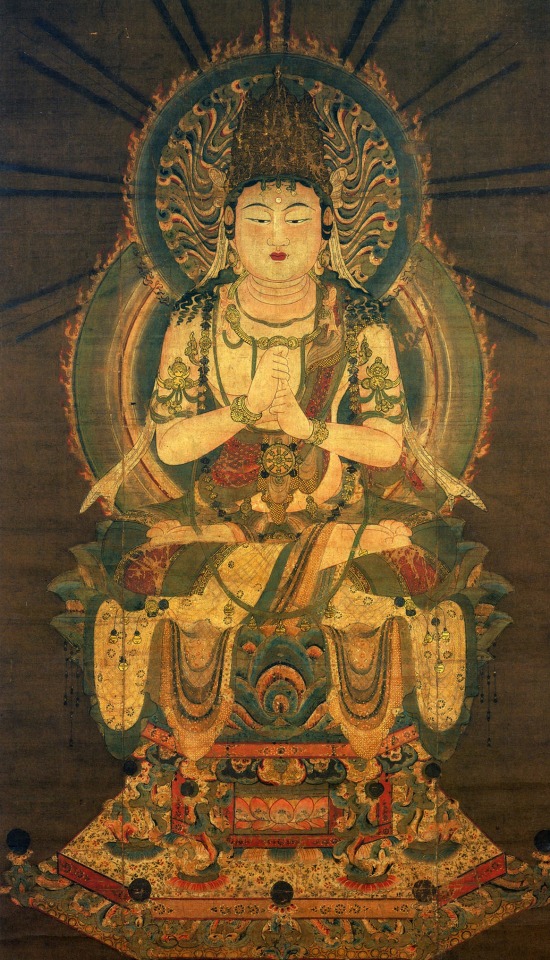
A twelfth century painting of the Buddha Dainichi (wikimedia commons)
As I said earlier, despite the popular understanding of this term honji suijaku did not necessarily just signify correspondences between kami and buddhas. However, in Amaterasu’s case the earliest example actually does match this model. She came to be associated with the Buddha Dainichi (大日, literally “great sun”; from Sanskrit Vairocana).
Some authors, like Bernard Faure, argue that the establishment of a link between Amaterasu and Dainichi was effectively the core of the early honji suijaku as a whole. Purportedly the belief that a connection existed between them went all the way back to the teachings of the famous monk Gyōki, active in the first half of the eighth century. The historicity of this claim is uncertain, but it was understood as historical truth in the discussed time periods, at the very least. Anna Andreeva, relying on earlier studies by Satoshi Itō, notes that it would appear Seizon’s (成尊; 1012–1074) Shingon Fuhō San'yōshō (眞言付法纂要抄; “An Abbreviated Compendium of the Transmission of Shingon Buddhism) from 1060 has a strong claim to being the oldest attested example which can be properly dated.
While other Buddhas, such as the historical Buddha, Amida (Amitābha), Miroku (Maitreya) or Yakushi (Bhaiṣajyaguru), are obviously also present in Japanese Buddhism, historically, especially prior to the rise of Amida-centrist schools, Dainichi was by far the most important one. This is especially pronounced in Shingon, where he is recognized as the “first Buddha” (Ādi-Buddha). Dainichi’s importance coupled with his solar associations made him a suitable match for Amaterasu in the eyes of theologians.
Amaterasu’s solar role is pretty widely acknowledged in Buddhist sources, and she could be labeled as a “solar deity”, nisshin (日神). She was also identified with Nittenshi (日天子), the Buddhist version of the Hindu sun god Surya. However, Nittenshi could also function as a distinct figure and had his own iconography.
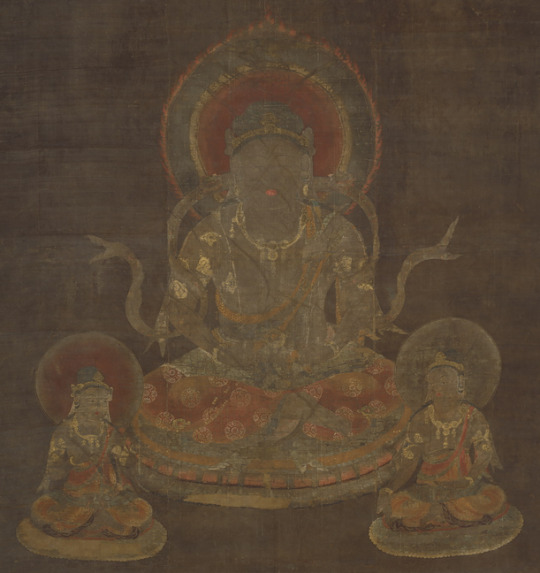
A twelfth century hanging scroll showing Nittenshi in the company of attendants (Kyoto National Museum; reproduced here for educational purposes only)
The development of a connection between Amaterasu and Dainichi brought a number of changes to Ise. As an extension of it, the Inner Shrine and Outer Shrine at Ise came to be identified with the Womb Realm mandala and the Diamond Realm mandala, closely associated with him.
The Ise clergy additionally argued that the taboo observed as the shrines does not impact Amaterasu’s connection to Dainichi - rather she (and by extension Toyouke as well) represents not a mere trace of this Buddha, but “original enlightenment” (hongaku). A new systematization of kami was built around the idea: at Ise, only Amaterasu and Toyouke were regarded as belonging to the category of “kami of original enlightenment”, with other divided into “kami of inception of enlightenment” (those who had to actively embrace Buddhism) and “kami of delusion” (those who opposed it). Similar categories were employed in different areas too, though, with the head local kami, for example Suwa Daimyōjin or Sannō (山王), taking the same role as Amaterasu at Ise.
While Dainichi can be considered Amaterasu’s essential honji suijaku pair, I already pointed out, it was hardly unusual for a specific figure to develop multiple connections within the honji suijaku framework, though, and this holds true for her too.
Amaterasu, Enma and other functionaries of the underworld
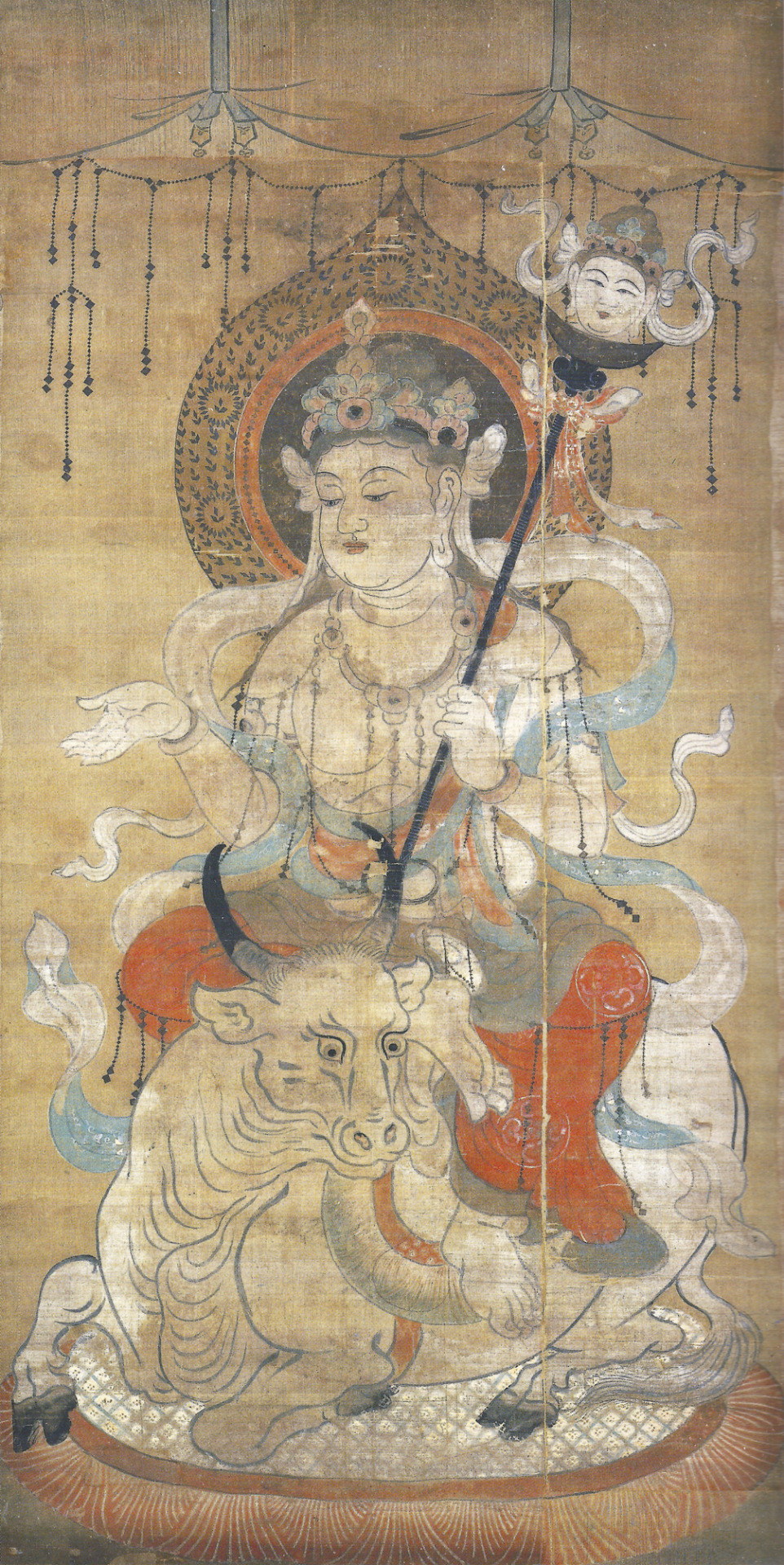
Enmaten (wikimedia commons)
Next to Dainichi, Amaterasu’s best attested Buddhist “counterpart” is not a Buddha, but rather a deva, specifically Enma, the judge of the dead. While many other devas present in Japanese Buddhism largely languish in obscurity today, at least in popular perception, he is probably the most recognizable one next to the Four Heavenly Kings, so I do not think much of an introduction is needed. Even if you are not particularly interested in the history of religions, chances are you’ve seen him in one piece of media or another.
Technically there are two distinct forms of Enma in Japanese tradition - Enmaten (焔摩天), who is more of a “classical” Hindu-style deva fairly similar in appearance to the original Yama, and the more popular Enma-ō (閻魔王; “king Enma”), styled after the bureaucratic Chinese underworld deities - but this distinction is not very important here. His rise to prominence in Japan started in the early ninth century at the latest, and by the ten century he was also joined by Taizan Fukun (東岳大帝; originally Taishan Fujun), a similar deity incorporated into Buddhism from Daoism. The latter was essentially the model for all of the other judges of the underworld: from the Buddhist kings of hell, to various local gods who took this role in the popular religion of Qing China. He might have even influenced the development of Matarajin in medieval Japan, but that’s a topic for another time.
It seems that a link between Amaterasu and Enma was initially established through an intermediary, specifically Seoritsuhime (瀬織津姫). She is identified with the king of hell in the Nakatomi Harae Kunge. While much about this text remains a mystery, in this case the logic behind the equation is quite clear - both of them were invoked during ritual purification. The means were not quite the same: Enma throws the sources of impurity into the deepest hells, while Seoritsuhime casts them into the ocean. Still, the level of similarity was sufficient to warrant establishing a connection.
Seoritsuhime is described both as a servant of Amaterasu, and as her aramitama (荒魂), literally “rough spirit”. This term designates the wrathful, or at least impulsive, aspect of a given kami. In Nakatomi Harae Kunge Seoritsuhime as a manifestation of Amaterasu is also more specifically described as ara-tenshi (荒天子), “heavenly emperor manipulating the brutish force”.
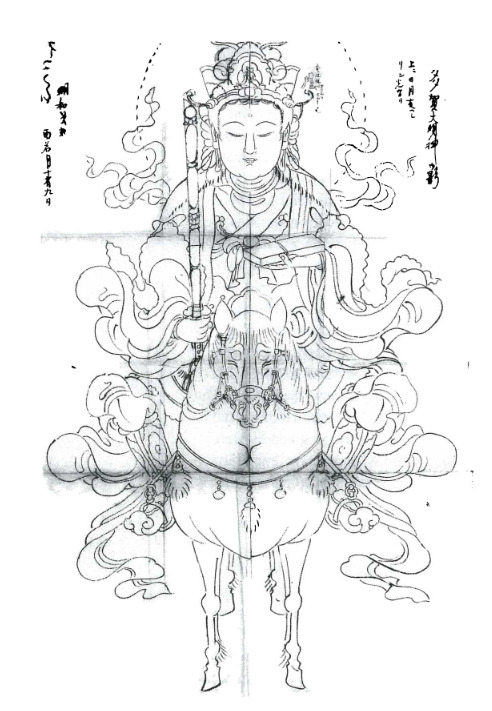
An Edo period depiction of Taga Myōjin from the collection of Kyoto City University of Arts (via Bernard Faure's Fluid Pantheon; reproduced here for educational purposes only)
Tenshō Daijin Kuketsu (天照大神口決; “Oral Transmission Pertaining to Tenshō Daijin”), a fourteenth century theological treatise, also embraces the equation between Enma and Amaterasu. It explains that he corresponds to the form of Amaterasu associated with the Taga shrine, Taga Myōjin (多賀明神). She has a distinct iconography, and fairly consistently appears as a horsewoman on either a black or white steed (always shown frontally), with a sword in one hand and a box with a sutra in the other.
The same source also equates Amaterasu with Godō Daishin (五道大神; originally Wudao Dashen), the “god of the five paths”, another king of hell. In the Nakatomi Harae Kunge, it is instead a purifying kami, Haya-Akitsuhime (速秋津比売神), “the beloved of the dragon king Nanda”, who corresponds to him, though. The passage establishing this also mentions a similar link between yet another purifying kami, Ibukidonushi, and Taizan Fukun (curiously, the explanatory line states that the river where Izanagi purified himself after fleeing from Izanami is identical with Mt. Tai, the residence of Taizan Fukun). However, the latter is also said to be the aramitama of Toyouke.

A Japanese statue of Baozhi (Kyoto National Museum; reproduced here for educational purposes only)
Tenshō Daijin Giki (天照大神儀軌; “A ritual manual [for the worship] of Tenshō Daijin”) states that Amaterasu as a judge of the dead commands eleven messengers referred to as “princes”. It’s not easy to date this text precisely, though it’s clear it was already in circulation by 1164. It claims to contain knowledge originally revealed to the legendary Chinese monk Baozhi (寶誌; 418-524), best known from a legend commonly referenced in art in which he tears his face apart to reveal the visage of bodhisattva. The text effectively redefines Ise itself as a place where the underworld officials gather, imbuing the temple complex with new meaning, detached from its older role as a center of royal ancestor cult.
The eleven messengers listed are Zuikō Tenshi (a manifestation of Enma), Ryūgū Tenshi (dragon king Nanda), Suijin Tenshi (dragon king Batsunanda), Tenkan (“magistrate of heaven”), Chikan (“magistrate of earth”), Shimei (an underworld official), Inin Tenshi (equated with Izanagi and with Shiroku, an underworld official paired with Shimei in other sources), Kōzan Tenshi (Taizan Fukun), Godō Daishin, Kazenagashi no Kami and Okitama (a water deity equated with Suikan, “magistrate of water”). They correspond to various auxiliary shrines at Ise. Each of them is said to command a retinue of “four thousand trillion spirits”. While abstractly big entourages are quite common in medieval sources, from Michizane’s 105000 thunder god subordinates to Tenkeisei’s 84000 shikigami, even by these standards the number is unusually high.

The Enmaten mandala, with Taizan Fukun (middle of the top row) and Shimei, Godo Daishin and Shiroku (bottom row) shown among his attendants (wikimedia commons)
The lists of underworld officials serving Amaterasu show a considerable degree of overlap with these present in ritual texts Enmaten Ku (閻魔天供) and Taizan Fukun no Sai (泰山府君祭; you may know it from the story of Tamamo no Mae). Notably, Tenkan, Chikan, Suikan, Shimei and Shiroku are all members of Enma’s entourage in origin. The last two are scribes responsible for keeping track of human lifespans, but the role of the former three is not well understood.
Another deity present both in these rituals and in Amaterasu’s entourage, Godo Daishin, is a king of hell in his own right. His origin is unclear, though the oldest sources which mention him are Chinese apocryphal episodes from hagiographies of the historical Buddha. As the “god of the five paths”, he is responsible for assigning the dead to one of the five realms of rebirth: these of gods, humans, animals, hungry ghosts or hell. Notably missing is the asura realm, which didn’t particularly catch on in East Asian Buddhism. In the oldest sources, he is portrayed as somewhat inept and after meeting the Buddha implores him to teach him how to fulfill his role better.
Enmaten Ku and Taizan Fukun no Sai attained a considerable degree of popularity in the eleventh and twelfth centuries due to the spread of the bureaucratic image of hell, and many laymen sought Buddhist monks (in the case of the former ritual) and onmyōji (in the case of the latter) who could perform them. They were supposed to heal illnesses, prolong life, secure an easy birth or simply to guarantee good fortune. It’s not impossible that furnishing Amaterasu with a similar role to their central deities was meant to let her clergy from Ise capitalize on the popularity of such rituals too. The spread of the new image of Amaterasu as a judge of the dead was also likely tied to her judiciary role in the already discussed oath formulas, where she essentially acts as a supernatural enforcer of legal claims.
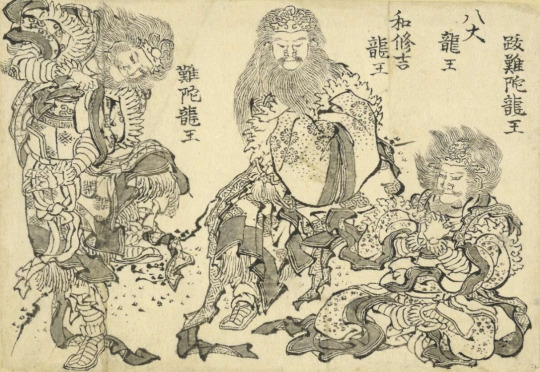
Hokusai's drawing of three dragon kings, including Nanda and Batsunanda (British Museum; reproduced here for educational purposes only)
The final matter that needs to be addressed here is the presence of dragon kings Nanda (難陀) and Batsunanda (跋難陀; Sanskrit Upananda) in Amaterasu’s underworld entourage. In contrast with their peers, they do not have anything to do with Enma. In Buddhist cosmology, they support the cosmic mountain Sumeru, on which the highest devas like Indra and Brahma reside.
More context on their connection to Ise is provided in the treatise Bikisho (鼻帰書), which cites the Outer Shrine priest Tsuneyoshi Watarai (度会常昌; 1263-1339) as its source. It actually states that all eight of the dragon kings are protectors of Ise, though also that only two, one blue and one white (with no names provided), can be used to represent respectively the Inner Shrine and the Outer Shrine. The connection is said to depend on their role as protectors of the Womb Realm and Diamond Realm mandalas. Multiple sources from Ise indicate they were believed to dwell under the central pillars of the Inner Shrine and the Outer Shrine, in this context additionally identified with the cosmic abode of the gods, Mount Sumeru.
Amaterasu, Toyouke and Brahma (times two)

Bonten, the Japanese version of Brahma (wikimedia commons)
While Dainichi made a natural match for Amaterasu, and the reasons behind her association with Enma, while less obvious, aren’t hard to understand either, the third Buddhist figure most commonly associated with her, Bonten, is quite surprising. This deity, the Japanese Buddhist guise of Brahma, has limited presence in popular understanding of Buddhism, but generally much like his Hindu forerunner he is portrayed as a distant deity with limited interest in everyday human affairs. And yet, in medieval Japan Brahma was identified with a figure both commonly worshiped and understood as quite active.
This tradition is documented in Tenshō Daijin Giki. It reaffirms that Amaterasu - seemingly treated as a male figure in this case - is the Japanese guise of Dainichi. However, in the “Realm of Form” - a Buddhist term referring to the world inhabited by humans and deities - he takes the guise of Bonten, and acts as the deva king of Japan. His life will last a total of 105000 years, and he will defend exactly 1000 rulers over the course of this period, before ascending to the Realm of Form to hear the preaching of Miroku. He will also help the faithful reach it.
The already discussed Tenshō Daijin Kuketsu also recognizes the equivalence between Amaterasu with Bonten, though it also furnishes her with a similar connection to the other ruler of the devas, Taishakuten (Indra), and states that both of these equations depend on the doctrine of Abhidharmakośa. Perhaps more unexpectedly, the same work also equates Amaterasu with Shōten (聖天, literally “noble god”; a Japanese form of Ganesha), specifying that this reflects a Shingon view. However, the thirteenth century scholar Ieyuki Watarai (詳細表示; 1256-1356) in his Jingi Hishō (神祇秘抄; “Secret Comments about the Deities”) mentions a different tradition in which this god’s connection with Amaterasu is less direct. He is said to be identical with a nameless “heavenly fox” (天狐, tenko) who acts as her acolyte.
Yet another text already brought up in the previous section, Nakatomi Harae Kunge, does not equate Amaterasu with Brahma outright, but it does redefine terms from classical mythology around him. The High Plain of Heaven (高天原 Takamagahara) is said to be identical with the “First Meditation Heaven of the Realm of Form, ruled by Bonten”. Furthermore, the collective label Yaoyorozu no Kami (八百万の神; literally “eight myriad kami”) is said to encompass “Bonnō, Taishaku, the innumerable devas, the four Great Heavenly Kings, the innumerable devas of Bonnō, and eighty four thousand kami.”
The newfound interest in Brahma in the middle ages reflected an intellectual development arguably unparalleled in earlier Japanese religious tradition - a preoccupation with cosmology.
Kojiki and Nihon Shoki obviously do deal with this topic, but the relevant sections are incredibly brief. This new discourse about cosmology was, at its core, Buddhist, but a major issue was that Japanese Buddhism was not very concerned with cosmology either. The two main sources of inspiration were, therefore, not contemporary Buddhist literature, but Chinese (mainly Daoist) texts on one hand, and accounts of Hindu cosmology, especially the Puranas, preserved in Buddhist sources on the other. Figures such as Pangu, the Three Pure Ones, Shiva or Brahma as a result attained considerable renown among Japanese theologians, who reinterpreted myths about them to suit local context, creating new narratives in the process.

A contemporary statue of Kuni no Tokotachi (wikimedia commons)
In some cases the poorly defined primeval kami from classical mythology could be incorporated into the new visions of cosmology created in the middle ages. Ame no Minakanushi from the Kojiki and Kuni no Tokotachi present both in this work and the Nihon Shoki are both well attested in that context, though references to Ame Yuzuru Hi Ame no Sagiri Kuni Yuzuru Hi Kuni no Sagiri from the Sendai Kuji Hongi can be found too. They were effectively treated as almost interchangeable, or as stages of emanation of the same entity, as documented for example in the writings of the Tendai monk Jihen (慈遍).
Two strains of cosmological speculation, these focused on Brahma and primordial kami, were in particular enthusiastically embraced by the Outer Shrine clergy at Ise, who utilized both of them to improve the standing of Toyouke. As I mentioned before, her role, while seemingly initially relatively minor, grew with time. In many regards, she came to be presented as Amaterasu’s equal. She was furnished with an association with the moon to match Amaterasu’s solar character, for example. The first attempts at elevating Toyouke through theological speculation weren’t necessarily grand in scale. She was simply identified with other kami of similar characters every now and then, for example with Uka no Mitama. An isolated source, a letter from the early Kamakura period, appears to present her identical with Ninigi, Amaterasu’s grandson, instead, but this evidently did not stick.
A breakthrough occurred in the late thirteenth century. The outer shrine clergy developed a view that Toyouke didn’t originate as a servant brought in to deal with Amaterasu’s loneliness and other needs, but rather a primordial kami, identical with Ame no Minakanushi or Kuni no Tokotachi. Toyouke in this guise was the foremost kami of heaven, and Amaterasu “merely” the foremost kami of earth.
However, as I already pointed out, the new cosmologies which influenced this reinterpretation of Toyouke depended not only on classical mythology. Therefore, the Outer Shrine’s kami could also be identified with Brahma, or credited with controlling the proper flow of qi and thus yin and yang, following a Daoist model. Much of this theological speculation might have originated in the works of a single priest, Yukitada Watarai (度会行忠; 1236-1305), though he was far from the only contributor.
It’s worth pointing out that there was a practical material component to the theological speculation about the identity of Toyouke. Regardless of the relation of their respective kami, Inner and Outer Shrine were ultimately rivals competing for patronage. To present Toyouke as equally, if not more, important as Amaterasu was also a way to make potential donors, from shoguns to commoner pilgrims, more inclined to support the Outer Shrine. While prior to the Kamakura period Ise could securely depend on imperial funding alone, that changed with the weakening of the court. Therefore, securing new supporters was vital for their continuous activity. This remained the case through the Edo period as well, but this topic obviously goes beyond the scope of this article.
Identification of both Toyouke and Amaterasu as Brahma was not necessarily contradictory thanks to the existence of sources in which more than one Brahma appears. Nobumi Iyanaga points out that two Brahmas, Mahābrahmā Śikhin (ie. Brahma as the king of the gods) and Mahābrahmā Jyotiṣprabha (“Great Brahma of Brilliant Light”), appear in the Yamato Katsuragi Hōzanki (大和葛城宝山記), with one reflecting traditional portrayals of Brahma and the other representing a reinterpretation of an account of Vishnu as a creator figure. Both of the titles used appear in the enumeration of deities listening to the Buddha’s teachings in the Lotus Sutra. Two Brahmas also appear in the Bikisho, where “king Brahma” descends from heaven, but instantly starts longing for a friend. In response, a deity named Harama, an alternate transliteration of Brahma into Japanese, appears to him.
The notion of Toyouke and Amaterasu being two Brahmas might have developed in the thirteenth century at Senkūin, a Buddhist temple closely affiliated with the Ise shrines. A text from this location dated to between 1240 and 1275 states that Toyouke, addressed as identical with Ame no Minakanushi, corresponds to Shiki Daibontennō (尸棄大梵天王; “emperor Mahābrahmā Śikhin”) and Amaterasu to Kōmyō Daibontennō (光明大梵天王; “emperor Mahābrahmā Jyotiṣprabha”). It also specifies Toyouke is male and Amaterasu female, which reflects splitting Brahma into a male-female cosmogonic pair. Nobumi Iyanaga points out the theological treatise Tenchi Reikiki (天地麗気記) goes a step further: the two deities are said to partake in intercourse. He suggests this represents a development of the motif of Brahma longing for a friend in the Bikisho. Tenchi Reikiki also states the couple personifies the Womb Realm and Diamond Realm.
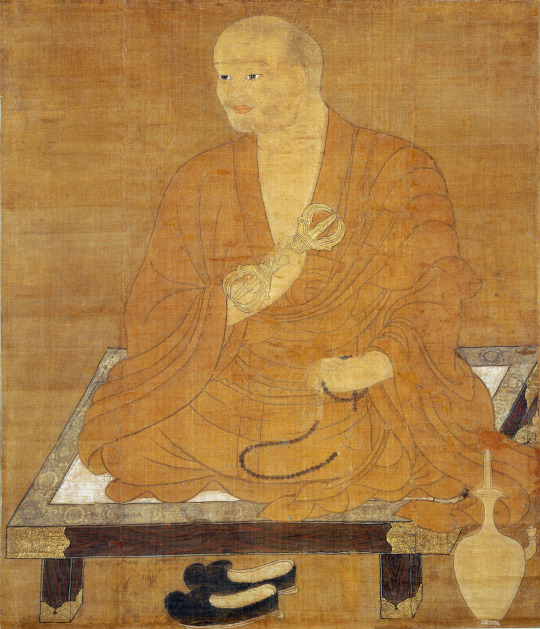
A Kamakura perioid painting of Kūkai holding a vajra (wikimedia commons)
As a digression it’s worth pointing out that while the Tenchi Reikiki was only written in the Kamakura period, it was actually attributed at the time to Kūkai, who lived centuries earlier. Obviously one reason was that there’s no better way to make a treatise seem more authoritative than to claim it was written by a celebrated historical figure. However, it’s also worth pointing out that at some point a connection between Kūkai and Amaterasu developed. A tradition known from a number of works, for example Monkan’s treatise Himitsu Gentei Kuketsu (秘密源底口決) presents him as a manifestation of her.
The Watarai theories about the nature of Toyouke and Amaterasu have originally been written down in the Kamakura period in the so-called “secret books''. This term has been used to refer to them collectively since the Edo period, when they were standardized for a relatively brief time into a “canon” of sorts. While tradition has it that there were five of them, research revealed the existence of further texts in medieval tradition, with one rediscovered in 1955, for example.
At least in theory, the individual Watarai books present information contained within as a special sort of secret, designated by the Buddhist term shōgyō (聖教; literally “sacred teachings”). Originally it referred to the teachings of the historical Buddha, or to the Buddhist canon more broadly, but in medieval Japan the term came to refer to specific kinds of knowledge transmitted by monks and other religious specialists in general.
While sometimes referred to as “secrets” in English, shōgyō were not necessarily impossible to share. Through the entire middle ages, many temples and shrines all across Japan effectively actively built their identity around making it known that they possess religious secrets worth knowing and can transfer them. Sometimes, they were intentionally “leaked” to nobles, imperial courtiers or fellow clergymen to spark interest. They were also utilized in annual “debate rituals” (論義会, rongie) held by authorities for religious scholars, who treated them as a way to hone their rhetorical skills and gain new theological insights.
The divine and the vulpine at Ise: Amaterasu, Dakiniten and Sankoshin

The Dakiniten mandala (wikimedia commons)
The topic of shōgyō is fundamentally linked with ambivalent Buddhist figures which in medieval Japan came to be associated with the notions of non-duality combining enlightenment and ignorance, such as dakinis, which commonly figured in such “secrets”. While dakinis do not appear in the cosmological myths from the Watarai books, they nonetheless did play a role in the developments pertaining to medieval Amaterasu. A link between her and the dakini par excellence, Dakiniten, developed due to their shared connection with Dainichi. Under his original name Mahavairocana, Dainichi can be portrayed as a subduer of dakinis, taking the guise of Mahakala (Makaraten) in this context. The singular Dakiniten as a result of this association could be identified with Dainichi outright, as attested in the Rinnō Kanjō Kuden (輪王灌頂口傳), dated to the late Kamakura period.
The link between Amaterasu and Dakiniten is chiefly known from the Shingon ritual sokui kanjō (即位灌頂), “enthronement initiation”, meant for emperors freshly ascended to the throne. It was first performed for emperor Fushimi in 1287, and remained a part of ascension ceremonies all the way up to 1846. In this context, Amaterasu outright appears in the guise of Dakiniten. A similar statement can be found in Tenshō Daijin Kuketsu, which calls Dakiniten the honji of Amaterasu (it also links Dakiniten with Fujiwara no Kamatari and the rise of the Fujiwara clan, but I’ll cover that elsewhere in the future).
Keiran Shūyōshū specifies that the shinko was an appropriate form for Amaterasu because it is the only animal capable of emitting light on its own. This ability in turn reflects the fact that its body was identical with the wish-fulfilling jewel, a frequent attribute of Buddhist figures; the name is self-explanatory. Alternatively, the animal could be described as possessing three tails, each ending in a wish-fulfilling jewel. By the fourteenth century, this object was firmly associated with Amaterasu as well. This led to the development of the view that Nyoirin Kannon (如意輪観音), a form of Kannon directly linked to the wish-fulfilling jewel, was Amaterasu’s honji. The shinko similarly could be identified with this bodhisattva. Granted, so were prince Shotoku, Ryōgen and numerous other figures, but that’s a separate topic not directly relevant to this article.
A different belief developed around the shinko at Ise. Here this supernatural animal came to be identified with Sankoshin (三狐神), literally “three fox deity” or “three fox deities”. Despite the triplicity implied by the name, sources such as Tamakisan Gongen Engi (玉置山権現縁起) clearly describe Sankoshin as a singular figure who acted as the “king of the heavenly foxes” (天狐王, tenko-ō).
It is presumed that Sankoshin's name was in origin a derivative of Miketsu no Kami (御食津神), the kami of Miketsu, the granary of the Outer Shrine. The development of Sankoshin might have started as a misreading or wordplay, with Miketsu (御馔津) transformed into the homophone mi ketsu, “three foxes” (三狐). This phrase in turn can be alternatively read as sanko, as in the case of Sankoshin.
Miketsu no Kami is otherwise associated, or outright identified, with Uka no Mitama, who is obviously not a fox, let alone three foxes; or alternatively with Toyouke, who has even less to do with these animals; you might recall she is described as a miketsu kami in the legend of her arrival in Ise. Older copies of Nakatomi Harae Kunge also affirm this equation, but later on the reference was substituted for a statement supporting the equivalence between Toyouke and Ame no Minakanushi favored by the Watarai priests.
Sankoshin in the middle ages appeared in rituals from Ise associated with the kora (originally 子良, later also 狐良). This term refers to a class of female shrine attendants associated with the Outer Shrine at Ise. Jingi Hishō asserts they were manifestations of Dakiniten, and on the basis of homophony links their name with 狐 (ko), “fox”.
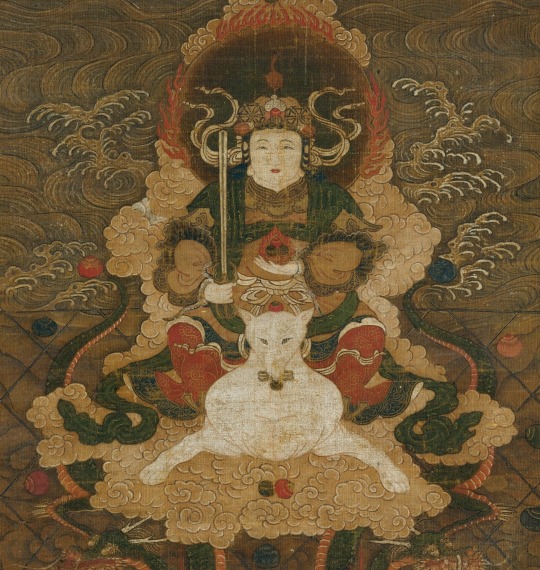
Part of a hanging scroll depicting Dakiniten riding on a fox (wikimedia commons)
Elsewhere, shinko is treated as another name of Dakiniten, or alternatively of her fox mount (which lacks serpentine traits proposed by Teeuwen, but sometimes does have snakes coiling around its legs and neck). It’s also a part of her well attested epithet Shinko-ō Bosatsu (辰狐王菩薩), “Bodhisattva King of Astral Foxes”. This connection is also partially responsible for the development of another of her titles, Shindamani-ō (真陀摩尼王), “king of the wish-fulfilling jewel”.
Being able to grant specific wishes immediately was commonly attributed to Dakiniten in the middle ages and beyond. However, due to her ambivalent perception and peripheral role between devas and demons in Buddhist theology it was commonly believed that the worldly benefits granted by her do not last and in the long run might lead to misfortune. With time, related rituals often came to be perceived negatively, often based on highly dubious reasons, as I discussed recently in another article. The ambivalent perception of Dakiniten ultimately was not unlike that of the animals she came to be associated with.
I plan to cover Dakiniten in more depth at some point, but I will only note here that her connection with foxes has a rather interesting history. Originally, dakinis were associated with jackals in India, due to their similarly unfavorable perception. When Buddhist texts dealing with this topic were transmitted to China, references to these animals posed a challenge to the translators, who were entirely unfamiliar with them. Based on context it was established that the name of a fox-like legendary animal, the yegan (野干), would make for a sensible translation. Since the yegan was described as fox-like, and since foxes in general had a major role in religion and literature of China at the time, eventually comparisons with foxes started to show up. Most notably, in the Tang period Śūraṅgama Sūtra the word dakini is provided with the gloss humei gui (狐魅鬼), something like “fox sorceress demon”. While unique, this term might have influenced the development of the image of dakinis in general, and Dakiniten in particular, in Japan.

A thirteenth century depiction of Benzaiten with entourage (wikimedia commons)
To go back to the core topic of this section, the development of a link between Amaterasu and Dakiniten had one more consequence: the establishment of a similar connection between Toyouke and closely related Benzaiten at Ise, to keep the theme of mirroring associations. This goddess is the Buddhist form of Saraswati. Today, she is best known as one of the Seven Gods of Luck, who emerged as a group in the Edo period, though her history goes further back and she enjoyed considerable popularity through the middle ages.
Outside of Ise, it was commonly Amaterasu herself rather than Toyouke who came to be linked to Benzaiten. According to a legend which originated on Chikubu Island, Benzaiten first appeared in Japan during the reign of emperor Kinmei, and instantly announced she is a manifestation of Amaterasu. A less direct reference might be present in the already mentioned Taiheiki, where Yoshisada Nitta at one point says he heard Amaterasu at times manifests in the form of a “dragon god of the blue ocean”, which might be an allusion to a common symbol of Benzaiten.
Benzaiten and Amaterasu could also be associated without being identified with each other. In a myth tied to the tradition of wandering blind singers (a group traditionally believed to be under her protections), she effectively replaces Ame no Uzume, and lures Amaterasu out of the cave by playing her biwa. In the Asamayama Engi (朝熊山縁起), she is addressed as Amaterasu’s mother instead, though she ultimately only plays a minor role in contrast with her daughter. The text largely revolves around Amaterasu (as noted by Anna Andreeva portrayed here as a “great conversationalist”) explaining theological matters to the monk Kūkai.
Amaterasu, Aizen and sericulture

The wisdom king Aizen (Metropolitan Museum of Art)
In addition to her links to Buddhas and devas, Amaterasu also offers an example of identification between kami and wisdom kings. They enjoy an elevated position among Buddhist figures, almost on par with Buddhas and bodhisattvas. She could specifically be identified with arguably the second most important member of this category, Aizen Myōō. Since he is regarded as a wrathful manifestation of Dainichi, the reasons appear fairly straightforward. Linking him with Amaterasu goes back at least to Eison, a long-lived thirteenth century Shingon monk. The connection additionally reflects Amaterasu’s association with the wish-fulfilling jewel. Aizen was outright identified with this object, which is actually responsible for many of his own associations. Last but not least, Aizen and his fellow wisdom king Fudō were identified with the same two mandalas as the two shrines of Ise. On this basis it was not hard to link Aizen with Amaterasu.
However, once again, association does not necessarily equal conflation. Therefore, Aizen and Amaterasu could also appear as two distinct figures in the same sources. For example, both textual and iconographic instances of a triad consisting of both of them and another wisdom king, Fudō, are known. The occasional identification between Aizen and Amaterasu is not the reason behind his appearance here. Instead he and Fudō are present because they are an archetypal Buddhist dyad used to represent duality.
The triad is a medieval reinterpretation of the cave myth which played a role in an initiation rite (灌頂, kanjō) focused on Amaterasu. In this context both of the wisdom kings take the roles of “rock cave assistants”, with Fudō corresponding to Takuhatachijihime (the mother of Ninigi and younger sister of Omoikane) and Aizen to Tajikarao (who famously opens the cave in the classical version of the myth). The opening of the cave Amaterasu hid herself in was compared to the opening of the legendary Iron Stupa, said to exist somewhere in the south of India. This event, as Buddhist treatises record, led to the reveal of esoteric knowledge to the early Mahayana thinker Nagarjuna. In Tenshō Daijin Kuketsu, it is actually Amaterasu herself who was transmitted to him by the bodhisattva Kongōsatta (Vajrasattva).
To go back to the depictions of the Amaterasu triad, another thing worth pointing out is that a unique iconographic variant of her appears in them: seated on the back of a horse, with a solar disc and scales in her hands. While at a first glance this might sound similar to already discussed Taga Myōjin, there is actually a difference: the latter is always depicted frontally, not facing left, in contrast with the other mounted form of Amaterasu.

A depiction of Memyō from the fifteenth or sixteenth century (Metropolitan Museum of Art)
However, Bernard Faure notes these paintings resemble yet another figure she could be equated with, Memyō Bosatsu (馬鳴菩薩; “horse neigh bodhisattva”). This name originally referred to the Buddhist author Aśvaghoṣa, but in this context it instead designates a sericultural deity of Chinese origin first attested in the Tang period, for example in a short text attributed to Varjabodhi. However, while the Chinese original, Maming Pusa, is male, his Japanese counterpart is generally portrayed as a female figure, especially in texts stressing her connection to Amaterasu.

A Meiji period illustration of Susanoo throwing the carcass of Ame no Fuchikoma into Amaterasu's weaving hall (wikimedia commons)
Presumably the two initially came to be associated with each other because of their shared interest in sericulture and weaving. The classical myth portraying Amaterasu as a weaver, in which Susanoo throws the carcass of the horse Ame no Fuchikoma into the room where she is engaging in this craft, has been channeled to highlight why she would be identified with a deity portrayed on horseback.
While Memyō is arguably the highest profile Chinese figure Amaterasu was identified with (unless you want to make a case for Enma but that would be a bit of a reach), it’s worth noting that there’s another such case. However, it involved a historical figure rather than a deity. While presenting Buddhist patriarchs or rulers as manifestations of Buddhas or deities was par for the course, this one strikes me as quite unique.

Yang Guifei, as depicted by Shōen Uemura (wikimedia commons)
Jindai no Maki Hiketsu (神代卷祕決) records a tradition according to which Yang Guifei, a consort of emperor Xuanzong of Tang, was a manifestation Amaterasu. It depends partially on the preexisting belief that the former did not commit suicide, but instead escaped to Japan, and came to be enshrined in the Atsuta Shrine, which on the account of its picturesque location was sometimes identified with Penglai, the land of Daoist immortals. A related legend is recorded in the sixteenth century treatise Utaishō (謡抄), which relays that the Atsuta deity (here not identified with Amaterasu) manifested in China as Yang Guifei to seduce emperor Xuanzong to distract him with a plan of invading Japan. After accomplishing this goal, she returned to her shrine.
Emperor Xuanzong wasn't exactly the conventional nemesis of Amaterasu, whether in classical mythology or in the middle ages. I'll look into the figures such a title can be applied to in in the second half of this article; due to tumblr's limits I cannot publish both halves as a single post. The bibliography will also be included in part 2.
82 notes
·
View notes
Text
The fabrication of a storm god: Susanoo, Taishakuten (Indra) and their histories

When I found this ask in my inbox recently, I initially admittedly wanted to only give a short, dismissive response. After all, the similarity between these two is completely superficial. And, truth to be told, it’s more a vague similarity between how they are presented as “storm gods” by questionable online sources than between their actual roles. However, I quickly realized that would not accomplish much. The best way to counter misconceptions is to show reality is more interesting - and in the case of complex figures with long histories, this requires time and effort.
The response, like the recent Tamamo no Mae one, kept growing as a result, and evolved into a fully blown unplanned post. Under the cut, you will find a brief examination of the origin of the erroneous notion that Susanoo was ever understood a “storm god”, as well as a summary of his character character, the main deities linked to him in the Japanese “middle ages”, and finally his fate after the Meiji restoration. In the second half, I deal with the Japanese reception of Indra. While not actually related to Susanoo, he is nonetheless a complex deity worth exploring, even though it feels like he’s not particularly appreciated by hobbyists and his central role in medieval cosmology hardly gets acknowledged.
Victorian confabulations and Meiji mirages: the fabrication of a storm god
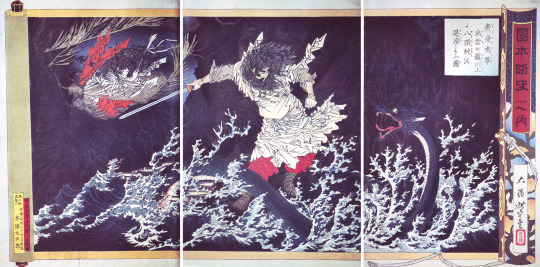
Susanoo vanquishing Yamata no Orochi, as depicted by Yoshitoshi Tsukioka (wikimedia commons)
Contrary to what you might have seen in numerous online sources of dubious quality, Susanoo is not a “storm god” (let alone a “thunder god” more specifically). Nothing to that effect shows up in standard points of reference like Encyclopedia of Shinto, and even Wikipedia despite arbitrarily putting him in the weather god category only musters a single 2000 paper which I’ve never seen cited in subsequent Susanoo research as “evidence” of a weather connection.
The most recent in depth treatments of Susanoo in English are a section of Bernard Faure’s monograph Rage and Ravage and David Weiss’ The God Susanoo and Korea in Japan’s Cultural Memory: Ancient Myths and Modern Empire. The former at no point makes any claims pertaining to the weather while discussing him. The latter notes the view that Susanoo was a “storm god” enjoyed some popularity in the late nineteenth century because of the influence of the now long abandoned school of “nature mythology”, in which deities are only ever representations of natural phenomena. This theory was originally formulated by Edward Burnett Tylor, who basically admitted no actual Japanese sources ever present him as a “storm god”, but that this character is nonetheless evident in his vibes (obviously not how he phrased it, but his study deserves no more dignified summary).
Tylor’s nonsense was subsequently taken up by a certain Edmund Buckle, who randomly connected his forerunner’s oc with Indra because I guess all weather gods are basically interchangeable (there’s an interesting point to be made about how they’re the one group of male deities who are often treated in poor quality scholarship the way goddesses usually are). By 1899, the theory reached Japan, where it caused a prolonged academic debacle. However, it seems supporters of this view, much like in the west, were the followers of the long since abandoned notion of “nature mythology”. Among the theory’s opponents were researchers such as Masaharu Anesaki. As far as I can tell, it’s essentially irrelevant today.
The oldest available information about Susanoo’s actual character comes from the Kojiki and the Nihon Shoki. I don’t think that needs to be discussed here in detail. Even though I often overestimate other people’s familiarity with mythology I think it’s fair to say everyone with just a passing interest in Japan knows at least the basics of the myths about his conflict with his sister Amaterasu, his banishment, and subsequent victory over the serpent Yamata no Orochi. It will suffice to say the oldest recorded mythical image of him is that of an ambivalent deity, a heroic monster slayer on one hand, a transgressor and exile on the other. This polarity remains a core part of him for the rest of his history.
The other early sources dealing with Susanoo are various fudoki, regional records. They indicate that in the eighth century he already was connected with diseases. Later on in the Heian period, he also came to be associated with purification. Or to be more precise - he came to be viewed as the archetypal target of purification, in a way. His misdeeds from classical mythology became examples of deeds requiring such ceremonies, performed variously by courtly ritual specialists like the Nakatomi clan, Buddhist clergy, or onmyōdō masters. He also functioned as a jinushi, a “landholder deity” of often ambivalent character tied to a specific location, and an araburugami, a “raging god” defined by causing havoc out of hubris (as opposed to malice).
Gozu Tennō and others: the network of medieval Susanoo
Susanoo’s character developed through the Japanese “middle ages” in no small part through associations with other deities, typically caused by his incorporation into Buddhism.

A composite Susanoo-Gozu Tennō, as depicted by Sadahide Utagawa (Östasiatiska Museet, Stockholm)
The single most important figure he came to be linked with was by far Gozu Tennō, the “Bull-Headed Heavenly King”. While religious and literary texts present him as a deity from India, the guardian of the Jetavana monastery, and he was even furnished with an artificial Sanskrit name, Gomagriva Devaraja, his origin is actually uncertain. It’s possible he was inspired by a misreading of a passage from the travelog of the Chinese monk Faxian (c. 337-442). He visited Jetavana in the early fifth century, and reported that there was a statue of a bull next to the monastery’s door, before moving on to describing the supposed first image of the Buddha, which according to him was made from legendary “ox-head sandalwood” and impervious to fire. Confusion between these two passages might have led to the creation of an ox-headed deity. Other proposals are present in scholarship too, but ultimately the matter remains unclear.
What is evident is that Susanoo and Gozu Tennō shared many similarities: the latter also was an archetypal “raging deity”, and he too was linked with pestilence. An argument can be made that he was the disease spirit par excellence in medieval Japan, in fact. When properly worshiped, he was supposed to protect the faithful from illnesses, as expected from a deity of this variety. They also shared an association with foreign lands: Gozu Tennō primarily with India, but also with China and Korea, while Susanoo just with Korea, due to a Nihon Shoki episode where he travels to the kingdom of Silla. Yet another point of connection is that both were simultaneously recognized as manifestations of Yakushi (the “medicine Buddha”). Therefore, it comes as no surprise that at the Gion shrine in Kyoto, and in many other locations across Japan, the two were identified fully.
However, the link was at times conceptualized differently than as interchangeability between the two. For instance, Kaneyoshi Ichijō’s treatise Kuji Kongen (公事根源; “Roots of Court Administration and Ceremonies”) Gozu Tennō is merely an “acolyte” (warawabe, 童部) of Susanoo. Granted, this author eventually came to view them as identical himself, which shows how fluid medieval theology could be.
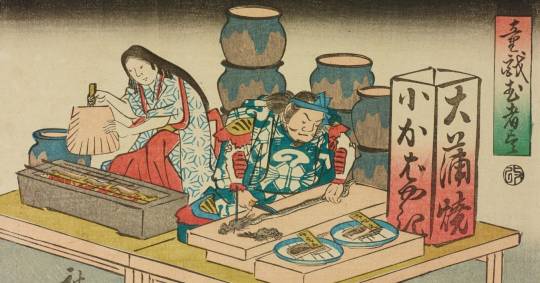
A humorous depiction of Susanoo and Kushinadahime serving pieces of Yamata no Orochi prepared like grilled eel (Ōta Memorial Museum of Art; reproduced here for educational purposes only)
The identification between Susanoo and Gozu Tennō also extended to their wives, respectively Kushinadahime and Harisaijo (波梨采女), as evident for example in the Shaku Nihongi. The latter was regarded as a daughter of the dragon king Sāgara. Things are made slightly awkward by the Nihon Shoki Sanso, where she is a manifestation of Yamata no Orochi (one of the multiple cases of putting a positive spin on the snake). Susanoo in the guise of Gozu Tennō thus effectively marries his nemesis.
The marriage itself is a subject of a number of myths. According to Hoki Naiden (簠簋内伝), an onmyōdō manual, the “heavenly emperor” (Taishakuten, one would presume, based on information I’ll discuss later) de facto played the role of a matchmaker between Harisaijo and Gozu Tennō. When the latter was lamenting that due to his monstrous, yaksha-like form - he had the head of a bull - he will never find love, a bird sent by the celestial ruler informed him that it would be appropriate for him and Sāgara’s daughter to get married. This suggestion then evidently works out just fine, and the couple subsequently have eight children, the Hachiōji (八王子, “eight princes”) over the course of thirty seven years.
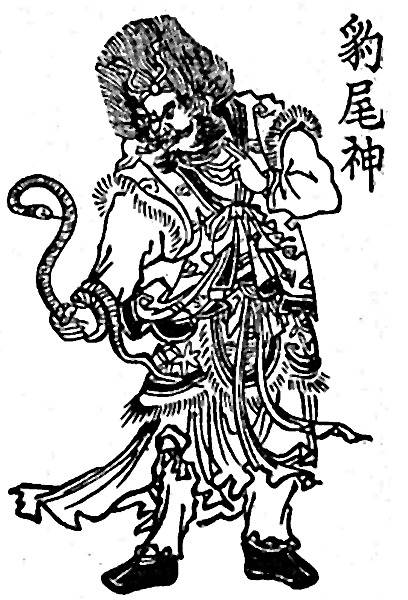
Hyōbi (wikimedia commons)
There are multiple slightly divergent traditions about the identities of the children. The most notable variable is that a goddess named Jadokkeshin (蛇毒気神; also read Dadokuke no kami; “deity of poisonous snake breath”) sometimes appears among them, sometimes is treated as an independent deity serving Gozu Tennō, and sometimes takes the role of his spouse (in at least one case with Harisaijo quite literally relegated to the role of his ex). She is also identified with the astral deity Hyōbi (豹尾, “leopard tail”) and by extension with Ketu.
Another figure who was closely linked with Susanoo in the middle ages was Matarajin. This tradition was associated with Gakuen-ji. In a local legend, Susanoo started to be called Matarajin after being buried underneath it. I won’t dwell much on Matarajin here since I already wrote a lot about him, and will write even more in the near future, so it will suffice to say the two share a connection to diseases. In Matarajin’s case it is the most pronounced in the “ox festival” still held in modern times at Kōryū-ji.

Shinra Myōjin (wikimedia commons)
Connections between Susanoo and Matarajin’s fellow Tendai old man disease-related deities Sekizan Myōjin and Shinra Myōjin are documented too. Bernard Faure argues that in fact it was Shinra Myōjin who first developed such an association, and it was only transferred to Matarajin as well because of the numerous analogies between them.
A distinct tradition regarding Susanoo developed in the theology of Ise (“Ryōbu shintō”), which as expected was Amaterasu-centric (but also Dainichi-centric!). He came to be linked with Mara and Devadatta as a representation of “fundamental ignorance”, with the conflict between him and Amaterasy gaining an additional Buddhist dimension. At the same time, in the noh play Dairokuten (第六天), which deals with Jōkei’s pilgrimage to Ise, Susanoo appears to protect this monk from Mara. Evidently, in this context Susanoo and Amaterasu are hardly opposed to each other, seeing as the former de facto intervenes on behalf of the latter.
While the notion of rivalry between the siblings obviously did not vanish in the middle ages, and in fact new myths about it started to circulate (in one Matarajin assists Susanoo), it can be argued that it was ultimately the new conflict between Amaterasu and Mara that was central to many medieval theologies. While she and Susanoo could be portrayed as antagonistic, there is a case to be made that there were more similarities between medieval ideas about them than there were differences. That was not meant to last, though.
Later developments
The tradition of associating Susanoo with assorted medieval deities first came under criticism in the eighteenth century. Sadakage Amano, an early proponent of kokugaku ("national learning", an early Japanese nationalist ideology) ideas, wrote a treatise dealing with this matter, Gozu Tennō Ben (牛頭天王辨, “Clarification on Gozu Tennō”). Its core premise is that monks and shrine priests alike are deceptively trying to present “foreign” deities as identical with “native” ones. This point was further developed in the nineteenth century by another kokugaku big name, Atsutane Hirata.

Hirata's self portrait (wikimedia commons)
He reaffirmed that presenting Susanoo and Gozu Tennō as related deities was a nefarious plot, and blamed Kibi no Makibi for starting it. He argued that Makibi spent too much time in China and as a result forsake a pristinely Japanese way of thinking (whatever that wouldn't entail). As a result, when he heard the legend of ox-head sandalwood, which was believed to grow on the mythical continent Uttarakuru and cure diseases, he turned it into a deity, who he subsequently brought to Japan. Then he identified him with Susanoo to increase his prestige.
Was that the historical truth? Kibi no Makibi was an envoy to China and spent around 20 years on the mainland, that much is undeniable. However, the only connection between him and Gozu Tennō I was able to track down is a local legend pertaining to Mount Hiromine in which he meets this deity in a dream, though.
Ultimately like most of Hirata’s writing, his theory consists virtually entirely of confabulations, mostly motivated by extreme levels of xenophobia. Rather ironic for a movement which originally largely developed among the most hardcore neo-Confucian thinkers in Japan. Granted, that’s hardly the only baffling thing about them. The best way to understand what was going on in the heads of kokugaku proponents is to recall how contemporary marble bust profile pic “the west has fallen” trads or Bible literalist creationists function, and adjust that image for the specifics of the Edo period.
Still, kokugaku theories, nonsensical as they were, kept developing, and finally gained government support after the Meiji revolution. In 1868, the Council of State proclaimed that shrines can no longer use “inappropriate” names to refer to their deities. Gozu Tennō was the only example brought up directly, in part possibly because with the reestablishment of the power of the emperor and the rise of the imperial cult it was viewed as suspicious that a deity unrelated to the imperial court had the moniker of tennō (written with different signs, though). The edict also contains a blanket ban on any name with the element gongen.
As a result of the new policies numerous locations had to be renamed, and for the most part the history of Gozu Tennō came to an end. He and his peers eventually came back into the spotlight in the second half of the twentieth century as subjects of scholarly inquiries, and the field of study of medieval and early modern Japanese religions is now booming, with entire monographs and articles published in multiple languages each year, but that’s another story.
The history of Susanoo obviously did not end in the 1860s, though. What followed was probably the single darkest page in it, an era of intense efforts to make him identical with Dangun, the legendary founder of Korea. The goal was explicitly to justify Japanese colonial control over Korea through faux-spiritual means. Since Japanese colonial domination of Korea is a relatively recent and deeply serious historical issue compared to what I cover most of the time, I feel it would be inappropriate to deal with it in the same article as medieval literature which ultimately lacks much of a tangible impact on the modern world, so I hope you won’t mind I don’t go deeper into the detail here.
With the matter of Susanoo now settled, let’s move on to Indra. The two were never associated with each other, but the latter developed an equally vibrant network of roles and associated deities around him as Susanoo after being transmitted to Japan.
From Indra to Taishakuten

A typical Hindu depiction of thousand-eyed Indra (wikimedia commons)
Indra has a long and complex history, so long he is in fact attested a handful of times in bronze age cuneiform already as one of the notoriously mysterious non-Hurrian Mitanni deities (sic), invoked as personal deities of the royal house in a lengthy treaty oath. This makes him one of the very few “bridges” between my two major normally disconnected interests (the “cuneiform world” on one hand, and East Asian religions and art on the other).
The biggest early text corpus dealing with Indra are the Vedas, where he is the single most frequently mentioned deity, with quite literally hundreds of hymns praising him. Naturally, he remained a part of the history of Hinduism later on, and today he is still well known thanks to his role in popular epics like Ramayana. His relevance is not limited to this system of beliefs alone, though. He has a small (negative) role in the Avesta (see here), and he was embraced by various schools of Buddhism across much of Asia.
In early Buddhism, the prestige of Indra was not particularly great. This obviously reflects the fact that the formative years of Buddhism were also a period of Indra’s relative decline as an actively worshiped god back at home at the expense of deities central in contemporary Hinduism like Vishnu and Shiva. However, he surprisingly regained some of his original prestige thanks to developments which occurred outside of India. This is well documented in East Asia in particular. I’ll only cover his Japanese reception here - therefore, through most of the rest of the article I will use his Japanese name, Taishakuten (帝釈天), accordingly.
Buddhism emphasizes not Indra’s warlike side and his battles with asuras, let alone a connection with the weather, but rather his role as a heavenly ruler. He keeps epithets related to his 1000 eyes, but to the best of my knowledge this is not really reflected in Buddhist art, especially not in Japan. Another role retained by him in Buddhism is that of a directional deity, the protector of the east.
Something that’s worth highlighting is that asuras in general just aren’t that big of a deal in Japanese Buddhism. Outside of enumerations of non-human sentient beings, only Rahu and Ketu have a substantial role, and that’s more because they’re astral deities rather than because they’re asuras. Otherwise the entire category is about as opaque as mahoragas (when you look up “mahoraga” online 99% results are a Jujutsu Kaisen character, as it turns out, which speaks volumes about their general obscurity) and the like. Hard to make opposition to them the focus of a major deity when even gandharvas have a bigger role to play.
I can only think of a handful of major references to battles between Taishakuten and asuras in Japanese literature: an offhand comment in Heike Monogatari (courtesy of Kenreimon-in), a passage from the Taiheiki where Jōkei (who you already met earlier in this article) has the privilege to watch the parties involved reenact the conflict for his benefit, and a myth cited by Annen with no source provided, possibly invented by him. The innovation is that Marici (Marishiten) is a major combatant on the side of the devas, something with no parallel in any other source, whether Buddhist or Hindu. Rahu is singled out among the asuras as an enemy of Taishakuten, but that’s hardly unparalleled.
The conventional image of Taishakuten
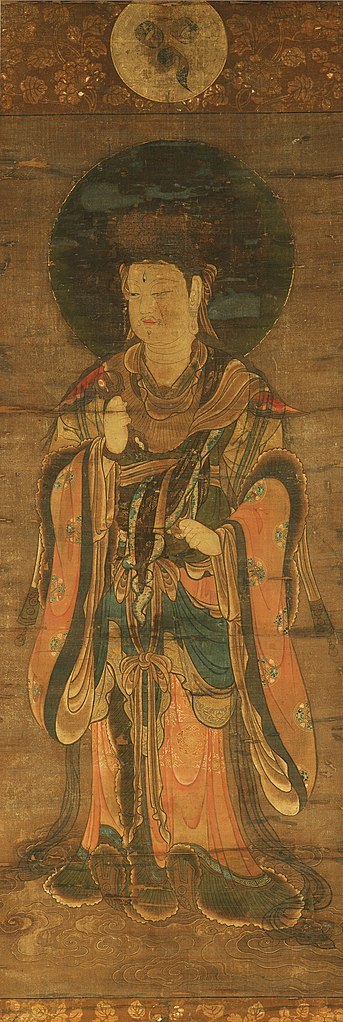
A conventional depiction of Taishakuten (wikimedia commons)
For the average Japanese person through much of the country’s history, the most frequent exposure to Taishakuten were standardized oath formulas (kishōmon). These followed a strict hierarchy of deities: Taishakuten, Bonten (Brahma) and the four heavenly kings first, then king Enma, Godo Daishin (Wudao Dashen), Taizan Fukun and other underworld officials (sometimes assisted by astral figures), then kami and representations of Buddhas tied to specific localities (for example the great Buddha of Tōdai-ji), and sometimes various religiously significant historical figures like prince Shotoku or Buddhist patriarchs. Obviously, Taishakuten’s elevated position reflects his role as a heavenly ruler - the “heavenly emperor”, tentei (天帝).
The residence of Taishakuten is the heaven of the thirty three devas (忉利天, Tōriten, a calque from Sanskrit Trāyastriṃśa). It is located on Mount Sumeru, the center of the world according to Buddhist cosmology. Sources from the Heian period indicate the existence of a belief Taishakuten’s heaven is unique in that women could be reborn in it after death without first reincarnating as men. This distinction was otherwise only attributed to the pure land of Maitreya. Note it was not Taishakuten himself who was responsible for guaranteeing that, though, but rather the bodhisattva Fugen, who was particularly popular among Heian court ladies.
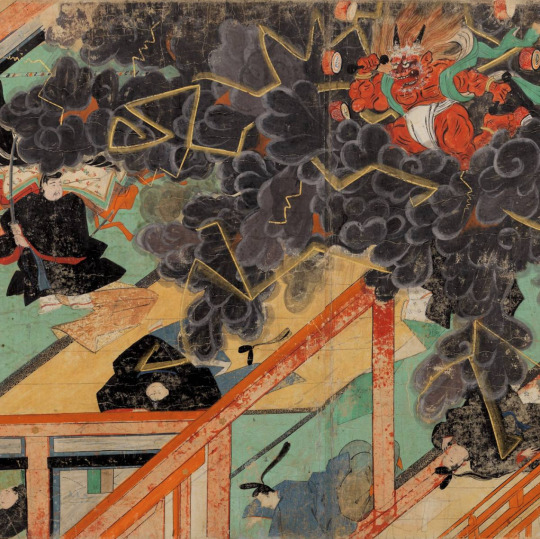
Karai Tenjin (wikimedia commons)
Taishakuiten’s major position in the Buddhist-influenced cosmos is also evident in literary compositions focused on other deities. For example, in the Dōken Shōnin Meidoki (道賢上人冥途記, “Record of Dōken Shōnin’s Experience of the Other World”), a version of the legend of Michizane, his revenge is supported by Taishakuten, who gives him a new name, Nihon Dajō Itoku Ten (日本太政威徳天). This is meant to show his banishment was a religious transgression, and we also learn that the emperor responsible for it, Daigo, fell into hell as a result. However, esoteric Buddhism is also credited with calming Michizane down - as he explains himself, “bodhisattvas (...) were there, and they enthusiastically propagated the esoteric teachings. Because I liked these teachings very much, one-tenth of my deeply seated enmity from my past was reduced.”
This obviously goes against the more common legend where being enshrined pacifies Michizabe entirely. In the Dōken version he announces that the enshrined deity, who he calls Karai Taiki Dokuō (火雷大気毒王; “King of Fire-Thunder and Poisonous Air”), is merely his messenger #3 (#1 and #2 are not mentioned).
The closest thing I can think of to Taishakuten being associated with the weather in Japanese sources occurs in a version of the Michizane legend, too: in another variant, Michizane states it was Taishakuten alone who permitted him to enact his vengeance and entrusted him with commanding 105000 thunder gods (in the Dōken Shōnin Meidoki there are 168000 attendants instead, “poisonous dragons, evil demons, deities of water and fire, thunder and lightning, the director of the wind, the master of the rain, and other poisonous, harmful, and evil deities”) and causing disasters.
From emperor to heaven to controller of fate
Due to his prominent cosmological role Taishakuten is also described in many sources as a controller of fate responsible for determining the lifespans of living beings. Sometimes, in this capacity he basically overlaps with king Enma - for example, Shishi Yaloan, a Buddhist encyclopedia from the eleventh century, states that he also possesses a mirror in which he can check on his subjects. A local tradition from Tateyama states that he lives on the Taishaku Peak of Mt. Tate, simultaneously regarded as an entrance to Buddhist hell. However, while Enma and the other kings of hell generally stay there, Taishakuten takes a more proactive role, seeking information about the good and bad deeds of the living. Initially, it was believed that a survey of the whole world was conducted on his behalf by the four heavenly kings, but by the tenth century, a belief that he performs it himself every four months himself developed.

The famously unconventional depiction of Taishakuten from Shibamata Taishakuten, still distributed today in the form of ofuda (wikimedia commons)
In the Edo period, Taishakuten as a controller of fate developed a connection with deities associated with the tradition of kōshin nights. In this context he became the deity the three worms living in every person’s body report their good and bad deeds to. Temples associated with him, like Shibamata Taishakuten (famous among other things for its unconventional images of the eponymous deity), were historically a popular destination for pilgrimages tied to kōshin celebrations.
While the fate connection ultimately came to the forefront in Japan, it would be unfair to say it entirely superseded the original heavenly role. As a matter of fact, it was the fact that Taishakuten was a “heavenly emperor” (tentei) that made him such a good fit for kōshin.
The elusive "emissary of Taishaku"
As early as in the Muromachi period, yet another deity came to be viewed as responsible for Taishakuten's survey of the world in a variant tradition: one of the so-called “ambulatory deities” (遊行神, yugyōjin; “ambulatory” as in “wandering”, not in the medical sense) , Ten’ichi(jin) (天一神; also read Nakagami), literally “the first deity of heaven”. He was regarded as a “vassal” of Taishakuten and the commander of the Twelve Heavenly Generals. Each of his cyclical surveys of the world lasted 44 days (four times five days for each of the main directions and then four times six for the intermediate ones). That was followed by sixteen days during which he reported the vices and virtues he recorded to Taishakuten in heaven, with his own underling Nichiyū(jin) (日遊神; “playing sun deity”) descending to earth instead.
During Tenichi’s absence, which started with a day referred to as Ten’ichi tenjō (天一天上), directional taboos pertaining to various astral deities, which normally had to be countered with a practice known as “changing directions” (方違え, katatagae), did not apply.
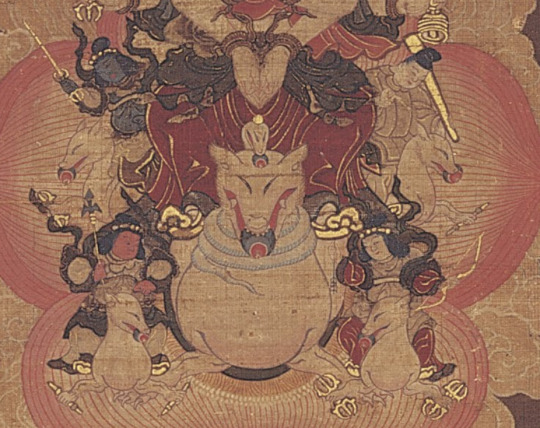
Taishaku Shisha (top right) and his peers accompanying Dakiniten (wikimedia commons)
Another interesting thing about Ten’ichi is that he was identified with an elusive deity known simply as Taishaku Shisha (帝釈使者), literally “emissary of Taishaku”. At first glance this doesn’t really sound interesting - after all, Taishaku Shisha’s name sounds exactly like what Ten’ichi does - but completely unexpectedly, the former actually belongs to the entourage of Dakiniten. His attributes make him resemble officials of the underworld, though he is never portrayed as menacing, always as benign, and his duty is to report the good and bad deeds to his superiors, much like Ten’ichi does. He additionally functions as a god of wisdom, which according to Bernard Faure might reflect Dakiniten’s link to the bodhisattva Monju, famous due to an association with this concept.
Curiously, while Taishaku Shisha is at least nominally a member of a group of four “acolytes” of Dakiniten alongside Tennyoshi (天女子; “heavenly maiden”; holds a bow), Shakunyoshi (赤女子; “red maiden”; holds a halberd and a “seduction jewel”, aikei-gyoku, 愛敬玉) and Kokunyoshi (黒女子; “black maiden”; holds a sword and a black jewel), he is sometimes described as de facto separate from them. Perhaps the fact his very name links him with another deity has something to do with that. Also, he is absent from the origin myth of the three maidens, who according to Hoki Naiden flew to Japan from India. According to Bernard Faure, it is possible his roles overlapped in part with Dakiniten’s own emissaries, the tengu Tonyūgyō (頓遊行; brings happiness) and Suyochisō (須臾馳走; brings longevity).
Dakiniten, “demon kings” and Amaterasu: the network of Taishakuten
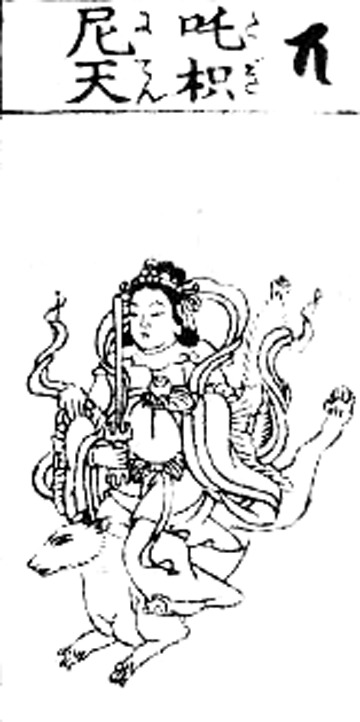
Dakiniten (wikimedia commons)
Taishakuten’s connection with Dakiniten goes beyond the figure of Taishaku Shisa. The Mizōukyo (未曽有經) contains a myth according to which a fox once tricked Indra into accepting the animal as his master is recorded. It serves as an explanation for the notably fox-like Dakiniten’s elevated role in the royal ascension rite devised by Shingon priests (it was still performed in the 19th century, emperor Meiji was the first to abstain from it). In folk beliefs Taishakuten was also sometimes assigned the role of the “master of the foxes”, which normally belonged to her instead.
The link to these animals according to Bernard Faure might have reflected a more ambivalent perception of Taishakuten than usually expected. The other possible piece of evidence in favor of this interpretation is a poem which proclaims that he and Tsuno Daishi, the demonic manifestation of Ryōgen, look “like brothers”. The latter is a complex figure, but it will suffice to say here that historically he was sometimes perceived as a “demon king” (魔王, maō). On the other hand, the original holder of this title, the “Demon King of the Sixth Heaven” (in other words, Mara) was said to offer his blood to Taishakuten on “blood-shunning days” (地幅, chi-imbi). In practical terms, this meant a religious prohibition on the drawing of blood, acupuncture and moxibustion on a specific day, different each month.
I need to stress here that even though figures such as Dakiniten and the “demon kings” obviously originated in the realm of demonology - respectively as a flesh-eating, vital essence-stealing demon and as the tempter of the Buddha - they eventually developed much more complex and nuanced characters. Therefore, it is not unexpected major deities appear in association with them. In the middle ages, even Amaterasu was frequently linked with them.
Funnily enough, in contrast with Susanoo Amaterasu does have a connection to Taishakuten as well. Tenshō Daijin Kuketsu (天照大神口決; “Oral Transmission.Pertaining to the Great Goddess Amaterasu”) from 1328 states that she corresponds to him - but also to Bonten, Shōten (Ganesha), the kushōjin (倶生神; these would take a bit to explain), king Enma and Godō Daijin. Granted, another roughly contemporary treatise, Reikiki, instead proclaims Taishakuten, the “heavenly emperor” (tentei; just like in the later kōshin tradition) the “kami-body” of Toyouke, the outer shrine Ise deity. However, these matters ultimately go beyond the scope of this response. Stay tuned for my article about medieval Amaterasu to find out more!
Bibliography
Ryūichi Abe, Women and the “Heike Nōkyō”: the Dragon Princess, the Jewel and the Buddha
Bernard Faure, The Fluid Pantheon (Gods of Medieval Japan vol. 1)
Idem, Protectors and Predators (Gods of Medieval Japan vol. 2)
Idem, Rage and Ravage (Gods of Medieval Japan vol. 3)
Gerald Gromer, A Year in Seventeenth-Century Kyoto. Edo-Period Writings on Annual Ceremonies, Festivals, and Customs
Takuya Hino, The Daoist Facet of Kinpusen and Sugawara no Michizane Worship in the Dōken Shōnin Meidoki: A Translation of the Dōken Shōnin Meidoki
Nobumi Iyanaga, Medieval Shintō as a Form of 'Japanese Hinduism': An Attempt at Understanding Early Medieval Shintō
William Lindsey, Religion and the Good Life: Motivation, Myth, and Metaphor in a Tokugawa Female Lifestyle Guide
Fabio Rambelli, Before the First Buddha: Medieval Japanese Cosmogony and the Quest for the Primeval Kami
Hiroo Satō, Wrathful Deities and Saving Deities in: Fabio Rambelli and Mark Teeuwen (eds.), Buddhas and Kami in Japan. Honji Suijaku as a Combinatory Paradigm
Idem, The Emergence of Shinkoku (Land of the Gods) Ideology in Japan in: Henk Blezer and Mark Teeuwen (eds.), Challenging Paradigms. Buddhism and Nativism: Framing Identity Discourse in Buddhist Environments
David Weiss, The God Susanoo and Korea in Japan’s Cultural Memory: Ancient Myths and Modern Empire.
81 notes
·
View notes
Note
thank you for the reply and the information! I was curious how the other fox would fit in with PCB Extra's metatextual mention of Three Lands, but I hadn't even considered it might be three worlds and not three countries. this is neat
(Original post for context)
I forgot I left the response to this in my drafts, sorry. Luckily, this means I could update it with recently acquired knowledge when I found it again.
Truth to be told, my point is less that the other fox is a better match, and more that Ran being Tamamo no Mae is one of these things which make sense at first glance, but the deeper you look into it, the less coherent it becomes.
This got much longer than I planned, so for organizational purposes let's refer to this post as Revenge of the "graveyard god", or why I don't think Ran is Tamamo no Mae. More under the cut.
The early Tamamo no Mae
The main point of connection between Tamamo no Mae and Ran are the nine tails, but that’s not even really a consistent part of the former's background. The oldest version of the story - which is really fun, the seduction section is pages upon pages of Tamamo and emperor Toba discussing esoteric Buddhism - states that she was “an 800-year-old two-tailed fox from the Nasuno Plain in Shimotsuke Province”. Early depictions of her true form follow this pretty closely:

Nezu Museum of Art, via Monsters, Animals, and Other Worlds. A Collection of Short Medieval Japanese Tales
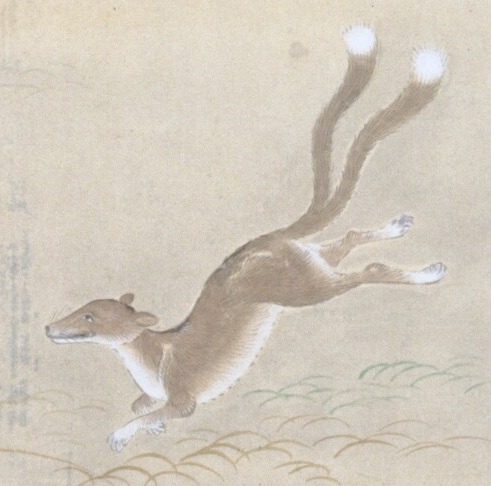
Kyoto University Rare Materials Digital Library

Suntory Museum of Art
As far as I am aware, the two tails are actually unique to her. Other foxes of note have either one tail or nine. While it does seem the belief in the number of tails growing with age is genuine rather than a modern misconception, it’s hardly central to fox folklore (I’ve seen the portmoneu “foxlore” at least once btw, it’s very funny). And, as I will outline later, it doesn’t even seem to be behind the idea of nine-tailed foxes in the first place.
Anyway, the oldest version does provide Tamamo with more backstory, but it’s closer to presenting Shuten Dōji as a manifestation of Mara than to a straightforward “Tamamo is x under a pseudonym” popular today. As we learn, the two-tailed fox is in fact a reincarnation of a “graveyard god” (塚の神, Tsuka no Kami) from India, described in the apocryphal Humane Kings Sutra (it gets namedropped directly), likely originally composed in China.
How come? It all started when Kalmashapada, a prince of Devala in India, wanted to offer 1000 skulls of virtuous rulers to this deity because a suspicious “heretical” preacher convinced him it’s a good idea. After defeating and imprisoning 999 such kings, he encountered Shrutasoma, one of the previous incarnations of the historical Buddha, who managed to show him the error of his ways. All of the kings were released, and Kalmashapada was redeemed.
The “graveyard god” was less than thrilled, and swore to keep reincarnating as a fox in kingdoms where Buddhism flourished to destroy it. We are told that happened many times, but only one past identity, that of Bao Si (Hōji), comes up. Obviously, eighth century BCE China was not exactly an area famous for Buddhist devotion, but that’s irrelevant here. We are told the endgame is not just to overthrow a righteous ruler, but also to become his replacement. Alas, Tamamo no Mae obviously fails at both of these goals. Still, points for trying.
The story does not provide the deity with a specific identity. However, Nobumi Iyanaga notes that in the referenced sutra he’s Mahakala (the original Makakaraten version, not the joyful Daikokuten). In East Asian Buddhism he is described as dwelling in the graveyards due to acting as both the chief of dakinis and their subduer. At the same time, Iyanaga argues in the context of the Tamamo no Mae story it can be argued he is either implicitly replaced by the dakini par excellence, Dakiniten (closely associated with foxes), or that the deity has no identity other than the fox one.
Later Tamamo developments
Two elements which are mainstays of modern retellings are missing from the oldest version, as you might have noticed. It doesn’t feature the Sesshōseki, which was only added later, seemingly as a way to promote Zen Buddhism, since this extension of the story casts a member of this school as the new protagonist. In the early variants Tamamo’s corpse was brought to the imperial treasury, the same one which shows up in a similar context in the tale of Shuten Dōji, and there is no indication she came back as a vengeful ghost, let alone that she repented and accepted Buddhism, as she does in some of the Sesshōseki variants.
The other difference is, as I already pointed out, the tails. The oldest depiction of a nine-tailed Tamamo no Mae I am aware of is Sekien’s. Based on a few papers I read it would appear textual variants of the story giving her nine tails might have been in circulation earlier, but that’s not reflected in any of the illustrated scrolls shown above.

Sekien's nine-tailed Tamamo (wikimedia commons)
Sekien claims that Tamamo no Mae is one and the same as Daji (I’ll get back to her later), and specifies the latter was a nine-tailed fox. He cites Zhang Dingsi’s Langye Dai Zui Bian (浪挪代醉編, “Langye’s Substitute for Drunkenness: A Compilation”) as his source for this tidbit, but does not explain where does the conflation of the two foxes come from. In contrast with the elaborate reincarnation scheme from the older version, he states Daji simply flew across the sea to reach Japan, without reincarnating.
What is now essentially treated as the “definitive” version of the Tamamo no Mae story, and what cemented her image as a nine-tailed fox, only dates back to 1805. That’s when Ehon Sangoku Yōfuden (絵本三国妖婦伝; “Tales of Enchantresses in the Three Kingdoms”) finished publication. The author, Ranzan Takai (高井蘭山), was an enthusiast of neo-confucian thought, and he wanted to write a story highlighting the time honored confucian belief that dynasties are brought down by suspicious concubines. The real goal was somewhat broader, though -the story of Tamamo no Mae was essentially repurposed as a critique of the concept of women playing an important role in public life.
It needs to be noted here that it is not impossible that the original was already part of a political polemic. Arguments have been made that Tamamo is a fictional representation of Bifukomon-in, for instance. They are certainly linked to the same emperor, Toba.

Bifukomon-in (wikimedia commons)
However, while I would not rule this out altogether, it’s hard to deny the typical medieval penchant for reinterpreting Buddhist material feels more central to the story. It is ultimately a very elaborate twist on the Humane Kings Sutra first and foremost. It belongs to the same world as other fabulous tales about figures from distant Buddhist lands arriving in Japan, alongside the likes of the legend of emperor Suwa of Hadai or the medieval Amaterasu narrative involving Mara (stay tuned for my post about that one).
Ideological motivations aside, in Ranzan’s version an anonymous nine-tailed fox appears as Daji in China, Kayō in India (seemingly a leftover of the original “graveyard god” story; here the prince is convinced to carry out his evil plans by his concubine instead though), and finally Tamamo no Mae in Japan. He also gives a unique account of Tamamo’s arrival in Japan, as far as I am aware: in his novel, she was brought there by Kibi no Makibi, a famous historical envoy to China. This was not his first time as a literary character, a much earlier picture scroll about his adventures is pretty funny (I have Touhou ocs based on it), but I’ll save this discussion for another time.
Not quite Tamamo: the influence of Daji
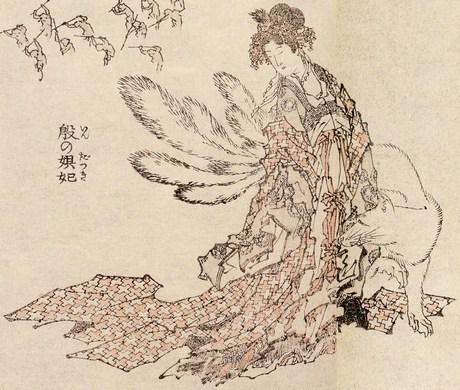
Daji, as depicted by Hokusai (wikimedia commons)
Daji requires some further discussion. She was initially regarded simply as a non-supernatural wicked concubine, but came to be treated as a fox posing as a human by the Song period. According to Xiaofei Kang the oldest evidence for that comes from 1101, from a Japanese text presumably reflecting an already extant Chinese belief. By the Yuan period it became a commonly accepted view, with Quanxiang Pinghua (全相平話) specifically stating Daji had nine tails. Her fox-like image was finally cemented fully by popular novels in the Ming and Qing periods.
Since there was a preexisting tradition in which Daji was a human woman, a remedy was developed: the “real” Daji was possessed by a fox, who took her name and identity. Curiously, the fox component of her story is otherwise not very important, and some modern authors basically characterize it as “tacked on”: she is the quintessential evil concubine bringing kingdoms to ruin out of a sense of cruelty who just happens to be a fox, and her story doesn’t really depend on preexisting fox-related motifs.
There are multiple accounts of Daji’s deeds, but the most famous one, and at the same time the most likely influence on Razan’s portrayal of her (and thus Tamamo), is Investiture of the Gods. However, he skips the origin attributed to her here: in the Chinese original, Daji is an agent of the goddess Nuwa, though she eventually overdoes it and is rebuked by her former boss for excessive cruelty. This doesn’t really fit well with Tamamo’s backstory, obviously; making her and Daji interchangeable was detrimental to both characters, I feel.
A Chinese story dealing with Daji reincarnating does exist, but it’s not exactly similar. In the Ming novel Zhaoyang Qushi (昭陽趣事) she reincarnated as Zhao Hede, a concubine of emperor Cheng of Han. What happens next has been described as “pornographic entertainment enlivened by supernatural and historical costumes”. For more details, check out Rania Huntington’s book from the bibliography below.
Curiously, it is possible Daji was simultaneously an object of active cult, since there is a Song imperial edict outlawing the shrines dedicated to her, Wutong (a southern Chinese spirit who was believed to bring wealth and bewitch people, compared with foxes in the north) and “General Shi” (no clue who that might be, I’d hazard a guess one of the popular pacified vengeful spirit cults but don’t quote me on that). However, another contemporary source instead mentions the outlawing of temples of “fox kings”, so it might also mean that the name of Daji was applied by officials to an unrelated popular fox cult (“fox king” is a reasonably common appellation for supernatural foxes). Both regular and nine-tailed foxes are attested in such a context across history.
Early nine-tailed foxes

An early Chinese depiction of a nine-tailed fox (wikimedia commons)
The early portrayals of nine-tailed foxes are something I started looking into recently because of Ran’s freshly revealed connection to Yuuma: I figured it makes sense that she’d be in origin someone who belongs to the same world as the taotie.
Looking at the earliest Chinese sources, multiple nine-tailed foxes appear in legends about virtuous rulers like Tang, Wen or Yu the Great, essentially as generic good omens, without much fanfare. According to confucian commentaries from the Later Han period, the nine tails were understood as a sign a given emperor will have many descendants. The exception from this generally positive tendency is the Classic of Mountains and Seas, where the nine-tailed fox is described as “man-eating” (something very uncommon in Chinese fox literature). However, it also doesn’t exactly get more spotlight than the other creatures. It’s also treated as a separate animal from regular foxes, not as a particularly old fox. You could say it is to the fox what a bai ze is to an ox, I think.
Visual arts add further specimens: the source of this discussion, the nine-tailed fox attendant of Xi Wangmu, later seemingly “decanonized”, and another belonging to the entourage of Zhong Kui. Both of these are hardly eminent and seem to fit the mold of auspicious omens. In Zhong Kui’s case the fox is in one case listed alongside the bai ze which only strengthens this impression. However, it also makes sense that its inclusion would reflect Zhong Kui’s role as a demon queller: he is often portrayed with conquered demons as servants, after all.
Conclusions

To sum up: ultimately it just doesn’t seem nine-tailed foxes are quite as big of a deal as popculture makes them seem, and nine tails are neither exclusive nor innate to Tamamo no Mae. Since that’s the only real point of connection between her and Ran save for a throwaway PCB line which leads to no further references, I maintain there’s no strong case for identifying them with each other, especially since there is no shortage of other candidates.
There’s also the fact that, Daji aside, most other nine-tailed foxes are largely blank slates you can do anything with, while Tamamo has many fairly unique characteristics which would be wasted by randomly slapping her name on Ran, in my opinion. To be fair, ZUN does occasionally make similar mistakes - Yoshika is the main example (remember, the actual legend about Yoshika’s immortality claims he decided to pursue eternal life after having a thrilling affair and has him call himself “strongest madman under heaven”).
I would personally argue ZUN himself probably did not feel strongly about who Ran is supposed to actually be when he originally came up with her, though. None of her spellcards reference Tamamo no Mae. Or any other fox identified with her, for that matter. They do have a more or less consistent theme, but that theme is, broadly speaking, “magic arts”, from onmyodo (Shikigami "Banquet of the Twelve General Gods"), through shugendo (Illusion God "Descent of Izuna-Gongen", Shikigami "The Protection of Zenki and Goki", Superhuman "Soaring En no Ozunu") and esoteric Buddhism (Shikigami "Channeling Dakiniten", Esoteric Sign "Odaishi-sama's Secret Key"), to contemporary stage magic (Shiki Brilliance "Princess Tenko -Illusion-"). In other words, I do not think canon actually strongly supports any specific option.
I will admit I’m biased but personally I think picking a different fox makes it much easier to accommodate Yuuma and their shared animal realm past, the most thrilling Ran development in ages. As for Tamamo, I do think she would be fun to see in Touhou, but preferably as her own character - with two tails, if possible.
Bibliography
Bernard Faure, The Power of Denial. Buddhism, Purity, and Gender
Rania Huntington, Alien Kind. Foxes and Late Imperial Chinese Narrative
Nobumi Iyanaga, Under the Shadow of the Great Śiva: Tantric Buddhism and its Influence on Japanese Mediaeval Culture
Idem, Dākinī in: Brill's Encyclopedia of Buddhism (vol. 2)
Xiaofei Kang, The Cult of the Fox: Power, Gender, and Popular Religion in Late Imperial and Modern China
Laura K. Nüffer, Lady Tamamo in: Keller Kimbrough and Haruo Shirane (eds.), Monsters, Animals, and Other Worlds. A Collection of Short Medieval Japanese Tales
Sumiko Sekiguchi, Gender in the Meiji Renovation: Confucian 'Lessons for Women' and the Making of Modern Japan
Chun-Yi Joyce Tsai, Imagining the Supernatural Grotesque: Paintings of Zhong Kui and Demons in the Late Southern Song (1127-1279) and Yuan (1271-1368) Dynasties
34 notes
·
View notes
Text
Mai, Satono and their peers: a look into the world of dōji

Okay, look, I get it, Mai and Satono are not the most thrilling characters. I suspect they would be at the very bottom of the list of stage 5 bosses people would like to see expanded upon. Perhaps they are not the optimal pick for another research deep dive. However, I would nonetheless like to try to convince you they should not be ignored altogether. If you are not convinced, this article has it all: esoteric Buddhism, accusations of heresy, liver eating, and even alleged innuendos.
As a bonus, I will also discuss a few other famous Buddhist attendant deities more or less directly tied to Touhou. Among other things, you will learn which figure technically tied to the plot of UFO is missing from its cast and what a controversial claim about a certain deity being a teenage form of Amaterasu has to do with Akyuu.
Mai, Satono and the grand Matarajin callout of 1698

An Edo period depiction of Matarajin and his attendants (via Bernard Faure's Protectors and Predators; reproduced here for educational purposes only)
As indicated both by their family names and their designs, Mai and Satono are based on Nishita Dōji (爾子多童子) and Chōreita Dōji (丁令多童子), respectively. These two deities are commonly depicted alongside Matarajin, acting as his attendants, or dōji. Nishita is depicted holding bamboo leaves and dancing, while Chōreita - playing a drum and holding ginger leaves. ZUN kept the plant attributes, though he clearly passed on the drum. In the HSiFS interview in SCoOW he said he initially wanted both of them to hold both types of leaves at once, so I presume that’s when the decision to skip the instrument has originally been made.
We do not actually fully know how Nishita and Chōreita initially developed. It is possible that their emergence was a part of a broader process of overhauling Matarajin’s iconography. While initially imagined as a fearsome multi-armed and multi-headed wrathful deity, with time he took the form of an old man dressed like a noble and came to be associated with fate and performing arts. The conventional depictions, with the attendants dancing while Matarajin plays a drum under the Big Dipper, neatly convey both of these roles. The group was additionally responsible for revealing the three paths (defilements, karma, and suffering) and three poisons (greed, hatred, and desire) to devotees.
In addition to being a mainstay of Matarajin’s iconography, Ninshita and Chōreita also had a role to play in a special ceremony focused on their master, genshi kimyōdan (玄旨帰命壇). This term is derived from the names of two separate Tendai initiation rituals, genshidan (玄旨壇) and kimyōdan (帰命壇).
Genshi kimyōdan can actually be considered the reason why Matarajin is relatively obscure today. In 1698, the rites were outlawed during a campaign meant to reform the Tendai school. It was lead by the monk Reiku (霊空), who compiled his opinions about various rituals in Hekijahen (闢邪篇, loosely “Repudiation of Heresies”). Matarajin is not directly mentioned there, and the polemic with genshi kimyōdan is instead focused on a set of thirteen kōan pertaining to it, with mistakes pointed out for each of them. Evidently this was pretty successful at curbing his prominence anyway, though.
By the 1720s, even members of Tendai clergy could be somewhat puzzled after stumbling upon references to Matarajin, and in a text from 1782 we can read that he was a “false icon created by the stupidest of stupid folks“. He ceased to be venerated on Mount Hiei, the center of the Tendai tradition, though he did not fade away entirely thanks to various more peripheral temples, for example in Hiraizumi in the north. Ironically, this decline is very likely why Matarajin survived the period of shinbutsu bunri policies largely unscathed when compared to some of his peers like Gozu Tennō.
“Nine out of ten Shingon masters believe this”, or the background of the Matarajin callout

Dakiniten (Metropolitan Museum of Art)
Tendai reformers and critics associated genshi kimyōdan with an (in)famous Shingon current supposedly linked with Dakiniten, Tachikawa-ryū. This is a complex issue in itself, and would frankly warrant a lengthy essay itself if I wanted to do it justice; the most prominent researcher focused on it, Nobumi Iyanaga, said himself that “it is challenging to write about the Tachikawa-ryū in brief, because almost all of what has ever been written on this topic is based on a preconceived image and is in need of profound revision”. I will nonetheless try to give you a crash course.
Recent reexaminations indicate that originally Tachikawa-ryū might have been simply a combination of Shingon with Onmyōdō and local practices typical for - at the time deeply peripheral - Musashi Province. Essentially, it was an ultimately unremarkable minor lineage extant in the 12th and 13th centuries. A likely contemporary treatise, Haja Kenshō Shū (破邪顕正集; “Collection for Refuting the Perverse and Manifesting the Correct”) indicates it was met with at best mixed reception among religious elites elsewhere, but that probably boils down to its peripheral character.
Starting with Yūkai (宥快; 1345–1416) Shingon authors, and later others as well, came to employ Tachikawa-ryū as a boogeyman in doctrinal arguments, though. Anything “heretical” (or anything a given author had a personal beef with) could be Tachikawa-ryū, essentially. It was particularly often treated as interchangeable with a set of deeply enigmatic scrolls, referred to simply as “this teaching, that teaching” (kono hō, kano hō, 此の法, 彼の法; I am not making this up, I am quoting Iyanaga); I will refer to it as TTTT through the rest of the article.
These two were mixed up because of the monk Shinjō (心定; 1215-1272) who expressed suspicion about TTTT because of its alleged popularity in the countryside, where “nine out of ten Shingon masters in the countryside” believe it to be the most genuine form of esoteric Buddhism. However, he stresses TTTT was not only non-Buddhist, but in fact demonic. The description of this so-called “abominable skull honzon”, “skull ritual” or, to stick to the original wording, “a certain ritual” (彼ノ法, ka no hō) meant to prove the accusations is, to put it lightly, quite something.
Essentially, the male practitioner of TTTT has to have sex with a woman, then smear a skull with bodily fluids generated this way over and over again, and finally keep it in warmth for seven years so that it can acquire prophetic powers. This works because dakinis (a class of demons) live inside the skull. The entire process takes eight years because Dakiniten, the #1 dakini, attained enlightenment at the age of 8.
Shinjō himself did not assert TTTT was identical with Tachikawa-ryū, though - he merely claimed that at one point he found a bag of texts which contained sources pertaining to both of them.
Ultimately it’s not even certain if TTTT is real. It might be an entirely literary creation, or an embellishment of some genuine tradition circulating around some marginal group like traveling ascetics. We will likely never know for sure.
Regardless of that, Tachikawa-ryū became synonymous not just with incorrect teachings, but specifically with teachings with inappropriate sexual elements. By extension, it was alleged that the songs and dances associated with Matarajin and his two servants performed during genshi kimyōdan similarly had inappropriate sexual undertones.
ZUN seems to be aware of these implications, since the topic came up in the aforementioned interview. The interviewer states they read that “during the middle ages a lot of Tendai and Shingon sects end up becoming obsessed with sexual rituals and wicked teachings, leading to their downfall” (bit of an overstatement). In response, ZUN explains that these matters are “interesting” and adds that he “did prepare some materials with that, but that would make [the game] too vulgar.” No dialogue or spell card in the game actually references genshi kimyōdan, for what it’s worth, but seeing as this is the only real point of connection between Matarajin and such accusations it’s safe to say ZUN is to some degree familiar with the discussed matter.
As in the case of the Tachikawa-ryū, modern researchers are often skeptical if there really was a sexual, orgiastic component to the rituals, though. A major problem with proper evaluation is that very few actual primary sources survive. We know the words of the songs associated with Matarajin’s dōji, but they are not very helpful. They’re borderline gibberish, “shishirishi ni shishiri” alternating with “sosoroso ni sosoro”. Polemics present them either as an allusion to sex or as an invitation to it; as cryptic references to genitals; or as sounds of pleasure.
None of these claims find any support in the few surviving primary sources, though. Earlier texts indicate that the dance and song of the dōji was understood as a representation of endless transmigration during the cycle of samsara. When sex does come up in related sources, it is presented negatively, in association with ignorance. Bernard Faure argues that the rituals were initially apotropaic, much like the tengu odoshi (天狗怖し), which I plan to cover next month since it helps a lot with understanding what’s going on in HSiFS. The goal was seemingly to guarantee Matarajin will help the faithful be reborn in the pure land of Amida. However, the method he was believed to utilize to that end can be at best described as unconventional.
To unburden the soul from bad karma, Matarajin had to devour the liver of a dying person. This is essentially a positive twist on a habit attributed in Buddhism to certain classes of demons, especially dakinis, said to hunger for so-called “human yellow” (人黄, ninnō), to be understood as something like vital essence, or for specific body parts. In this highly esoteric context, Matarajin was at once himself a sort of dakini, and a tamer of them (usually the role of Mahakala), and thus capable of utilizing their normally dreadful behavior to positive ends.
The true understanding of these actions was knowledge apparently reserved for a small audience, though. Keiran shūyōshū (溪嵐拾葉集), a medieval compendium of orally transmitted Tendai knowledge, asserts that even monks actively involved in the worship of Matarajin were unfamiliar with it.
Beyond Mai and Satono: dōji as a class of deities
You might be wondering why an article which was supposed to be an explanation of Mai and Satono ended up spending so much time on ambivalent aspects of Matarajin’s character instead. The ambivalence present in the aforementioned liver-related belief was a fundamental component of the character of many deities once popular in esoteric Buddhism, and by extension of their attendants too. Therefore, it is actually key to understanding dōji.
As I already mentioned in my Shuten Dōji article a few weeks ago, when treated as a type of supernatural beings, the term dōji implies a degree of ambiguity. The youthfulness of these “lads” means that in most cases they were portrayed as unpredictable, impulsive, eager to subvert social order and hierarchies of power, and prone to hubris. Some of them are outright demonic figures, as already discussed last month. Simply put, they possess the stereotypical traits of a young person from the perspective of someone old. They initially seemingly developed as a Buddhist reflection of Taoist tongzi, in this context a symbol of immortality and youthfulness, though a case can be made that youthful Hindu deities like Skanda (Idaten) also had an influence on this process.
Many Buddhist deities can be accompanied by pairs or groups of dōji, for example Jizō, Kannon, Fudō, Dakiniten or Sendan Kendatsuba-ō. In some cases, other deities could manifest in the form of dōji. In Chiba there is a statue of Myōken reflecting such a tradition, for example. There are also “independent” dōji. Closely related terms include ōji (王子), “prince”, used to refer for example to the sons of Gozu Tennō and the attendants of Iizuna Gongen, and wakamiya (若宮), “young prince”, which typially designates the youthful manifestation of a local deity.In the second half of the article, I’ll describe some notable dōji who can be considered relevant to Touhou in some capacity.
Gohō dōji: the generic dōji and the legend of Myōren

A gohō dōji in the Shigisan Engi Emaki (wikimedia commons)
The term gohō dōji (護法童子) can be translated as something like “dharma-protecting lad”. It’s not the name of a specific dōji, but rather a subcategory of them. Historically they were understood as something like the Buddhist analog of shikigami. The term gohō itself has a broader meaning, and can refer to virtually any protective Buddhist deity, even wisdom kings or the four heavenly kings. The archetypal example of such a figure is Kongōshu (Vajrapāṇi), who according to Buddhist tradition acts as a protector of the historical Buddha.
A good example of a Gohō Dōji is Oto Gohō (乙護法) from Mount Sefuri. He reportedly appeared before the priest Shōkū (性空; 910–1007) before his journey to China, and protected him through its entire duration. Afterwards a temple was built for him. Curiously, this legend actually finds a close parallel in these pertaining to Matarajin, Sekizan Myōjin or Shinra Myōjin protecting monks traveling to China - except the deity involved is a youth rather than an old man.
From a Touhou point of view, the most important example of a gohō dōji is arguably this nameless one, though. He appears in the Shigisan Engi Emaki, an account of the miraculous deeds of the monk Myōren, who you doubtlessly know from UFO. The section focused on him is fairly straightforward: a messenger from the imperial court approaches Myōren because the emperor is sick. Using his supernatural powers, he summons a deity clad in a cape made out of swords to heal him without having to leave his dwelling on Mount Shigi himself. He obviously succeeds. Afterwards the court sends a messenger to offer Myōren various rewards, but he rejects them. While the emperor is not directly shown or named, he is presumably to be identified as Daigo.
While the supernatural helper is left unnamed and is often simply described as a gohō dōji in scholarship, it has been pointed out that his unusual iconography seems to be a variant of that associated with the fifth of the twenty eight messengers of Bishamonten. A depiction of a similar figure is known for example from the Ninna-ji temple in Kyoto. This makes perfect sense, seeing as the connection between Myōren and this deity is well documented, and recurs through the legends presented in the Shigisan Engi Emaki. Needless to say, it is also the reason why Bishamonten by proxy plays a role in the plot of UFO. Given these fairly direct references, I am actually surprised no UFO character borrows any visual cues from the gohō dōji, seeing as the illustration is quite famous. It was even featured on a stamp at one point.
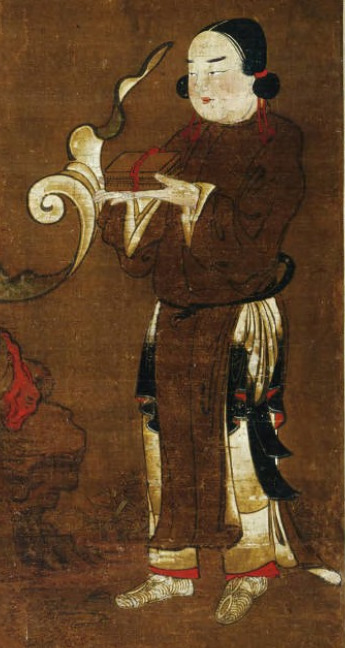
Zennishi Dōji (Princeton University Art Museum; reproduced here for educational purposes only)
Yoshiaki Shimizu has suggested that the connection between Myōren and his Gohō Dōji is meant to mirror that between Bishamonten and his son and primary attendant, Zennishi Dōji (善膩師童子), and highlight that the monk was an incarnation of the deity he worshiped. He also argued that Myōren’s nameless sister (not attested outside Shigisan Engi Emaki) - the character ZUN based Byakuren on - is meant to correspond to Bishamonten’s wife, Kisshōten/Kichijōten (presumably with spousal bond turned into a sibling one). I am not sure if this proposal found broader support, though - I’m personally skeptical.
Kongara Dōji (and Seitaka Dōji): almost Touhou
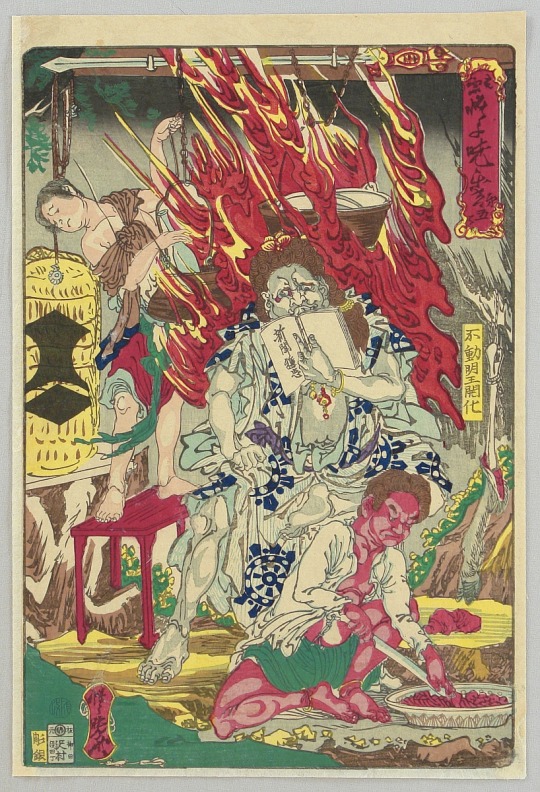
Fudō Myōō, as depicted by Kyōsai (via ukiyo-e.org; reproduced here for educational purposes only)
Kongara Dōji (衿羯羅童子, from Sanskrit Kiṃkara) and Seitaka Dōji (制多迦童子, from Sanskrit Ceṭaka) are arguably uniquely important as far as the divine dōji go - a case can be made that they were the model for the other similar pairs. They are regarded as attendants of Fudō Myōō (Acala), one of the “wisdom kings”, a class of wrathful deities originally regarded as personifications and protectors of a specific mantra or dhāraṇī. In Japanese esoteric Buddhism, they are understood as manifestations of Buddhas responsible for subjugating beings who do not embrace Buddhist teachings.
Acting as Fudō‘s servants is the primary role of Kongara and Seitaka. As a matter of fact, both of their names are derived from Sanskrit terms referring to servitude. This is not reflected in their behavior fully: esoteric Buddhist sources indicate that Kongara is guaranteed to help a devotee who would implore him for help, but Seitaka is likely to disobey such a person. Interestingly, both can be recognized as manifestations of Fudō. This seems to reflect a broader pattern: once a deity ascended to a prominent position in esoteric Buddhism, some of their functions could be reassigned to members of their entourage. ZUN arguably references this in Mai and Satono’s bio, according to which “their abilities (...) are nothing more than an extension of Okina's.”
Despite the aforementioned shared aspect of their nature, Kongara and Seitaka actually have completely different iconographies. Kongara is portrayed with pale skin, wearing a monastic robe (kesa) and with his hands typically joined in a gesture of respect. Seitaka, meanwhile, has red skin, and holds a vajra in his left hand and a staff in the right. His characteristic five tufts of hair are a hairdo historically associated with people who were sentenced to banishment or enslavement. He’s never portrayed wearing a kesa in order to stress that in contrast with his “coworker” he possesses an evil nature. It has been argued the fundamental ambivalence of dōji is behind this difference in temperaments.
While the pair consisting of Kongara and Seitaka represents the most common version of Fudō’s entourage, he could also be portrayed alongside eight (a Chinese tradition) or uncommonly thirty six attendants. The core two are always present no matter how many extra dōji are present, though. Appearing together is essentially their core trait, and probably is part of the reason why they could be identified with other duos of supernatural servants, like En no Gyōja’s attendants Zenki and Gōki (who as you may know are referenced in Touhou in one of Ran’s PCB spell cards, and in a variety of print works).
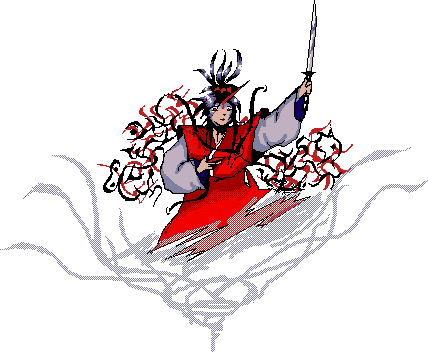
As for the Touhou relevance of Kongara and Seitaka, a character very obviously named after the former appeared all the way back in Highly Responsive to Prayers, but I will admit I am personally skeptical if this can be considered an actual case of adaptation of a religious figure. There are no iconographic similarities between them, and their roles to put it lightly also don't seem particularly similar. Much like the PC-98 use of the term makai (which I will cover next month), it just seems like a random choice.
At least back in the day there was a fanon trend of treating the HRtP Konngara as an oni and a fourth deva of the mountain, but I will admit I never quite got that one. In contrast with Yuugi and Kasen’s counterparts, Kongara's namesake actually doesn’t have anything to do with Shuten Dōji.
The less said about a nonsensical comment on the wiki asserting Kongara’s status as a yaksha (something I have not seen referenced outside of Touhou headcanons, mostly from the reddit/tvtropes side of the fandom) explains why his supposed Touhou counterpart is present in hell, the better.
Uhō Dōji: my life as a teenage Amaterasu protector of gumonji practitioners

Uhō Dōji (Metropolitan Museum of Art)
Uhō Dōji (雨宝童子), “rain treasure child”, will be the last dōji to be discussed here due to being by far the single most unusual member of this category. Following most authors, I described Uhō Dōji as a male figure through the article, but as noted by Anna Andreeva, most depictions are fairly androgynous. Bernard Faure points out sources which seem to refer to Uhō Dōji as female exist too; this is why I went with a gender neutral translation of dōji. In any case, the iconography is fairly consistent, as documented already in the Heian period: youthful face, long hair, wish-fulfilling jewel in one hand, decorated staff in the other, plus somewhat unconventional headwear, namely a five-wheeled stupa (gorintō).
Originally Uhō Dōji was simply a guardian deity of Mount Asama. He is closely associated with Kongōshō-ji, dedicated to the bodhisattva Kokūzō. The latter is locally depicted with Uhō Dōji and Myōjō Tenshi (明星天子), a personification of Venus, as his attendants.Originally the temple was associated with the Shingon school of Buddhism, though today it instead belongs to the Rinzai lineage of Zen.
A legend from the Muromachi period states that Kongōshō-ji was originally established in the sixth century, during the reign of emperor Kinmei by a monk named Kyōtai Shōnin (暁台上人).The latter initially created a place for himself to perform a ritual popularly known as gumonji (properly Gumonji-hō, 求聞持法, “inquiring and retaining [in one’s mind]”).The name Kongōshōji was only given to it later when Kūkai, the founder of the Shingon school of Buddhism (from whose traditions gumonji originates), received two visions - one from a dōji and then another from Amaterasu - that a place suitable to perform gumonji exists on Mount Asama. After arriving there, he stumbled upon the ruins of Kyōtai Shōnin’s temple, so he had it rebuilt and renamed it. Subsequently, Amaterasu appointed Uhō Dōji to the position of the protector of both this location and Buddhist devotees partaking in gumonji in general.
Most of you probably know that gumonji pops up in Touhou as the name of Akyuu’s ability in Perfect Memento in Strict Sense. ZUN describes it simply as perfect memory, but in reality it’s an esoteric religious practice focused on chanting the mantra of Kokūzō 1000000 times over the course of a set period of time (either 100 or 50 days). The goal is to develop perfect memory in order to be able to memorize all Shingon texts, though it is also believed to increase merit and grant prosperity in general. The oldest references to it come from the eighth century, and based on press coverage it is still performed today.
ZUN actually never mentioned gumonji in a context which would stress the term’s Buddhist character. In Forbidden Scrollery Akyuu prays to Iwanagahime rather than to any Buddhist figures. I get the idea behind that, but I will admit I liked the portrayal of her religious activities in Ashiyama’s Gensokyo of Humans much more.

Gumonji aside, the second major point of interest is the connection between Uhō Dōji and Amaterasu. In the legend I’ve summarized above, they are obviously two separate figures, with one taking a subordinate position. This changed later on, though. At some point, most likely between 1419 and 1428, the two deities came to be conflated. As Bernard Faure put it, Uhō Dōji effectively came to be seen as the “Buddhist version of Amaterasu”. To be specific, as Amaterasu at the age of sixteen, presumably to account for the fact that a dōji would by default be a youthful figure.
The treatise Uhō Dōji Keibyaku goes further and asserts that that Uhō Dōji manifests in India as the historical Buddha, Amida and Dainichi; in China as Fuxi, Shennong and Huang Di; and in Japan as Amaterasu, Tsukuyomi and Ninigi. In his astral role, he represents the planet Venus, but he can also manifest as Dakiniten and Benzaiten, in this context understood as respectively lunar and solar. He is also the creator of all of these astral bodies.
The grandiose claims about Uhō Dōji, Amaterasu and other major figures were not exactly uncontroversial. It seems that especially in the eighteenth century the Ise clergy objected to them, presumably because they effectively amounted to their peers at Kongōshō-ji promoting their own deity to make the temple more important as a part of the Ise pilgrimage, which at the time enjoyed considerable popularity.
The association between Amaterasu and Uhō Dōji nonetheless persisted through the Edo period, and despite protests voiced at Ise among laypeople Mount Asama was widely recognized as the third most important destination for participants in the Ise pilgrimage, next to the outer and inner shrines at Ise themselves. It is also quite likely that there was no shortage of people who would imagine Amaterasu looking just like Uhō Dōji.
Ultimately the Uhō Dōji controversy was just one of the many chapters in Amaterasu’s long and complex history, and there was nothing particularly unusual about the claims made. There were quite literally dozens of Buddhist or at least Buddhist-adjacent figures she developed connections to (Bonten, Enma and Mara, to name but a few), and the Ise clergy took active part in this process. Buddhist reinterpretations of Amaterasu flourished especially through the Japanese middle ages.
It was only the era of Meiji reforms that brought the end to this, cementing the Kojiki and Nihon Shoki inspired vision of Amaterasu as the only appropriate one. However, this is beyond the scope of this article. Worry not, though: the very next one I’m working on will cover these matters in detail. Please look forward to it.
Bibliography
Anna Andreeva, “To Overcome the Tyranny of Time”: Stars, Buddhas, and the Arts of Perfect Memory at Mt. Asama
Talia J. Andrei, The Elderly Nun, the Rain-Treasure Child, and the Wish-Fulfilling Jewel: Visualizing Buddhist Networks at the Grand Shrine of Ise
William M. Bodiford, Matara: A Dream King Between Insight and Imagination
Bernard Faure, The Fluid Pantheon (Gods of Medieval Japan vol. 1)
Idem, Protectors and Predators (Gods of Medieval Japan vol. 2)
Idem, Rage and Ravage (Gods of Medieval Japan vol. 3)
Nobumi Iyanaga, Tachikawa-ryū in: Esoteric Buddhism and the Tantras in East Asia
Gaétan Rappo, Heresy and Liminality in Shingon Buddhism: Deciphering a 15th Century Treatise on Right and Wrong
Idem, “Deviant Teachings”. The Tachikawa Lineage as a Moving Concept in Japanese Buddhism
Yoshiaki Shimizu, The "Shigisan-engi" Scrolls, c. 1175
106 notes
·
View notes
Text

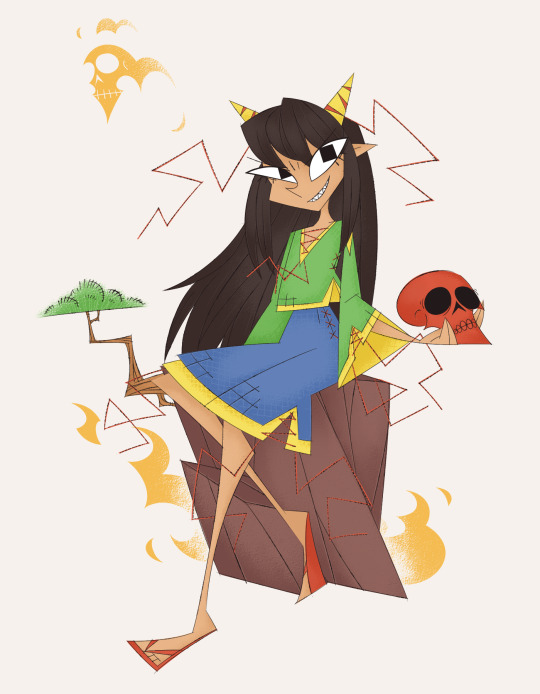
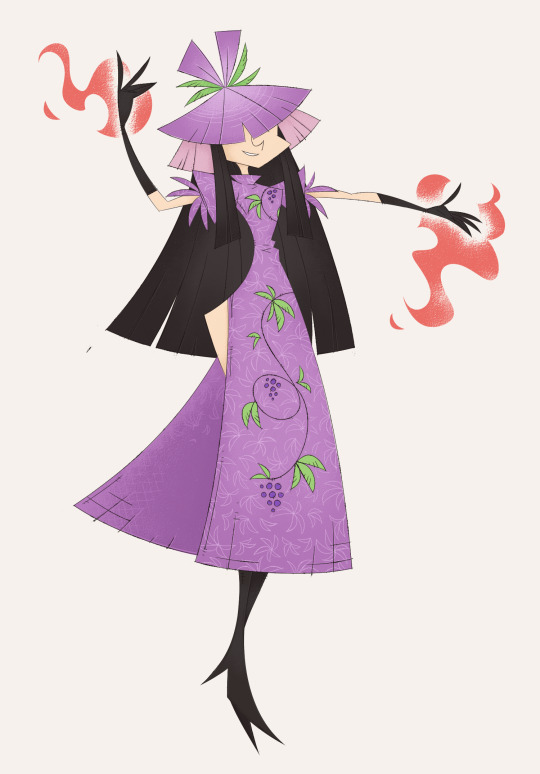
Zanmu Nippaku and Hisami Yomotsu, favorites of mine from Touhou 19.
317 notes
·
View notes
Text

Another take on my favorite Touhou character Joon Yorigami.
261 notes
·
View notes